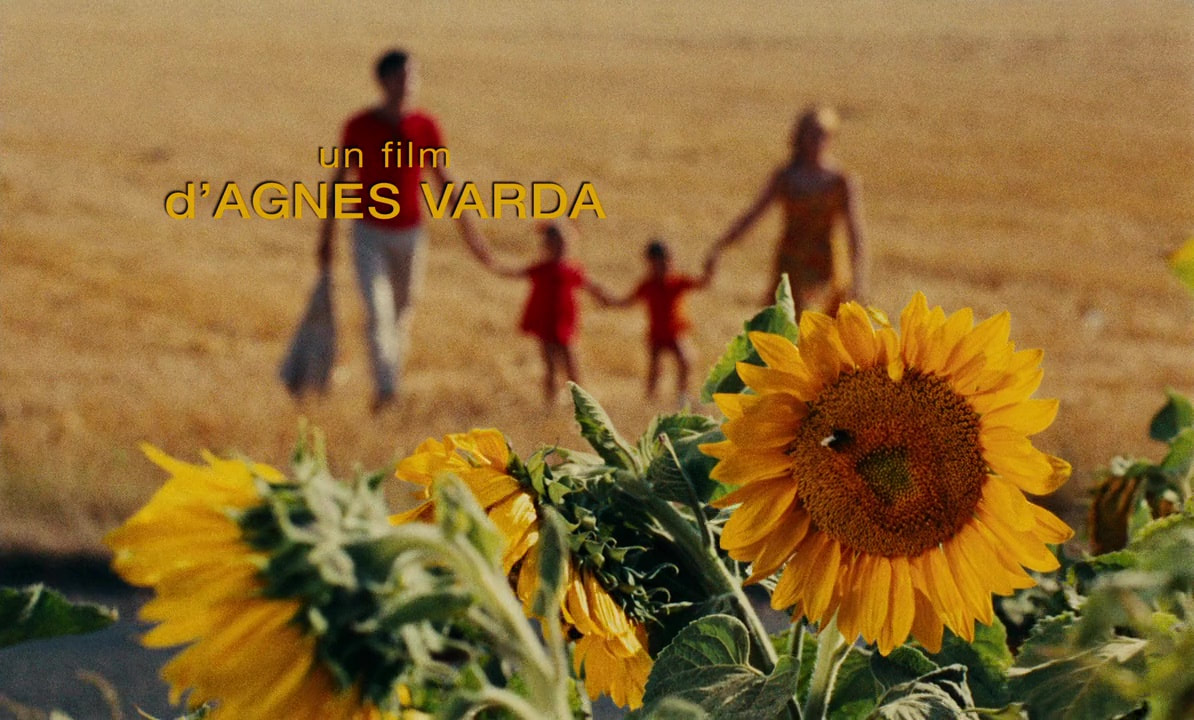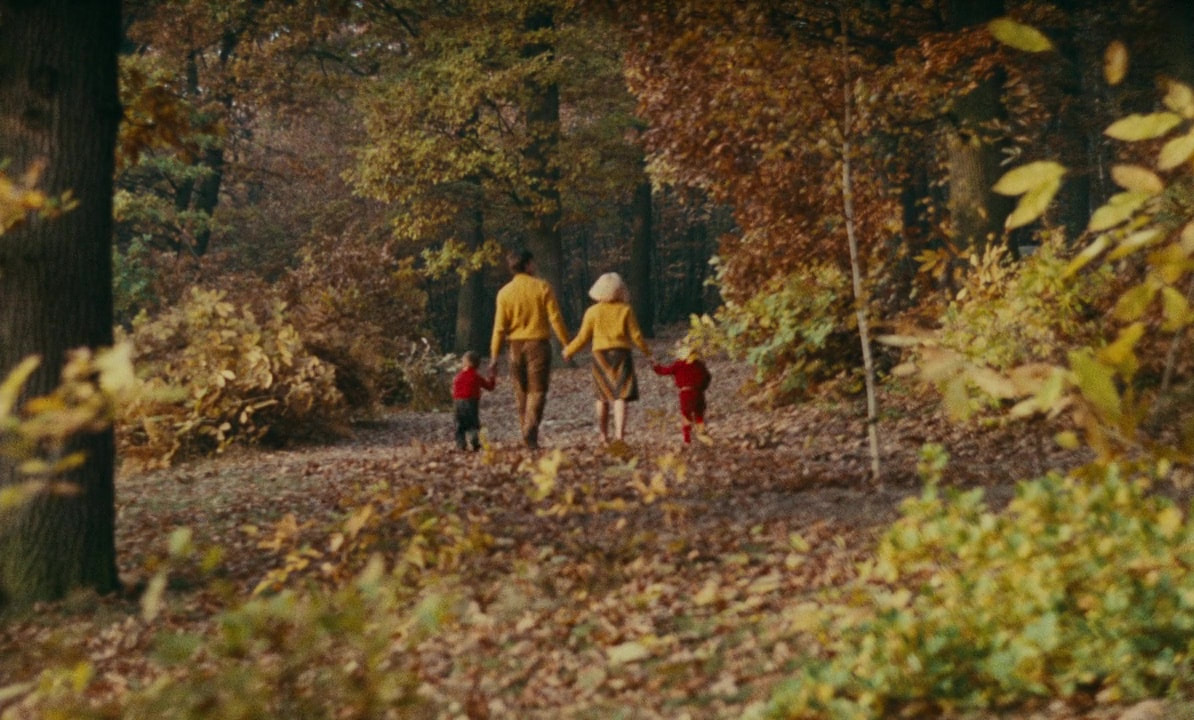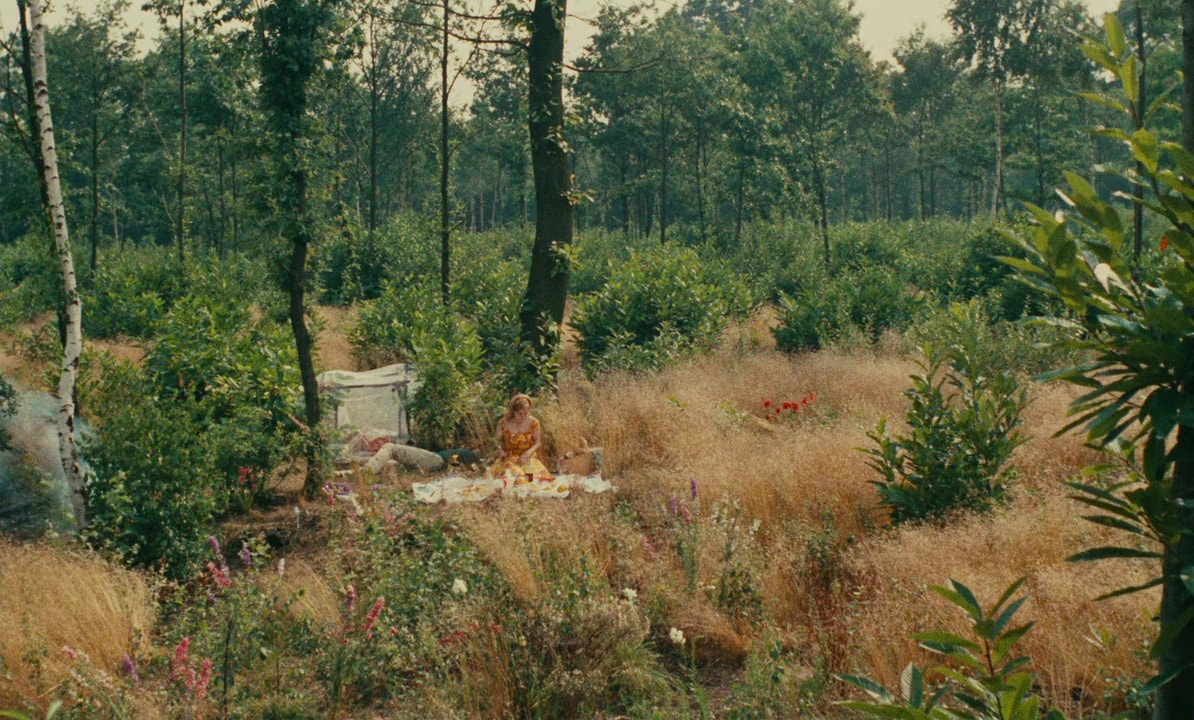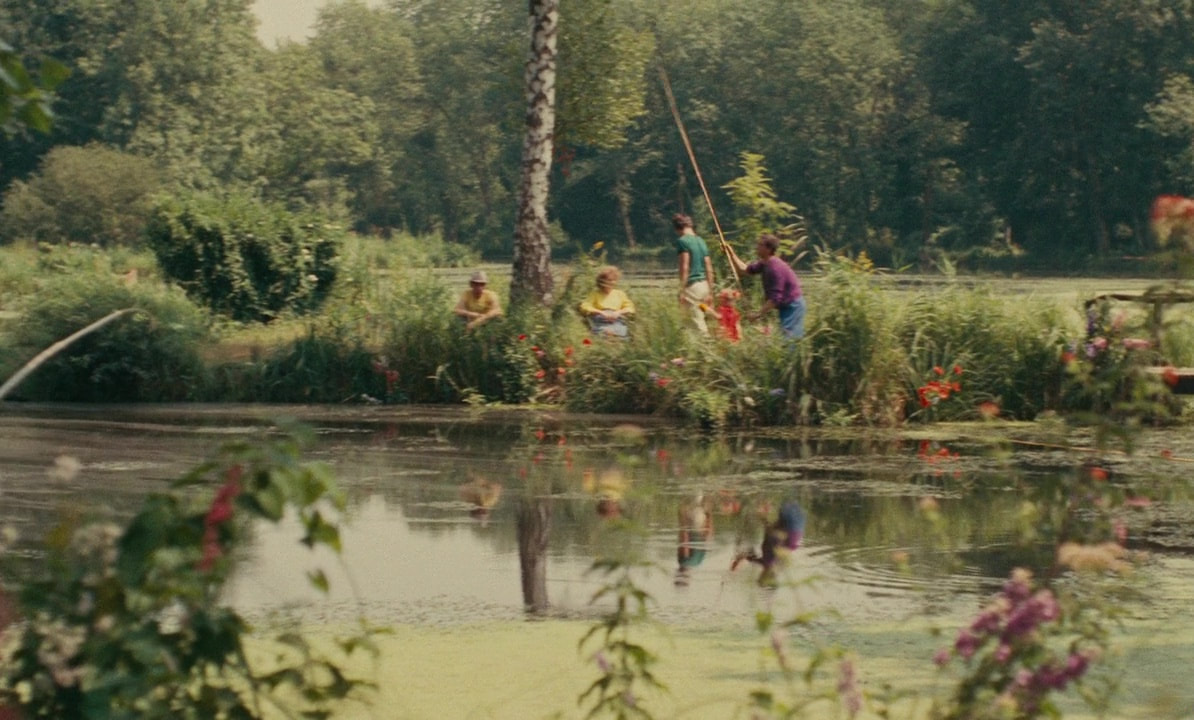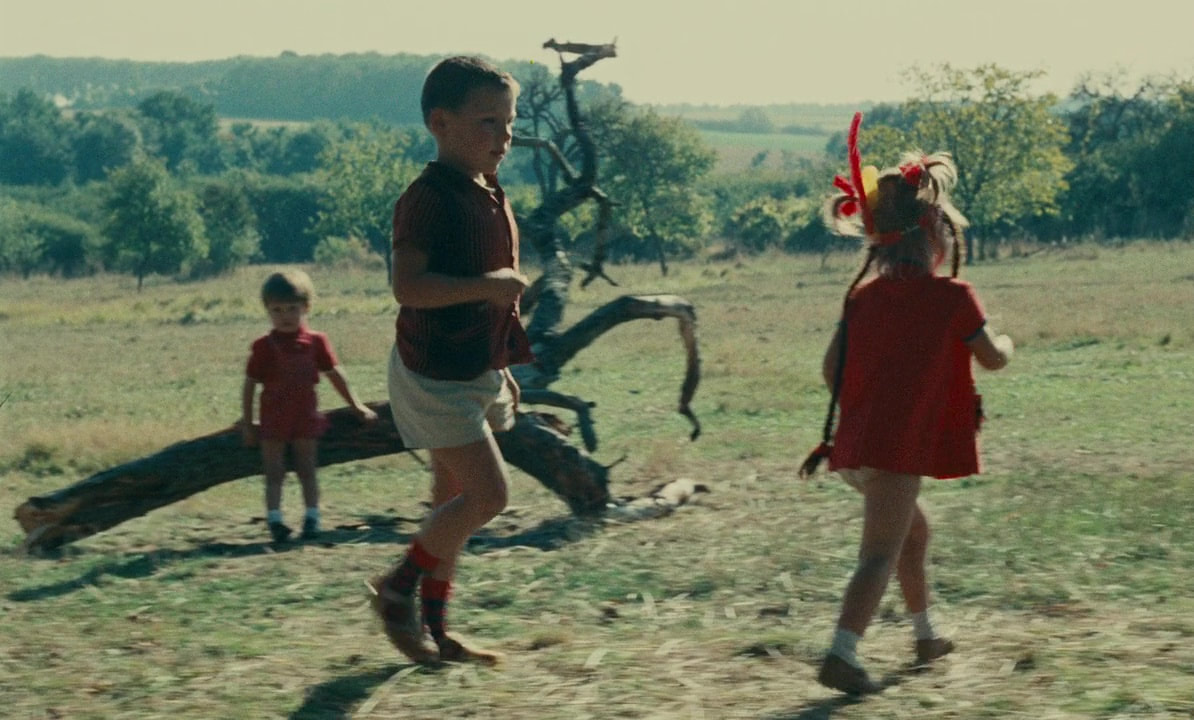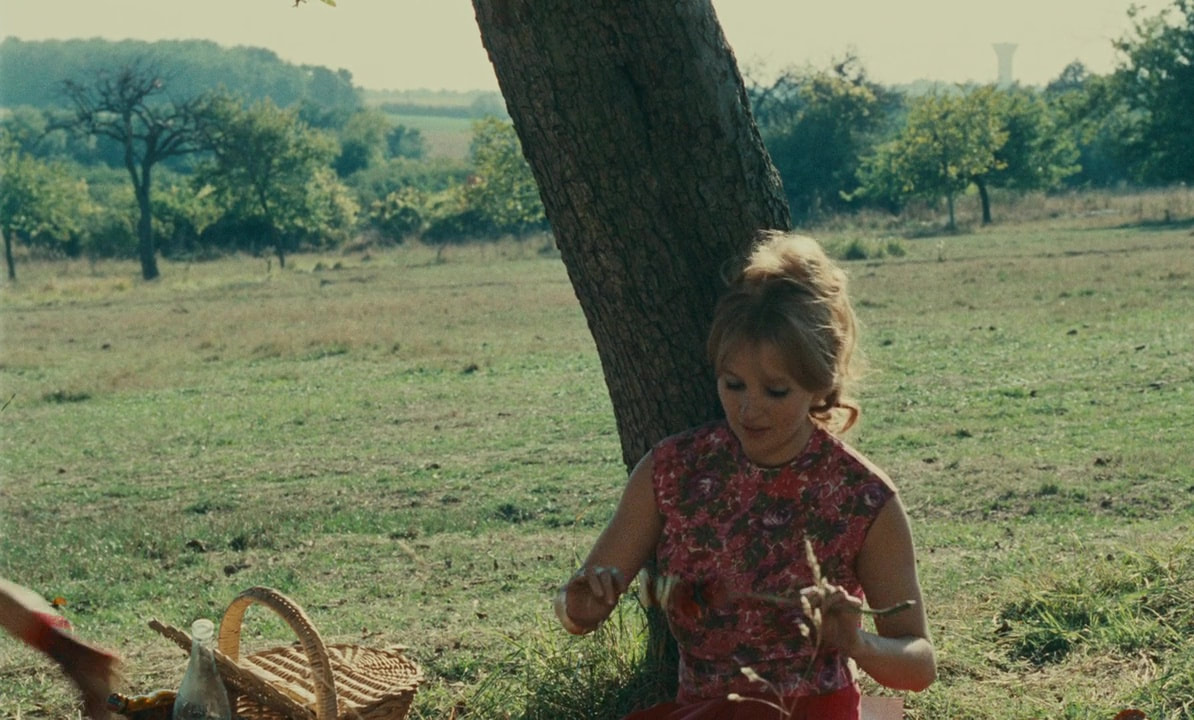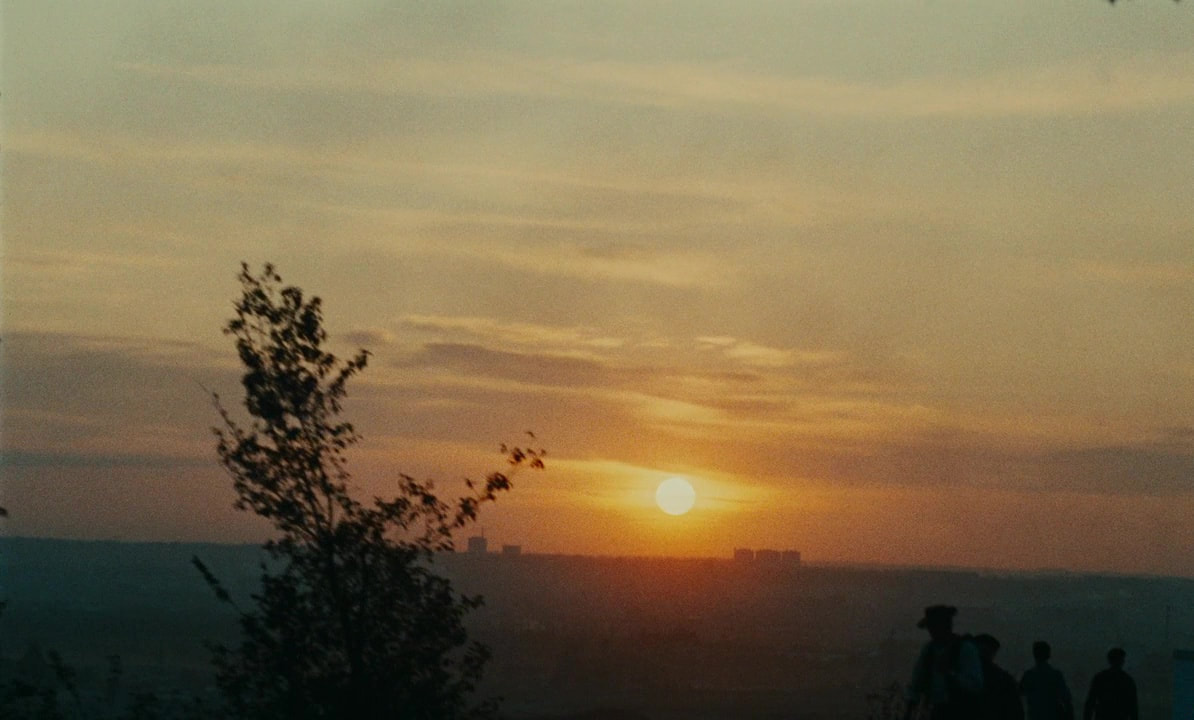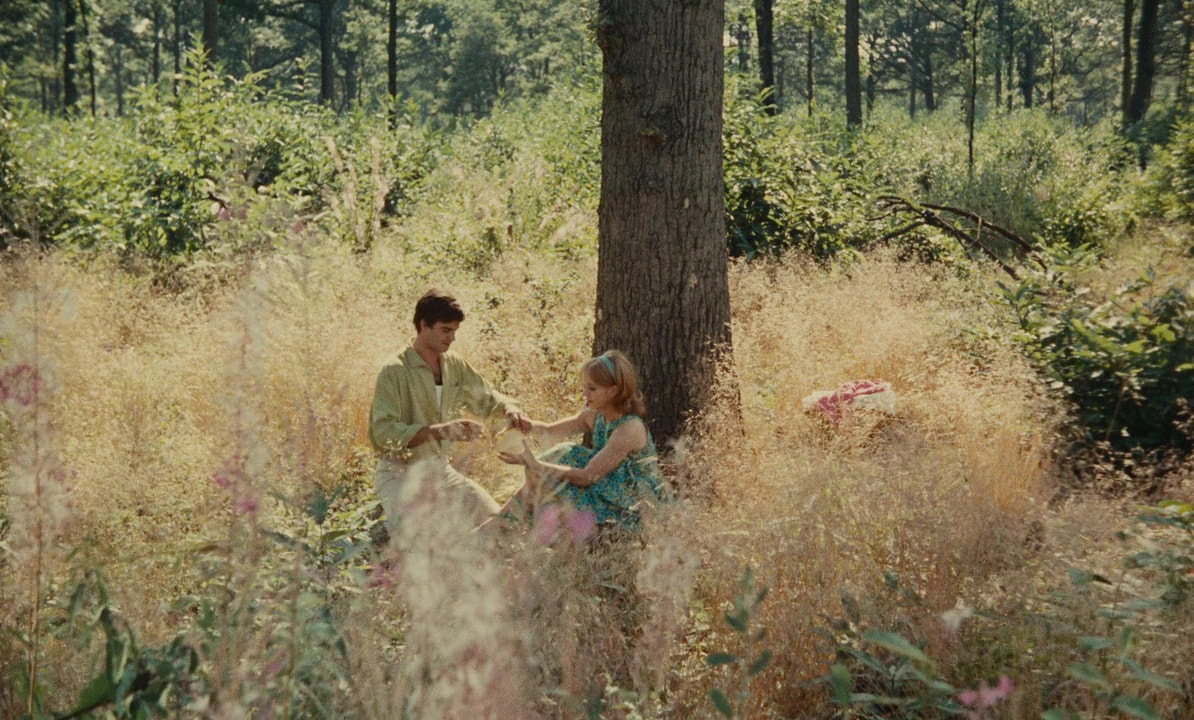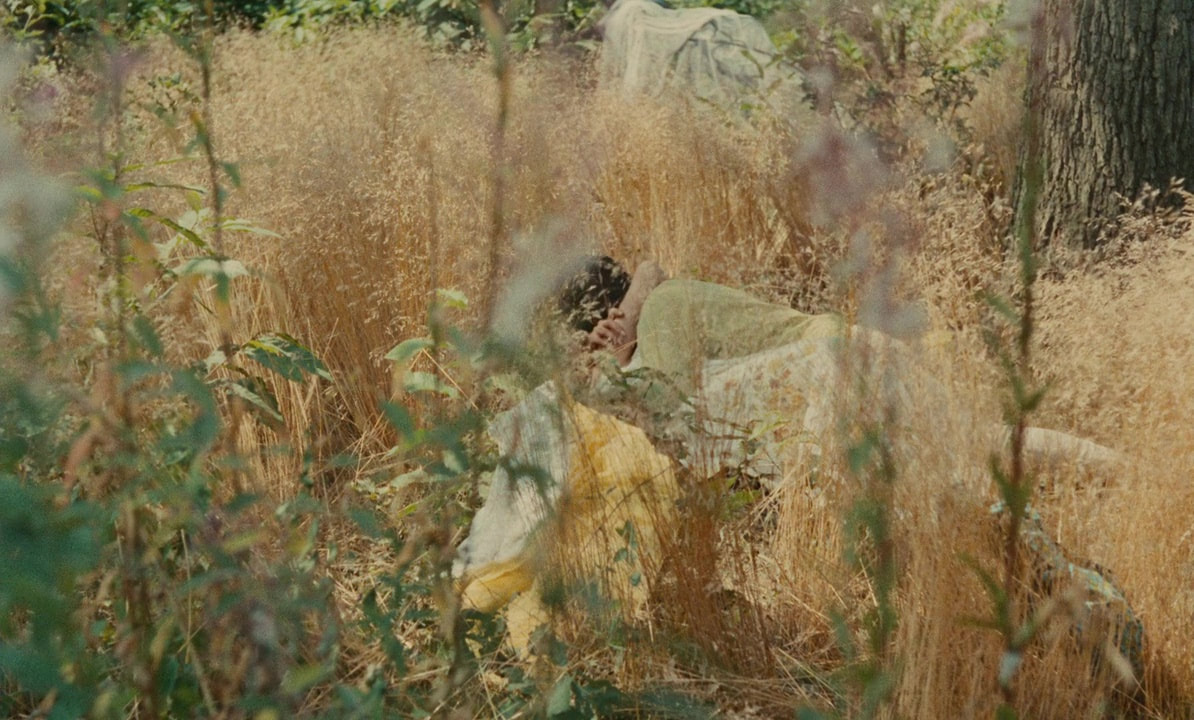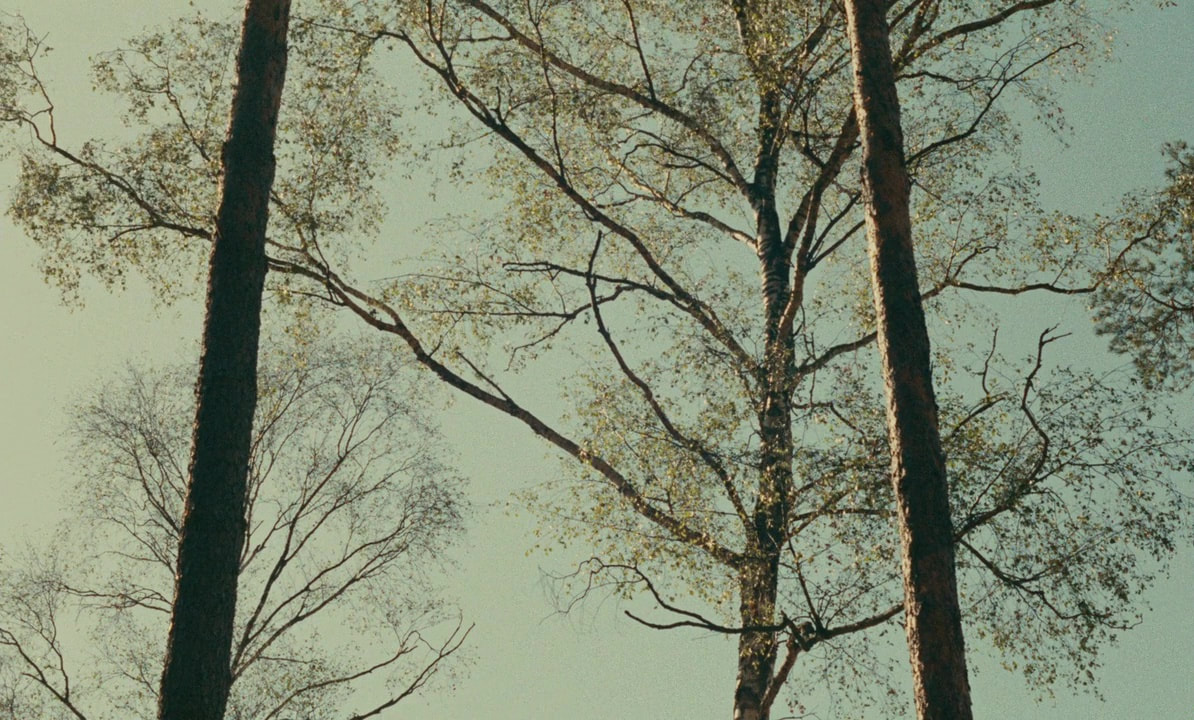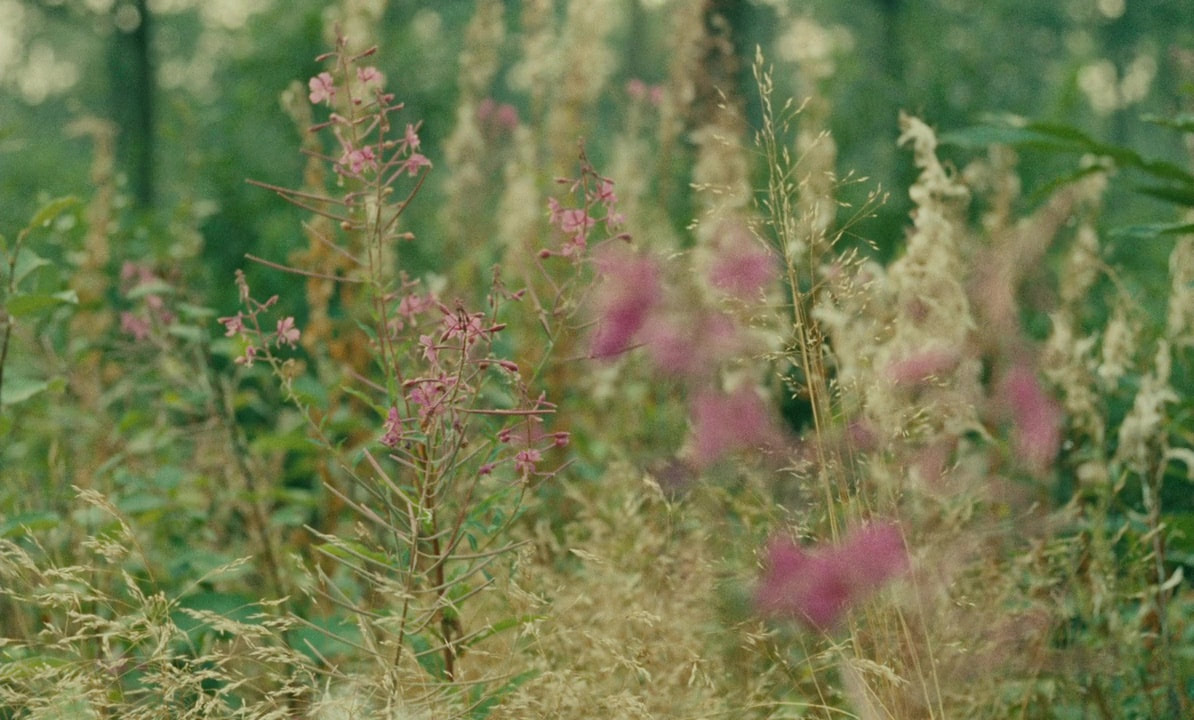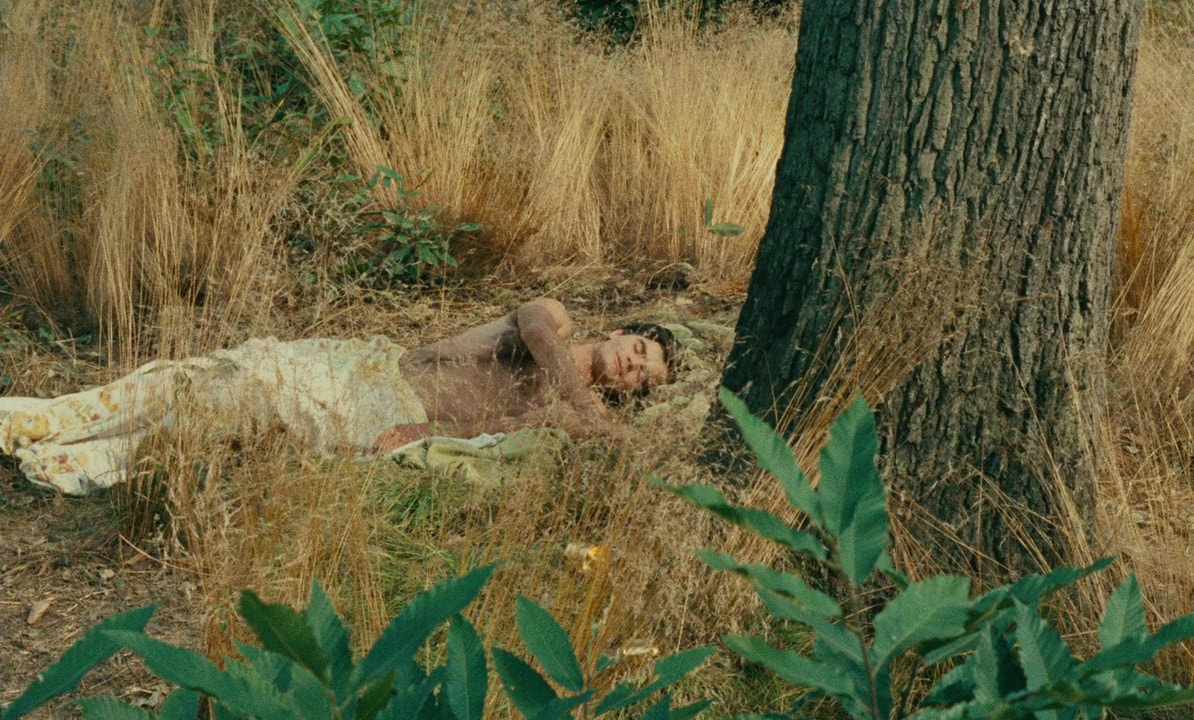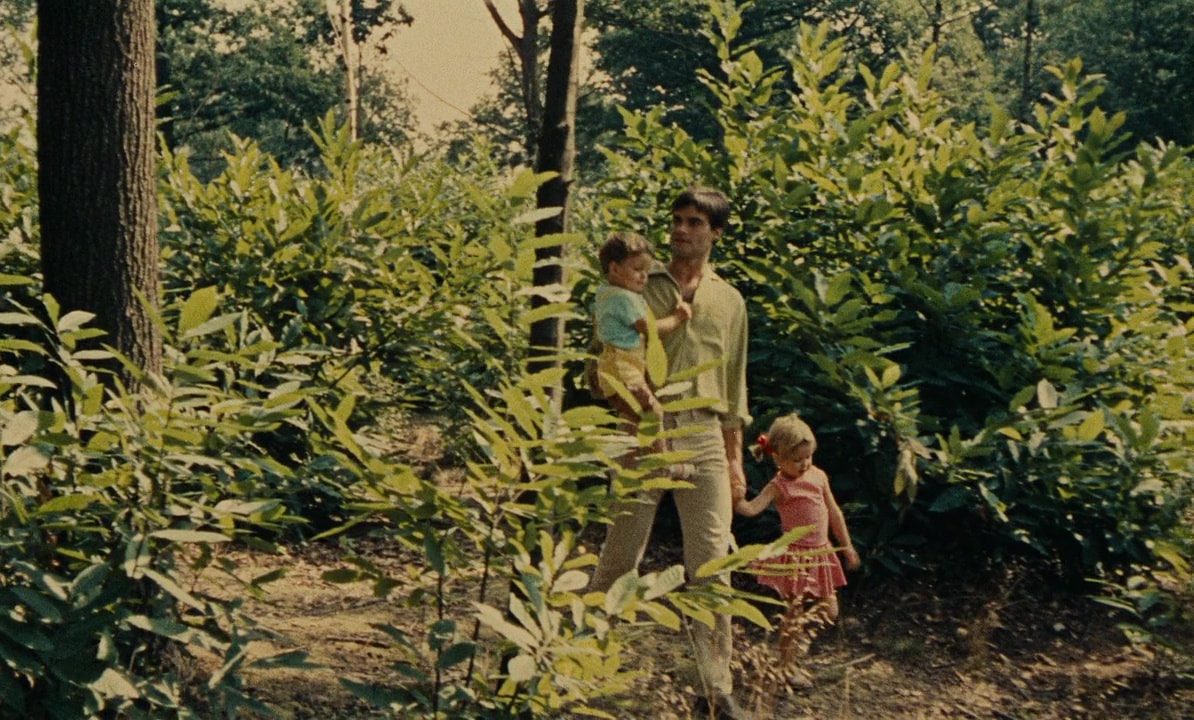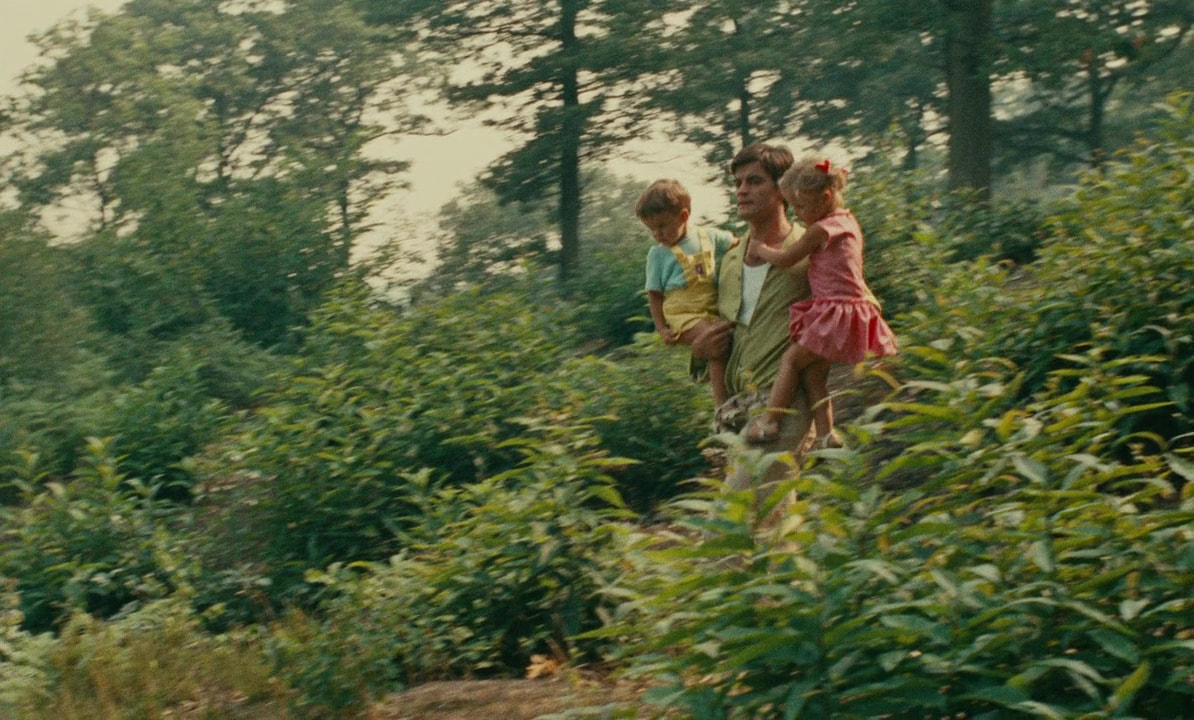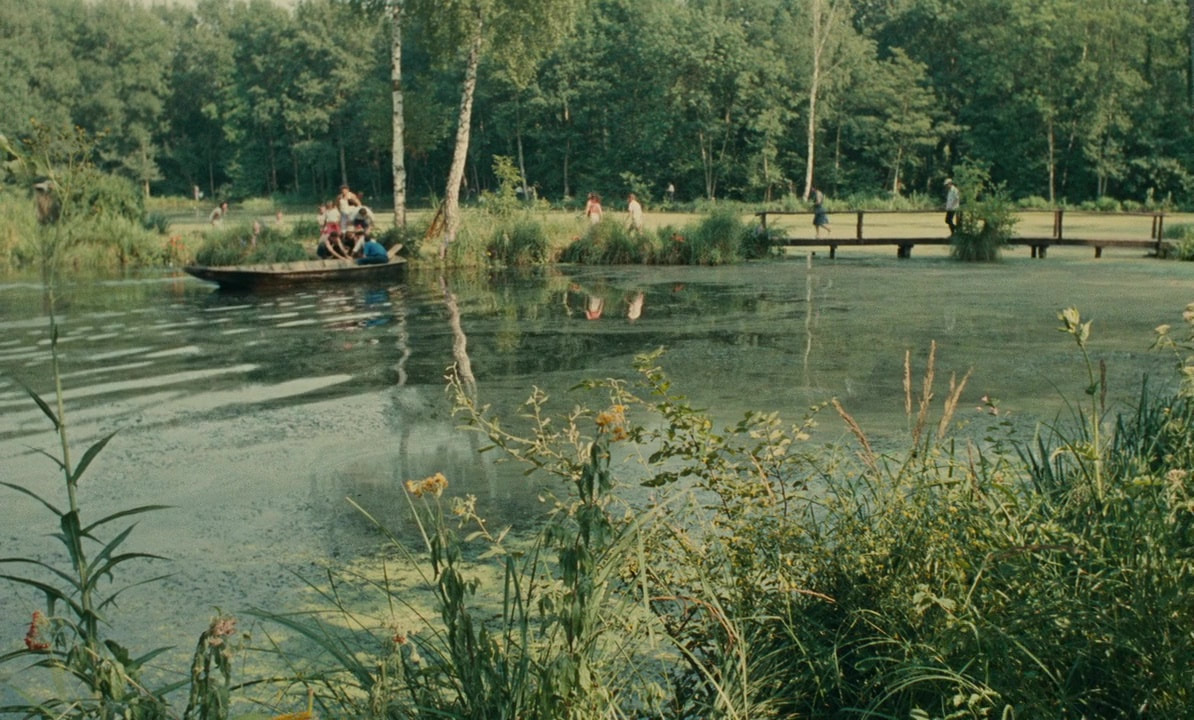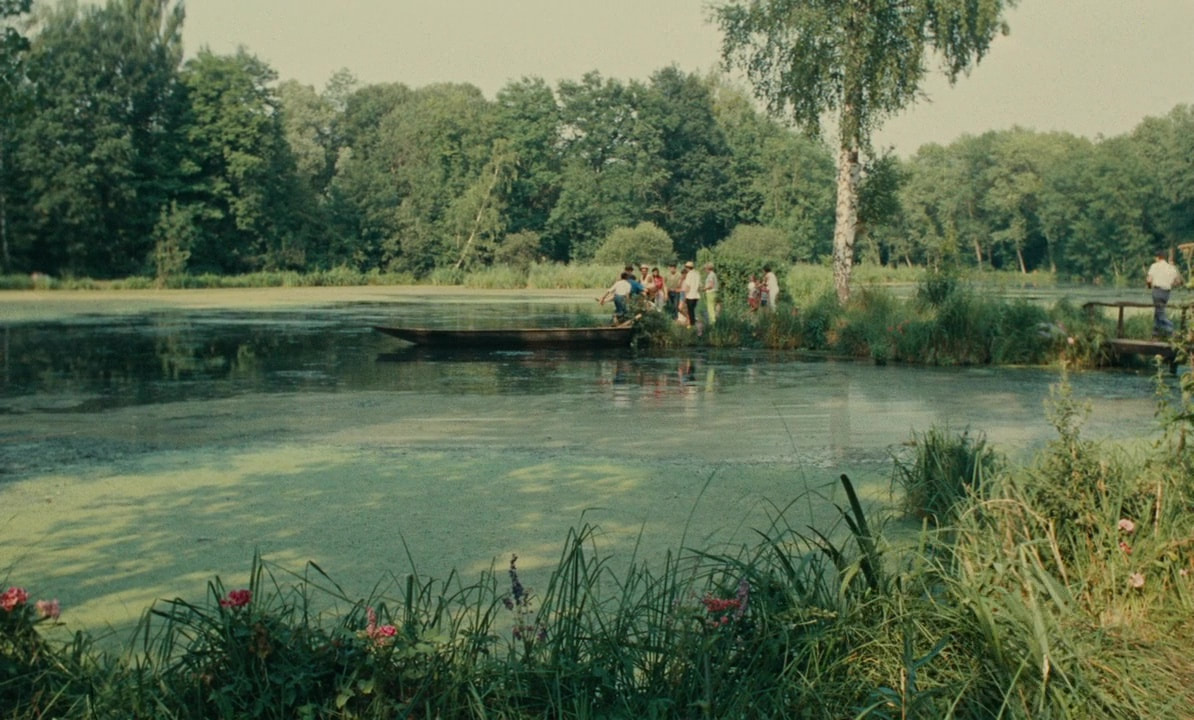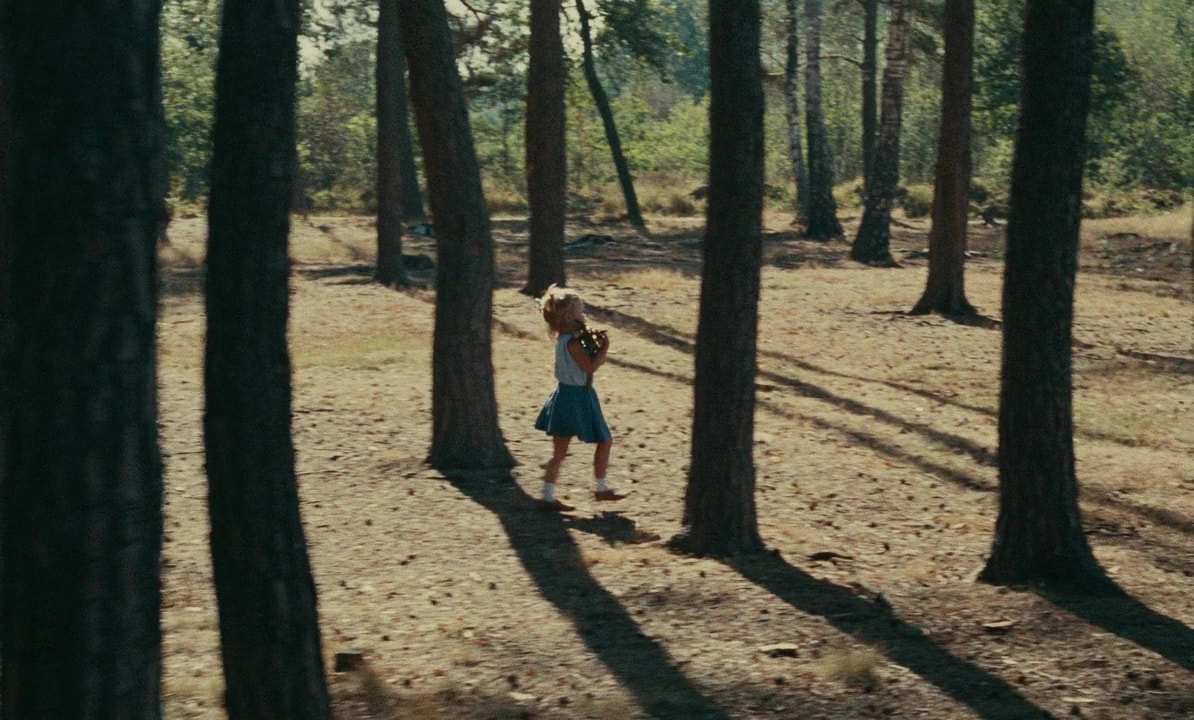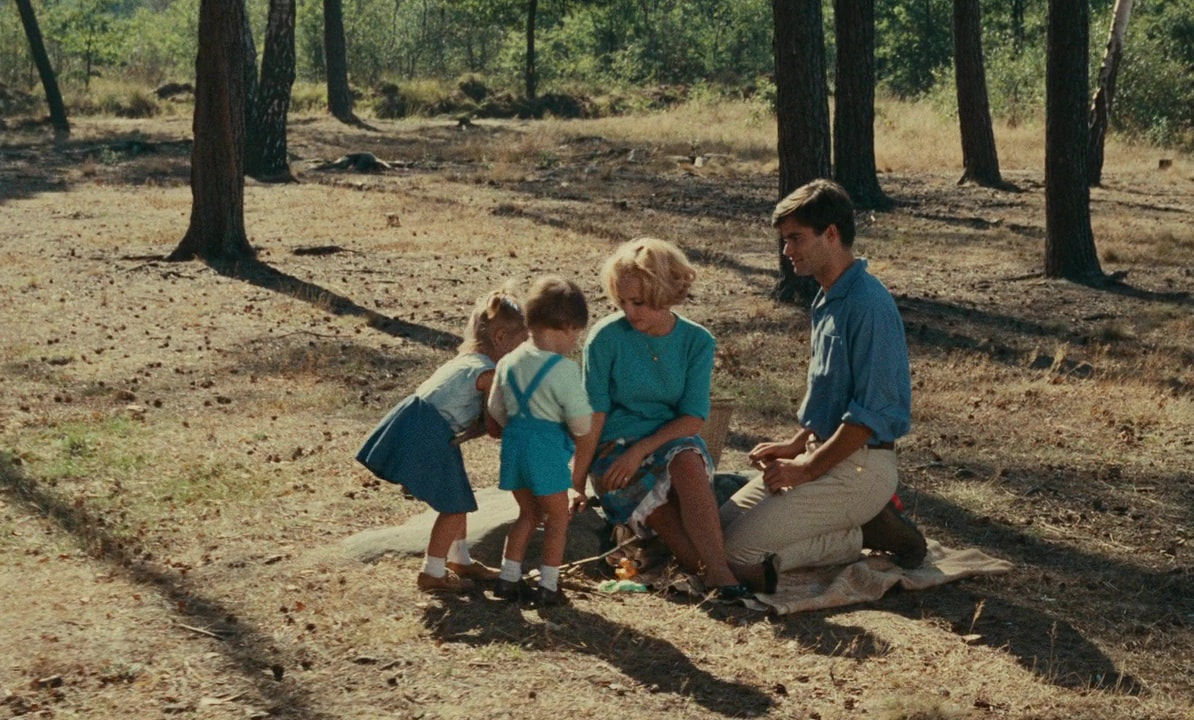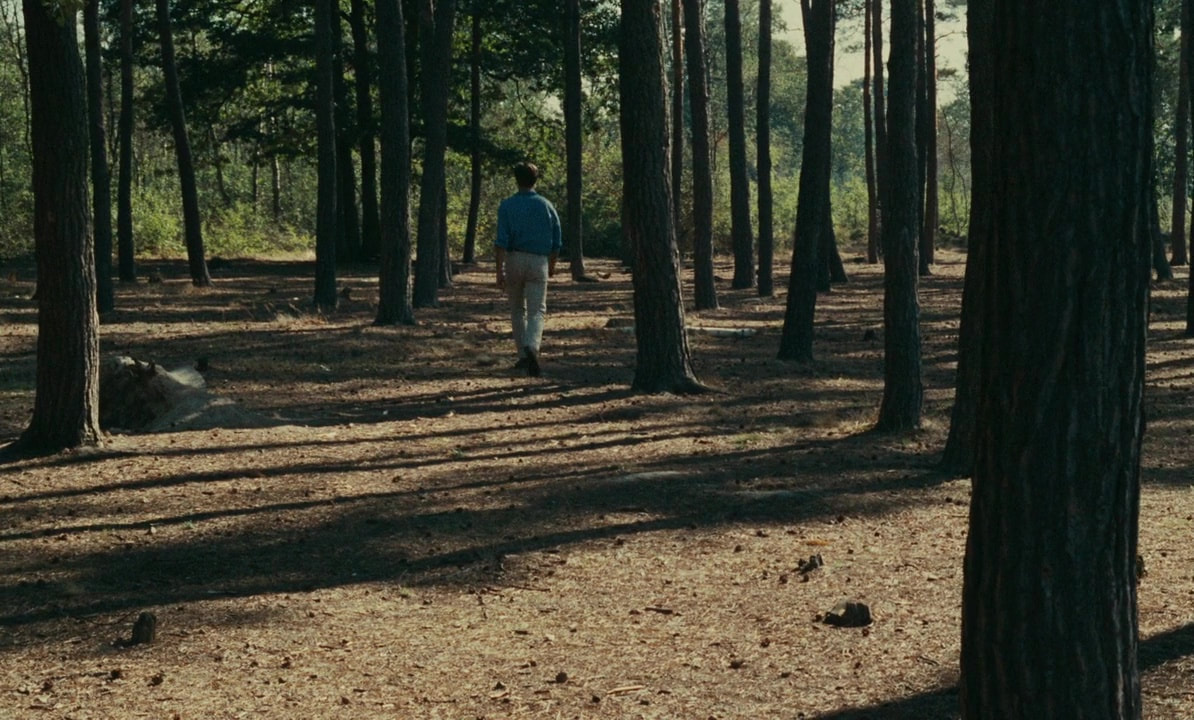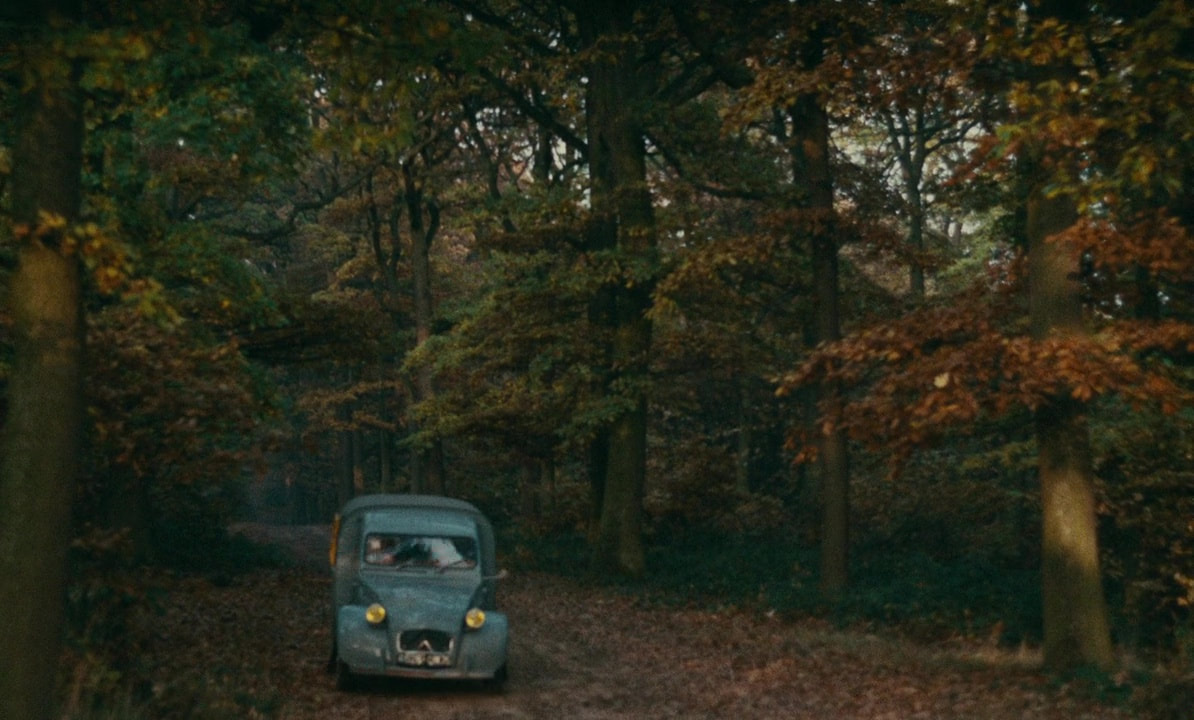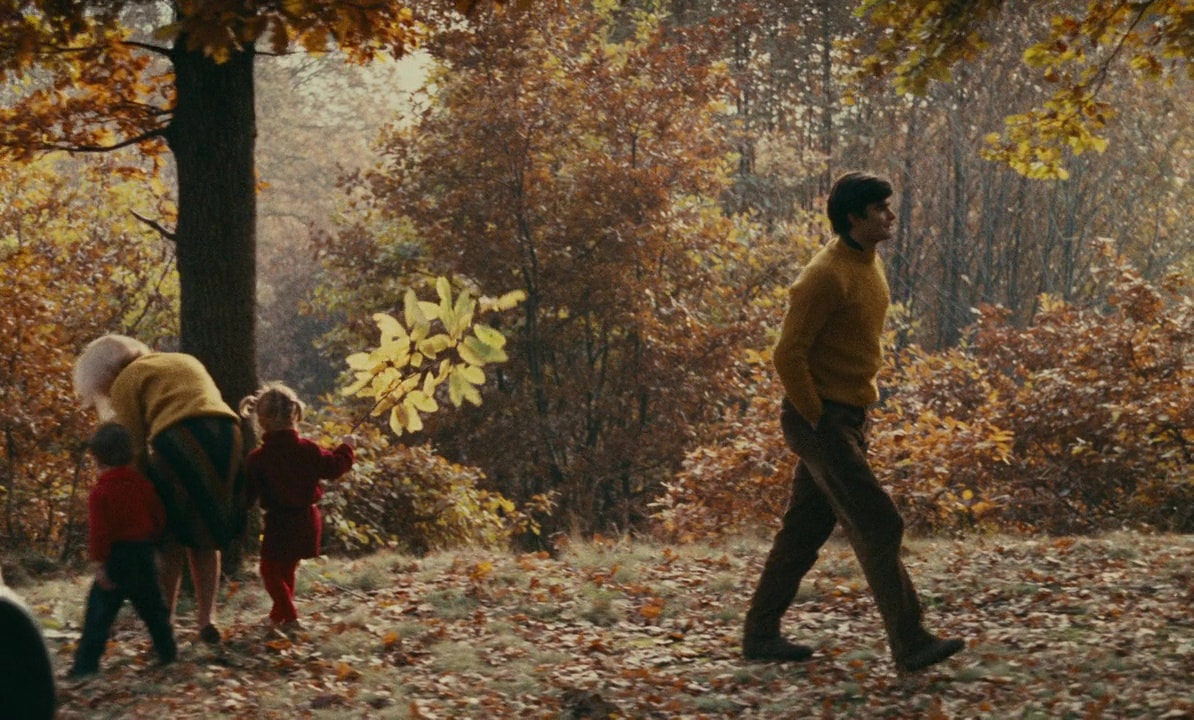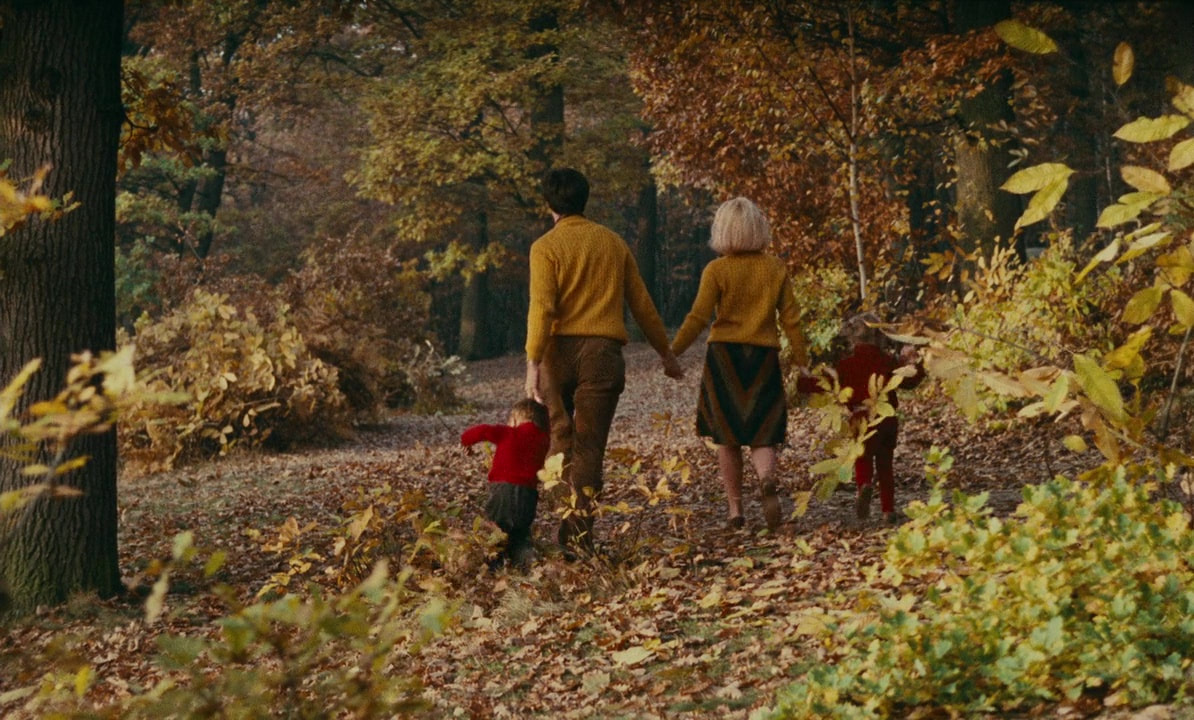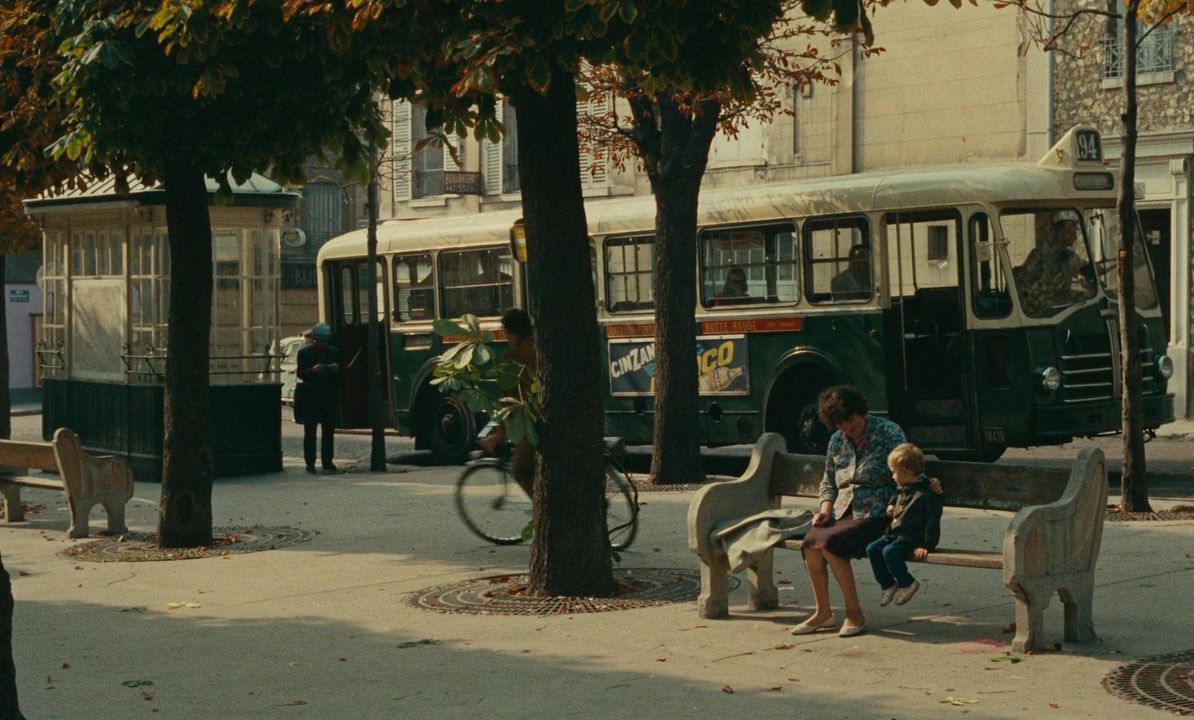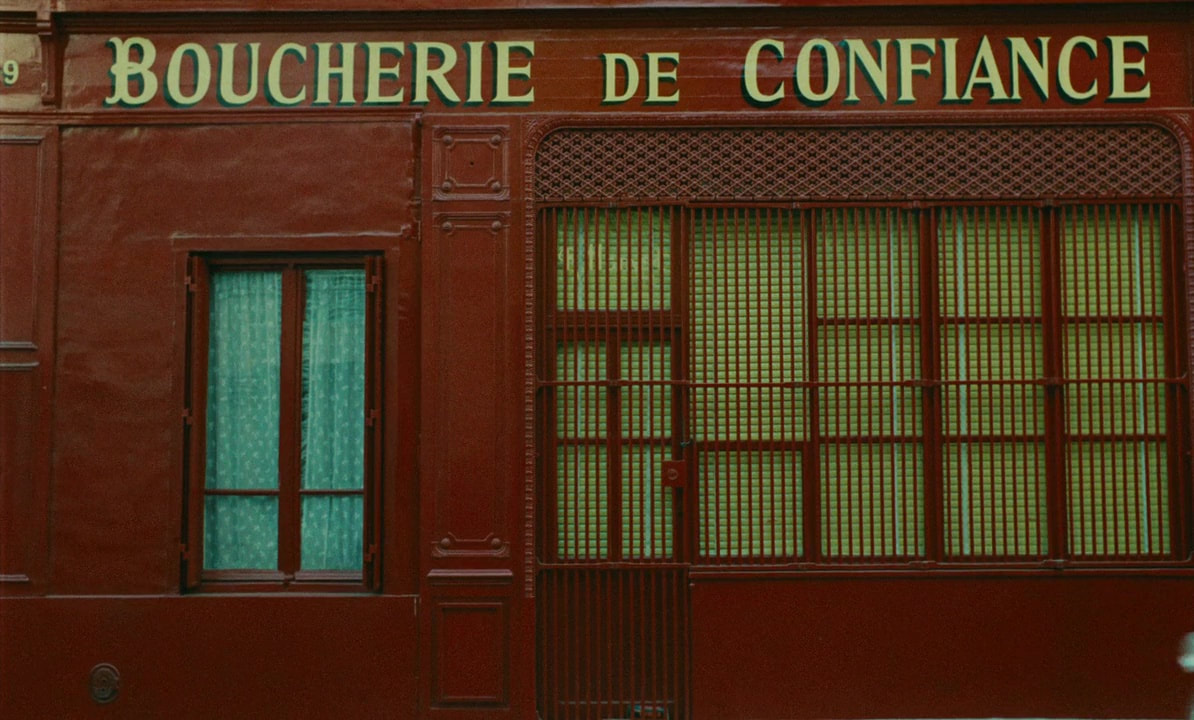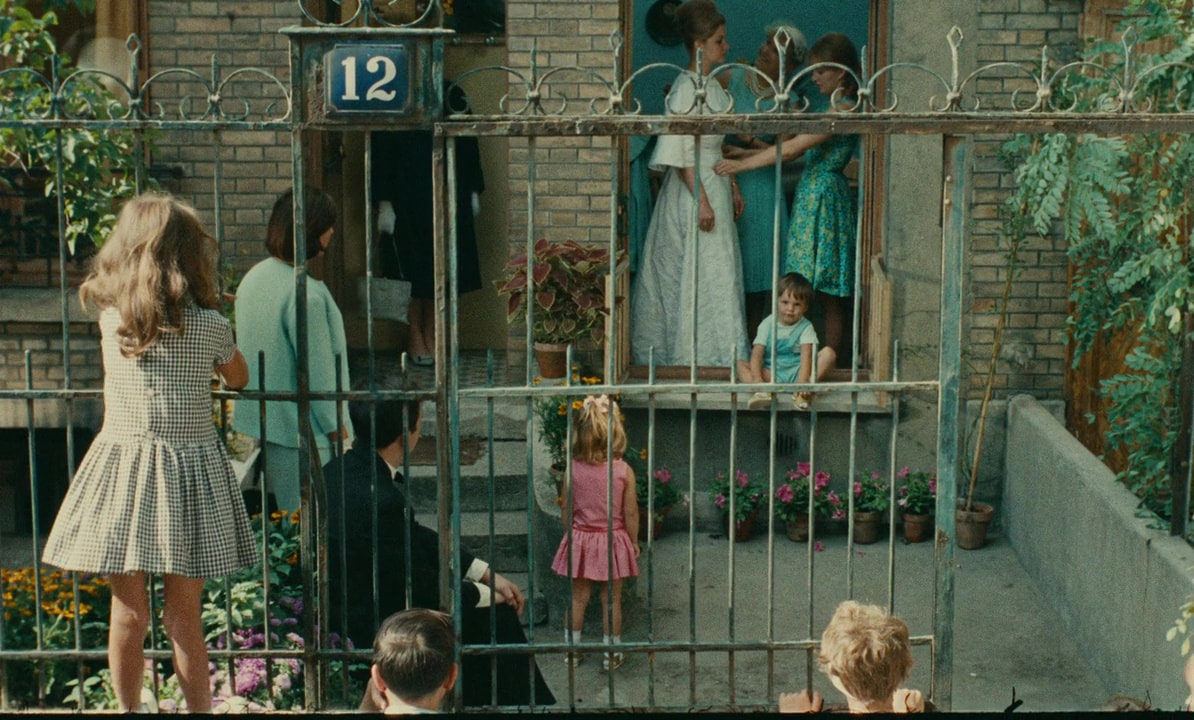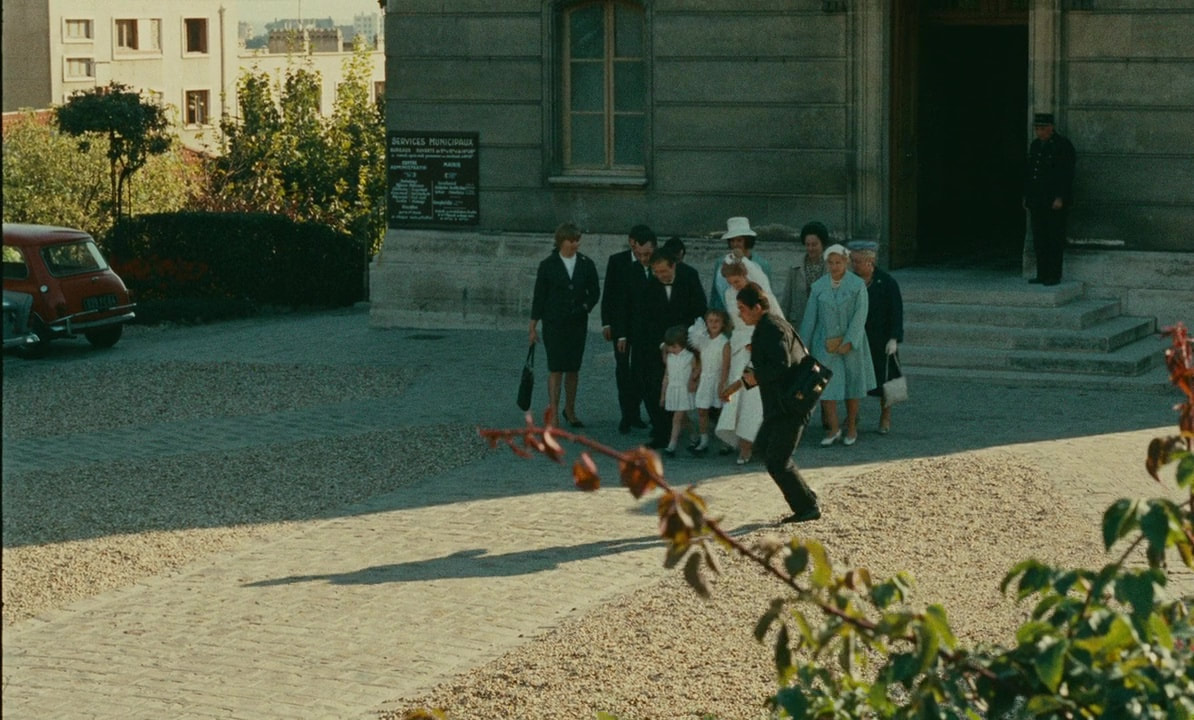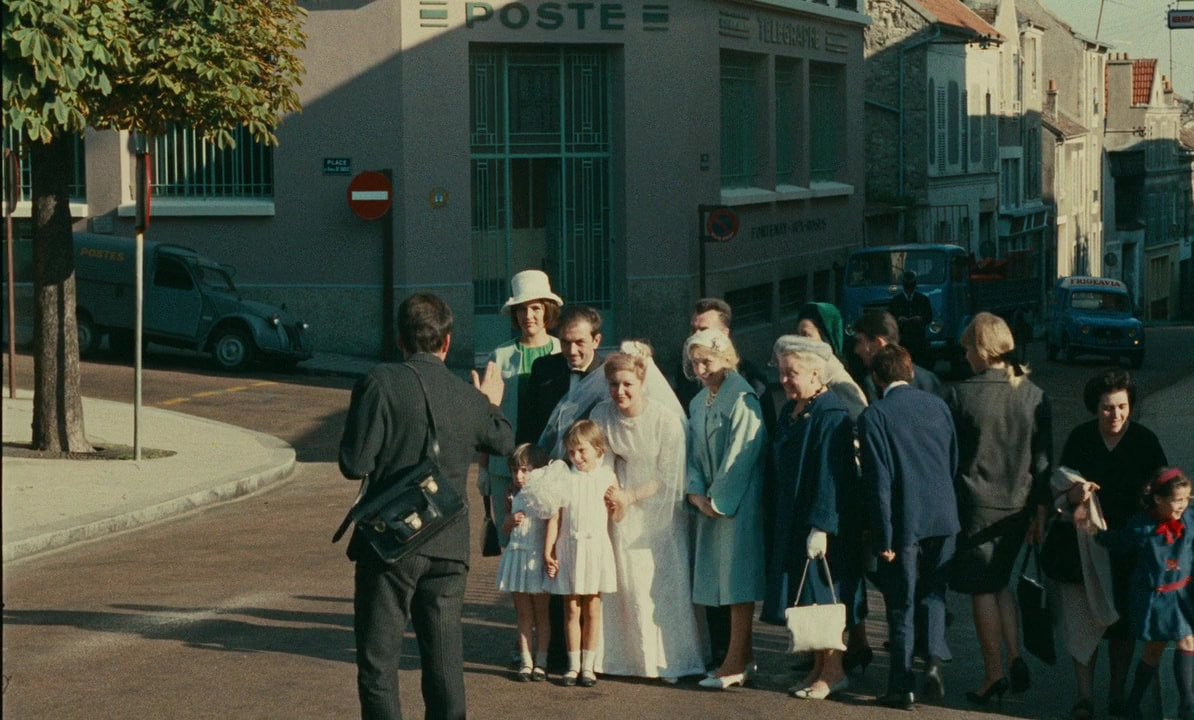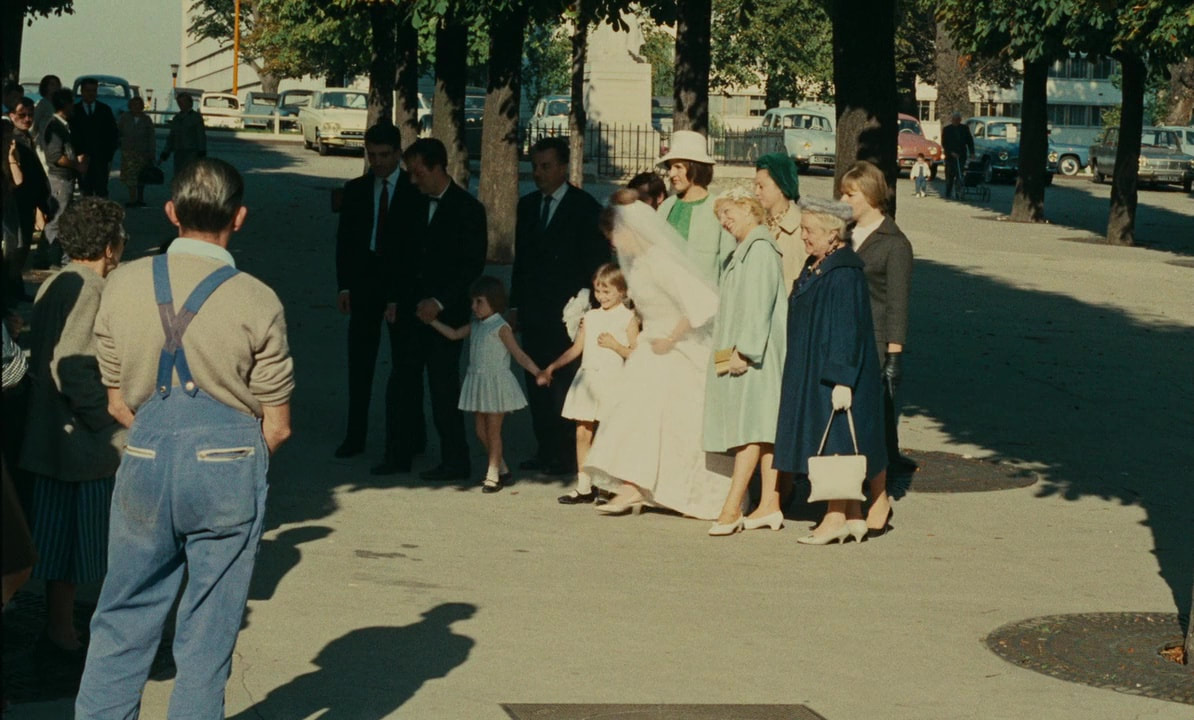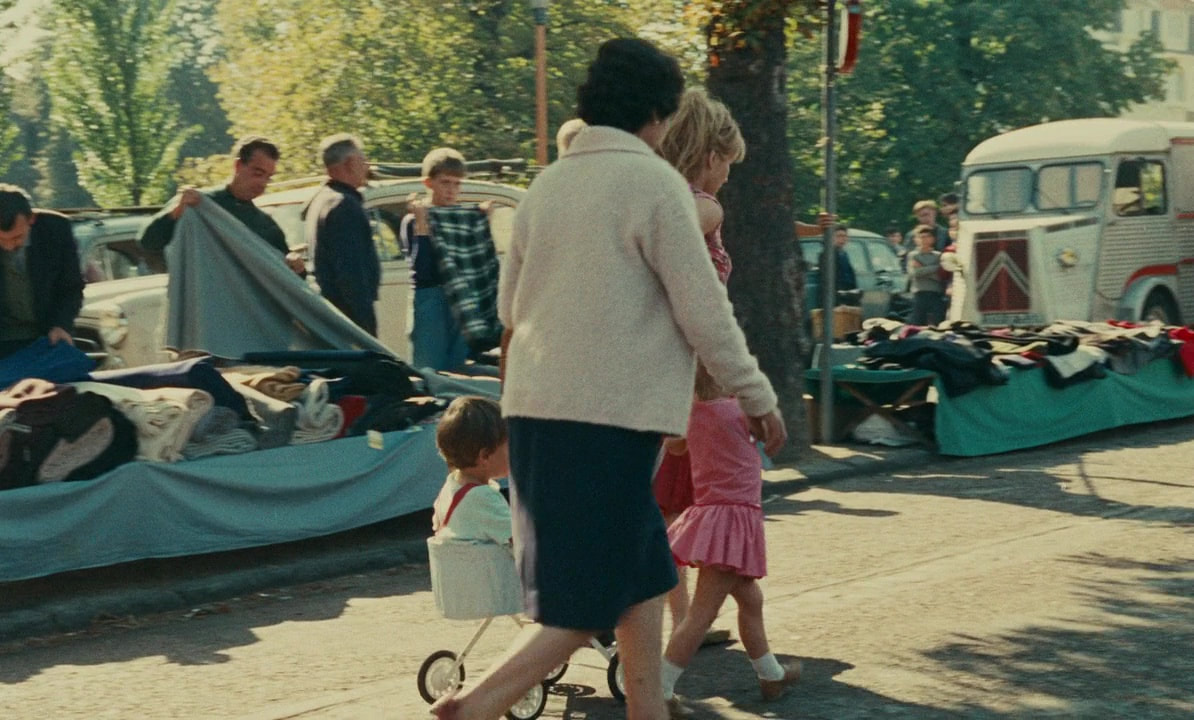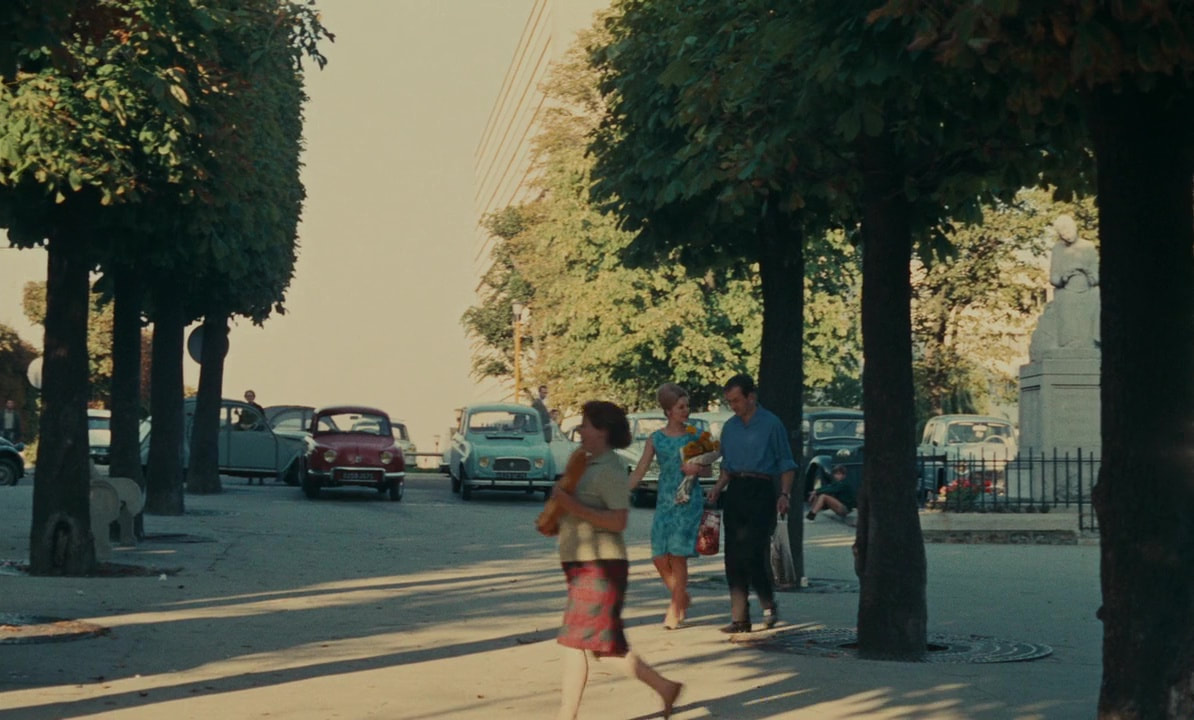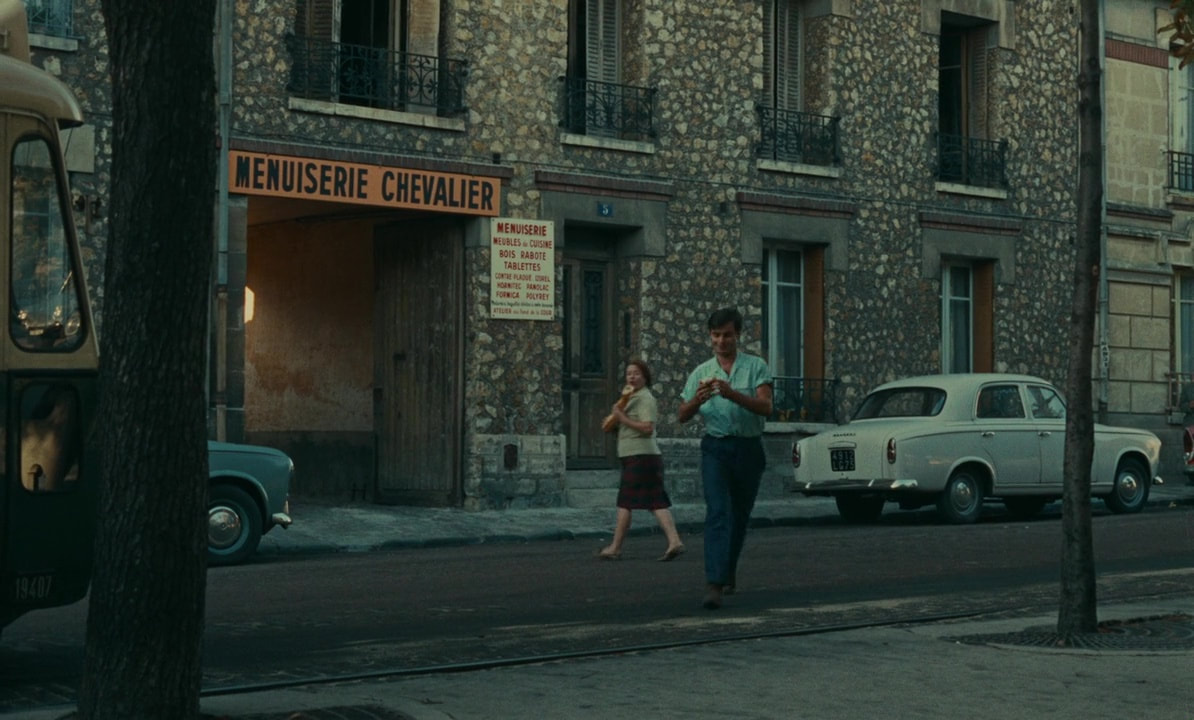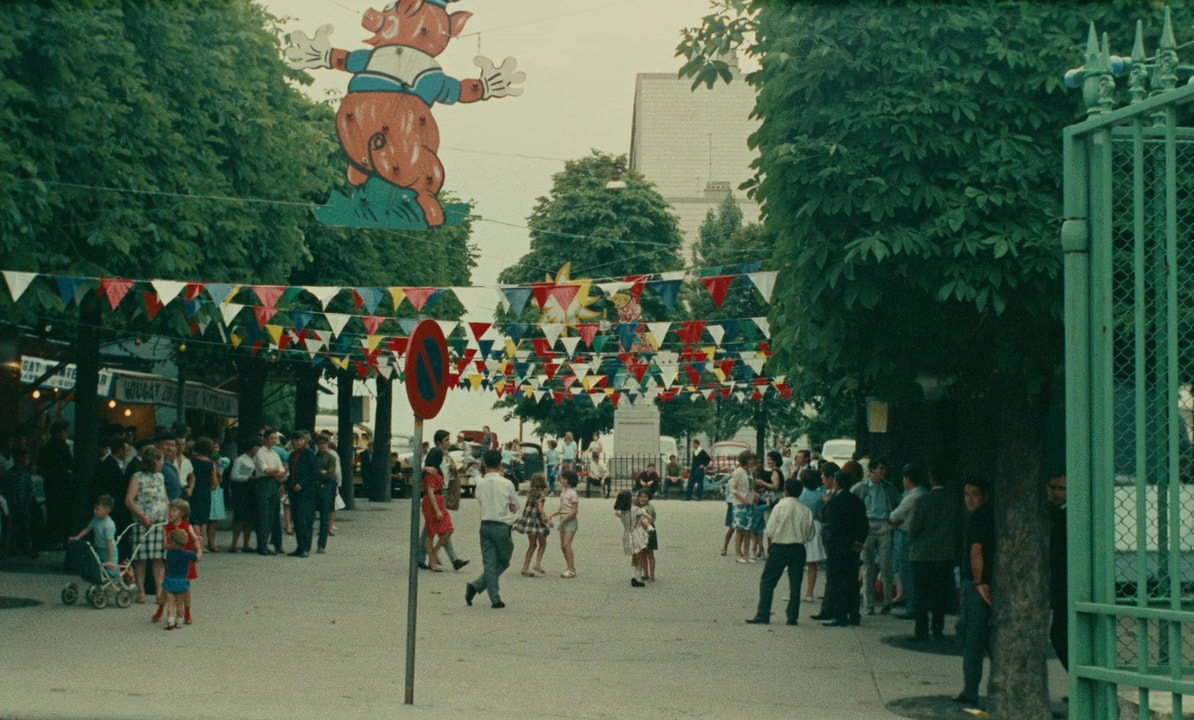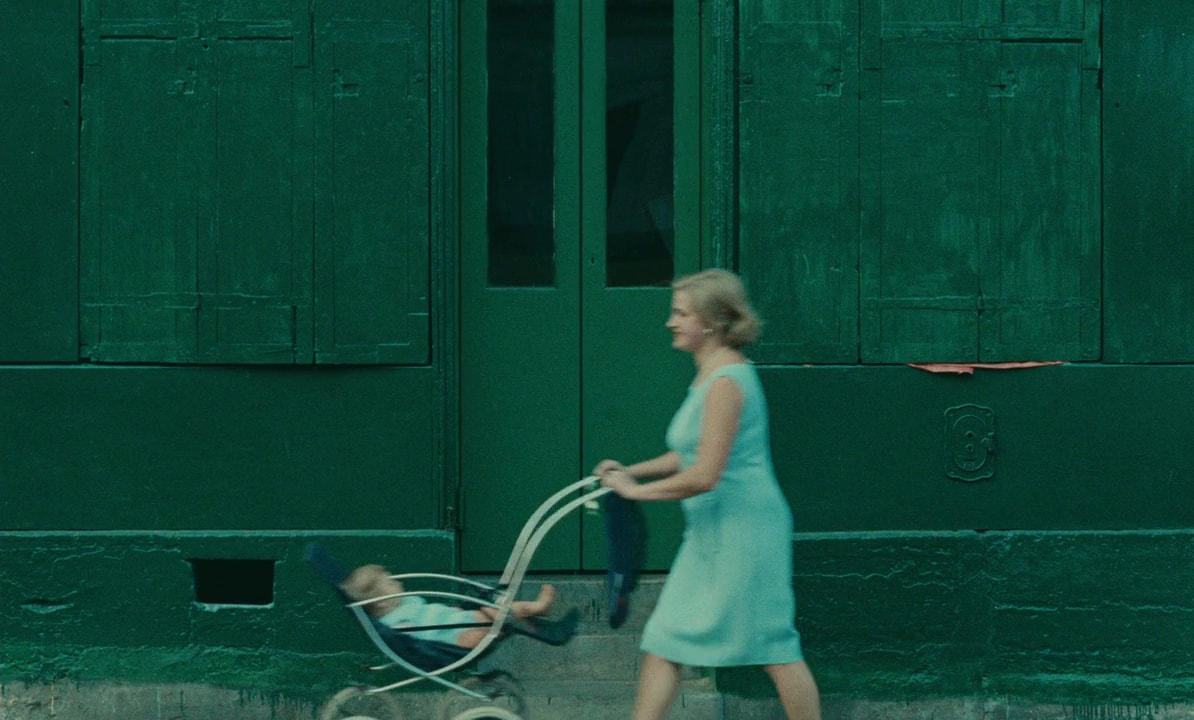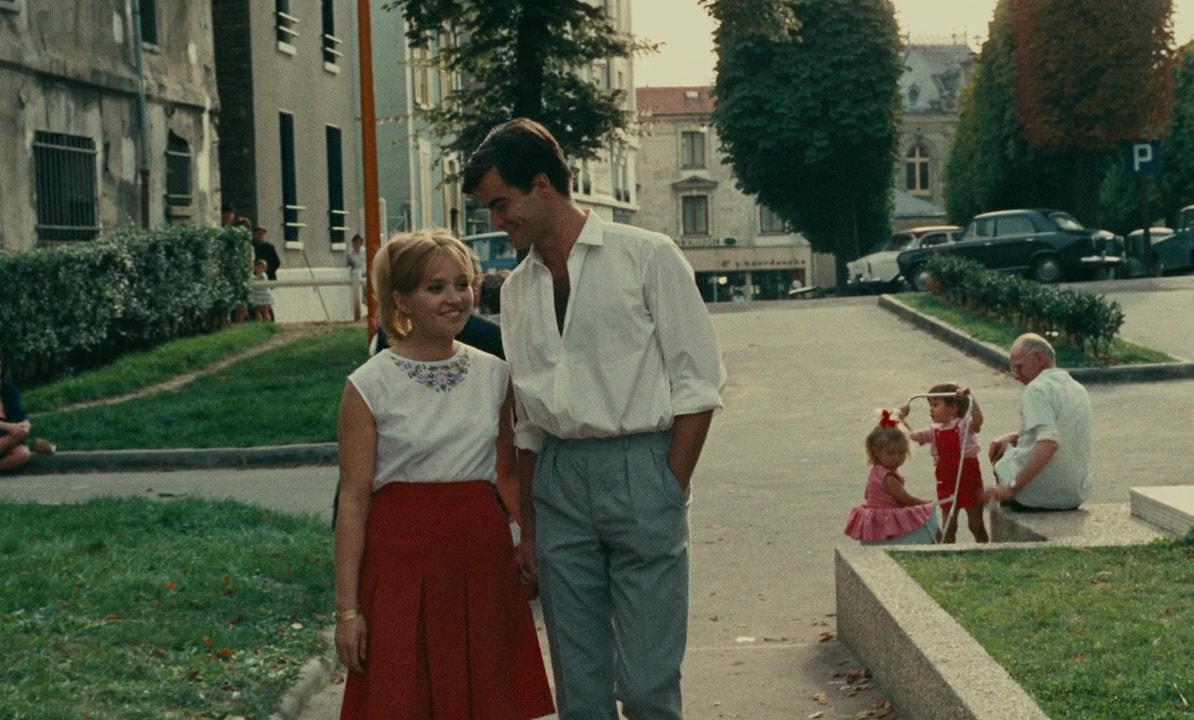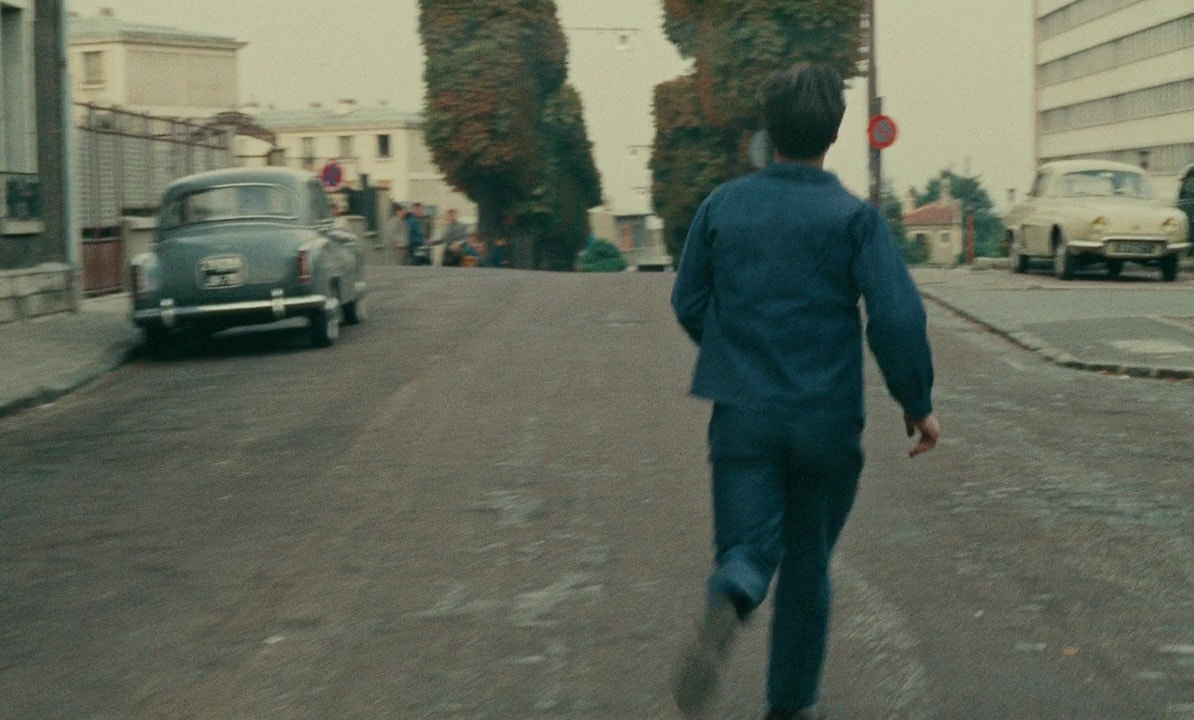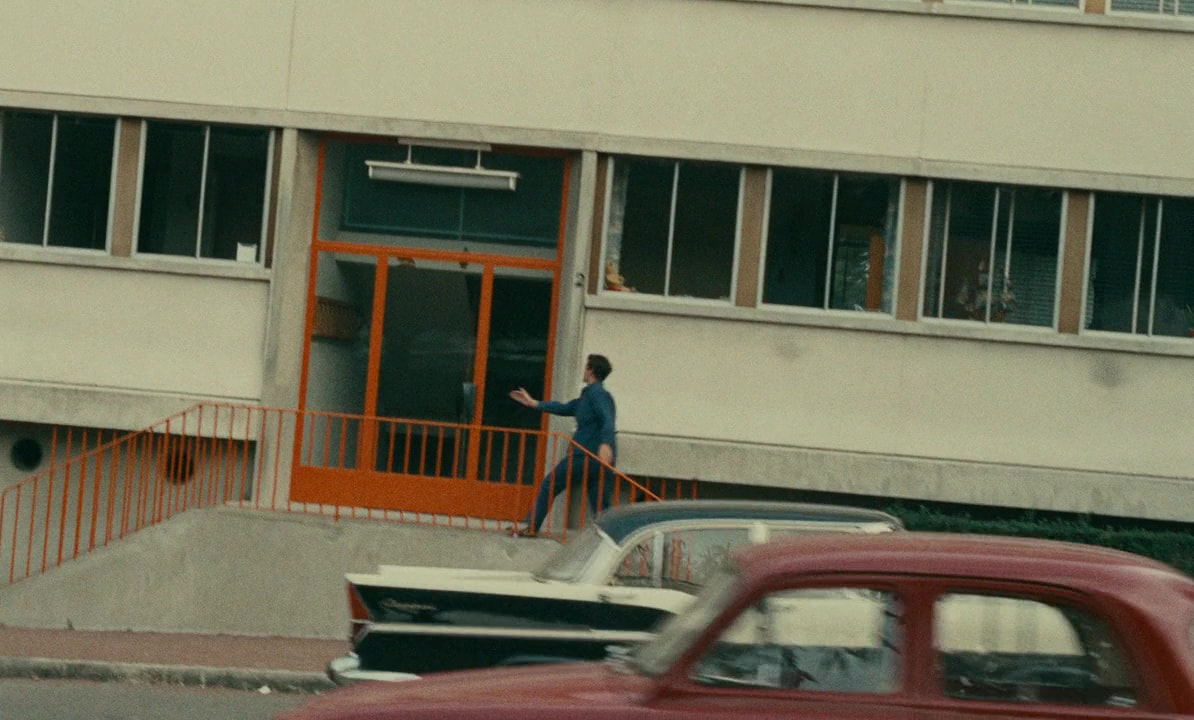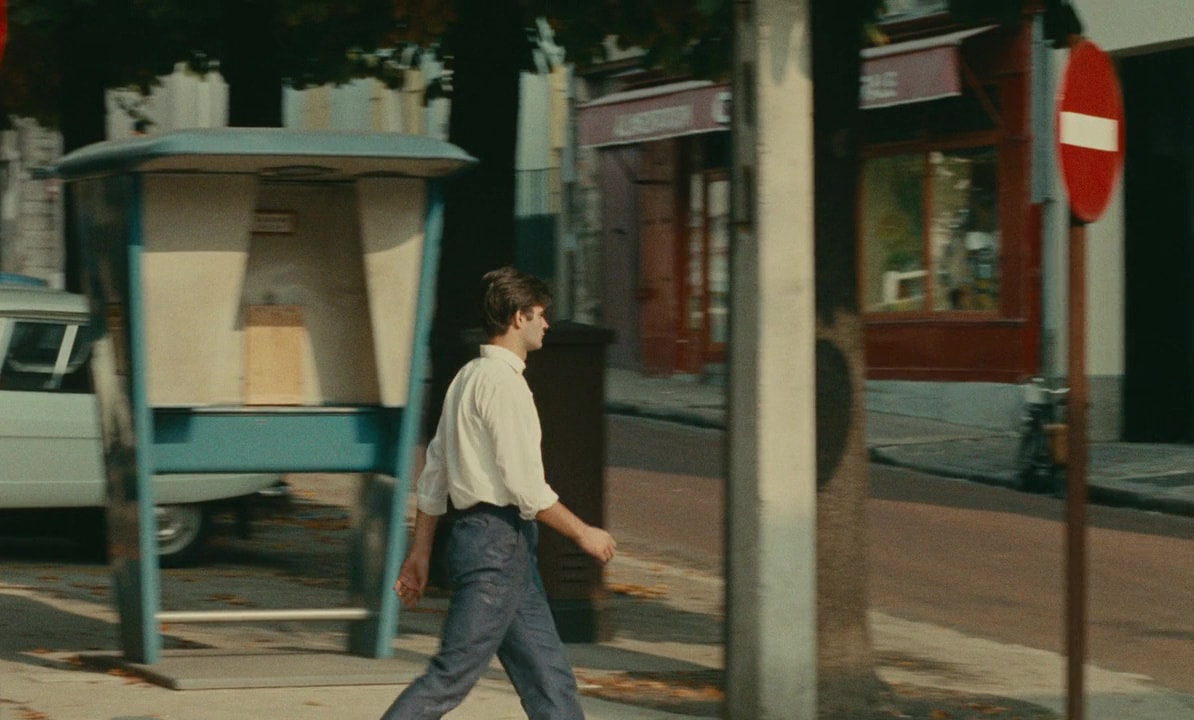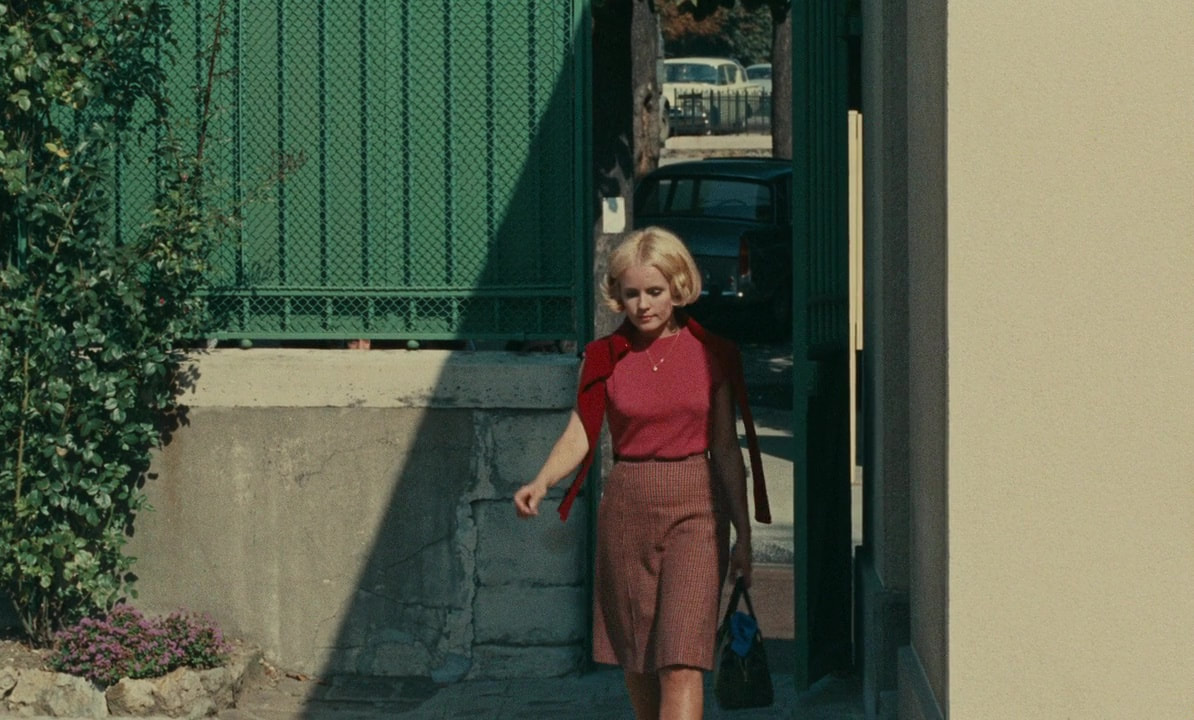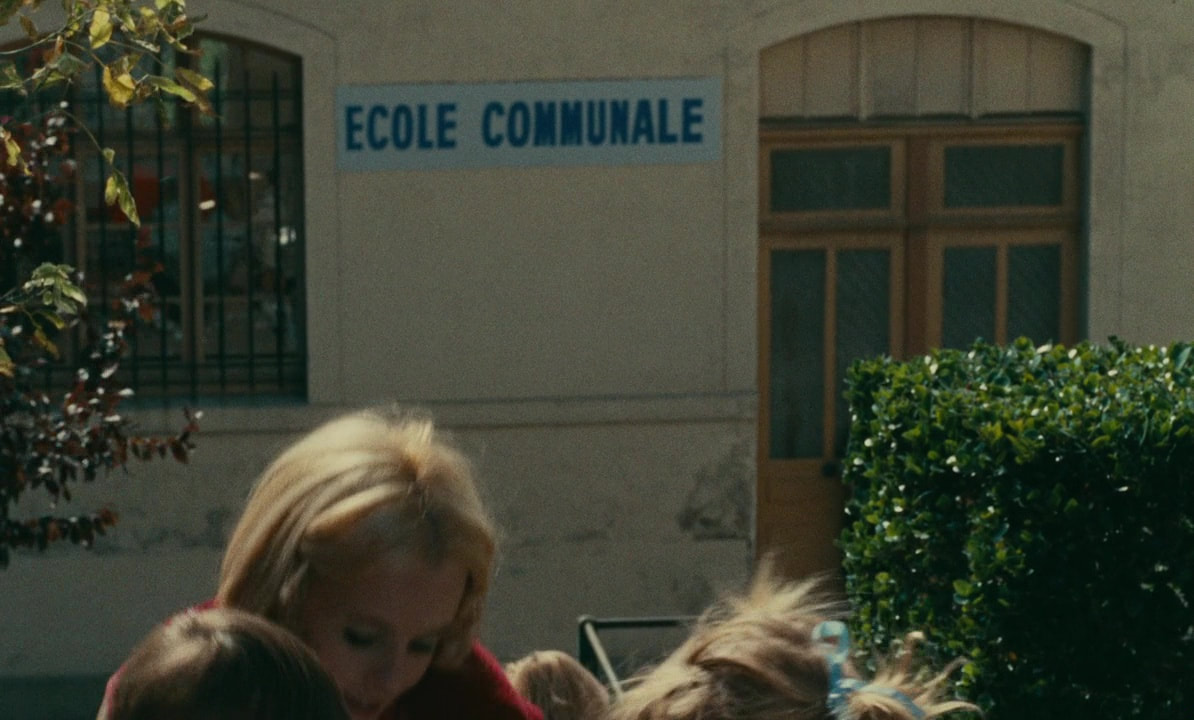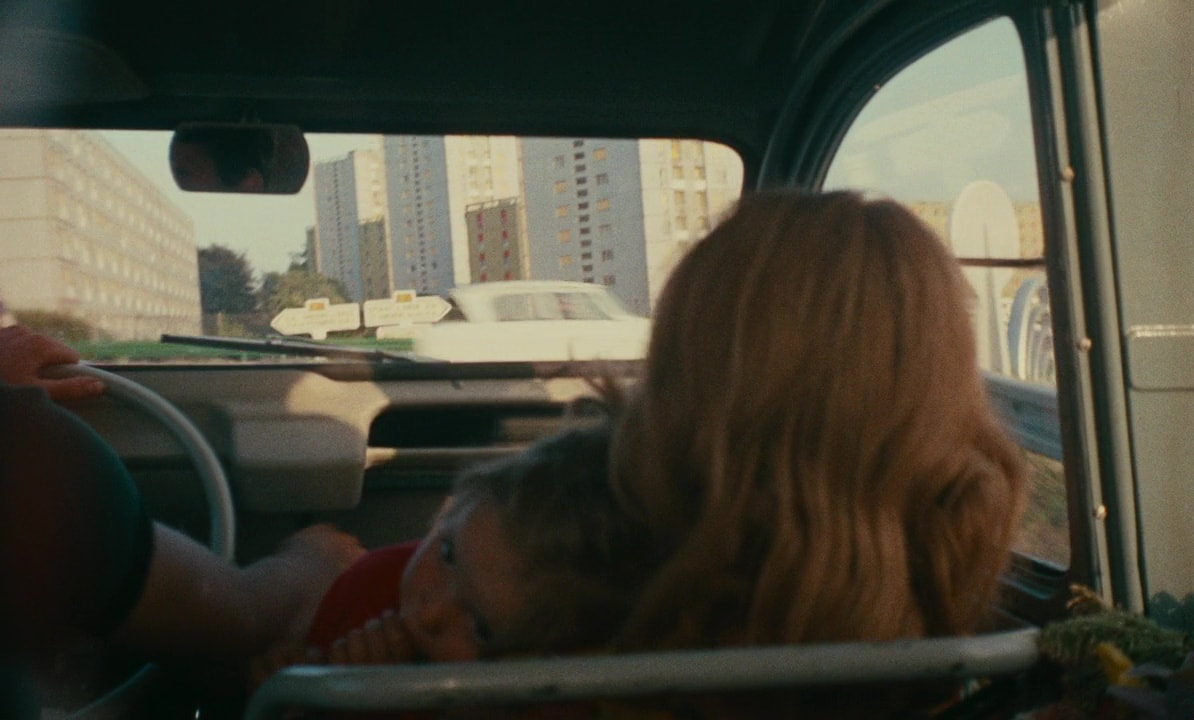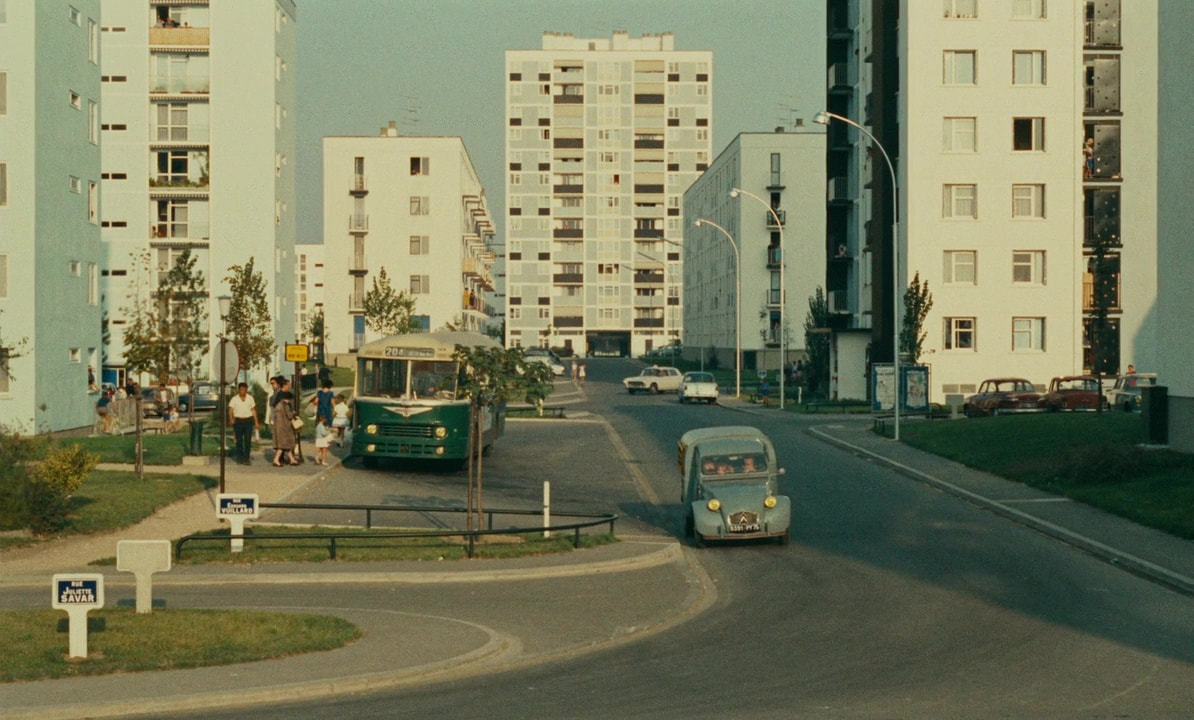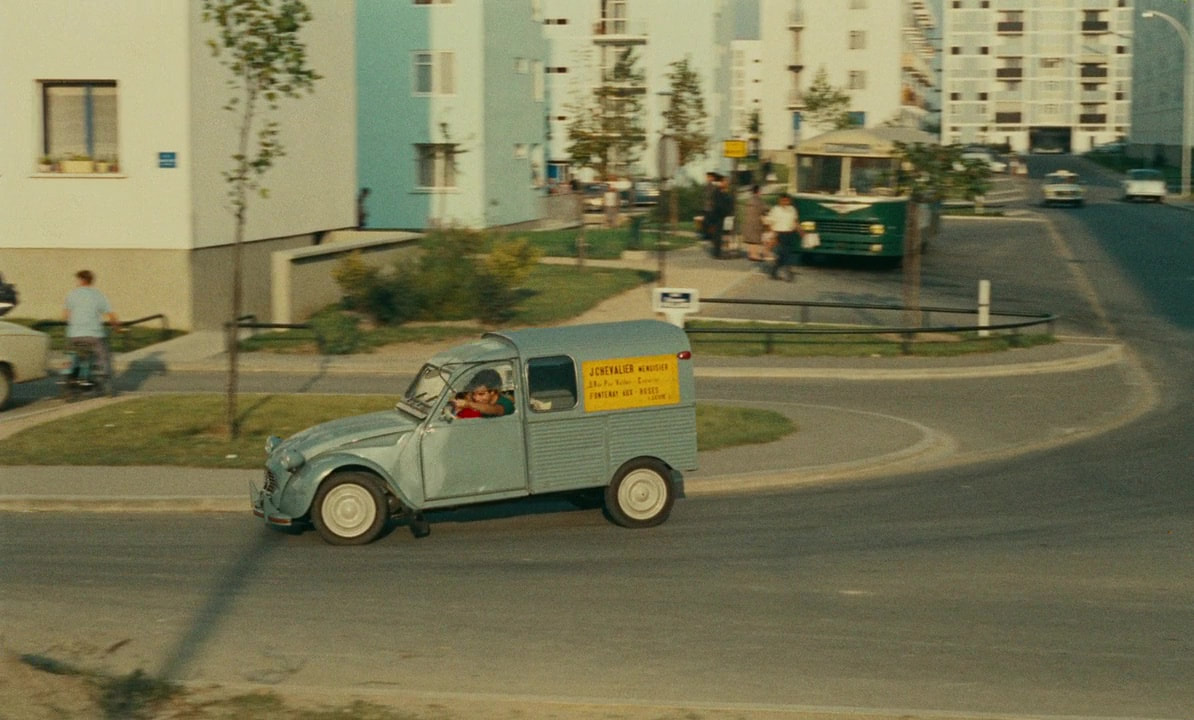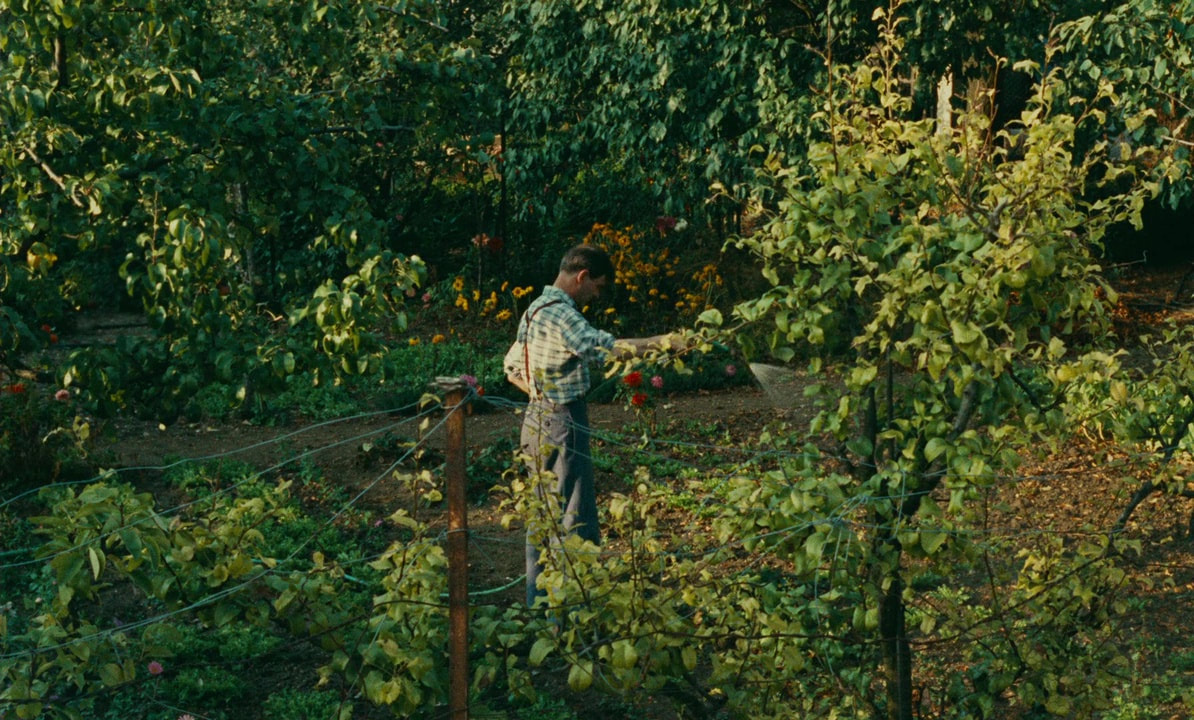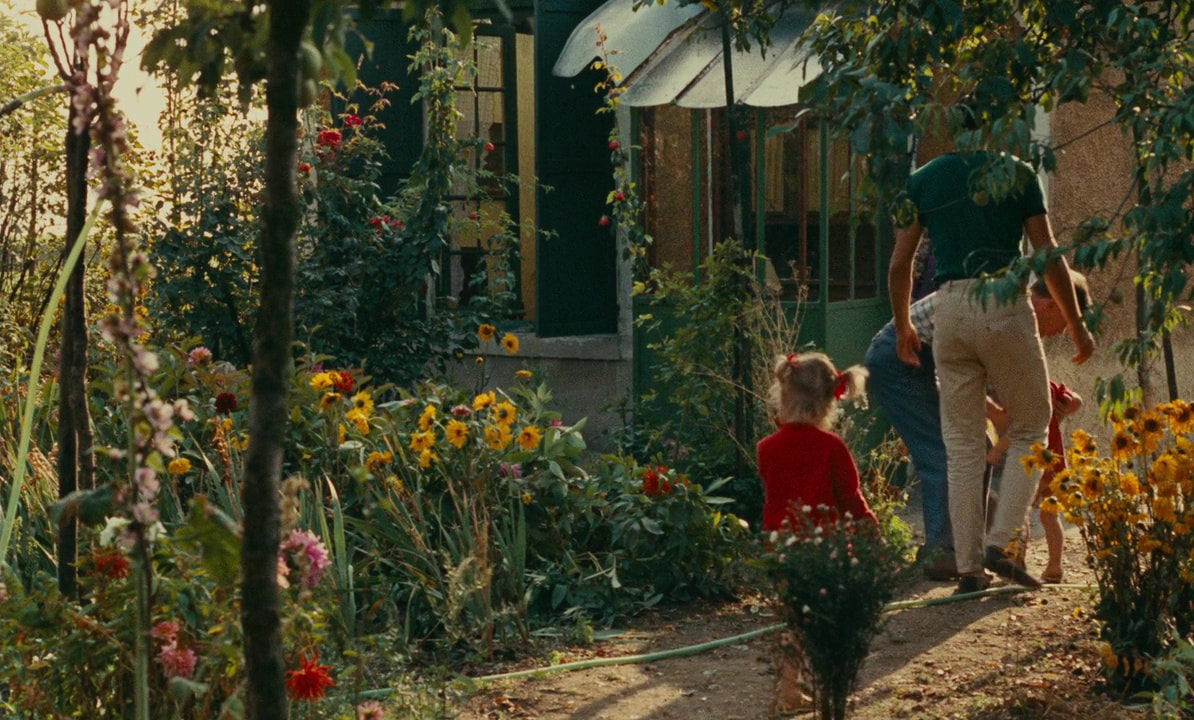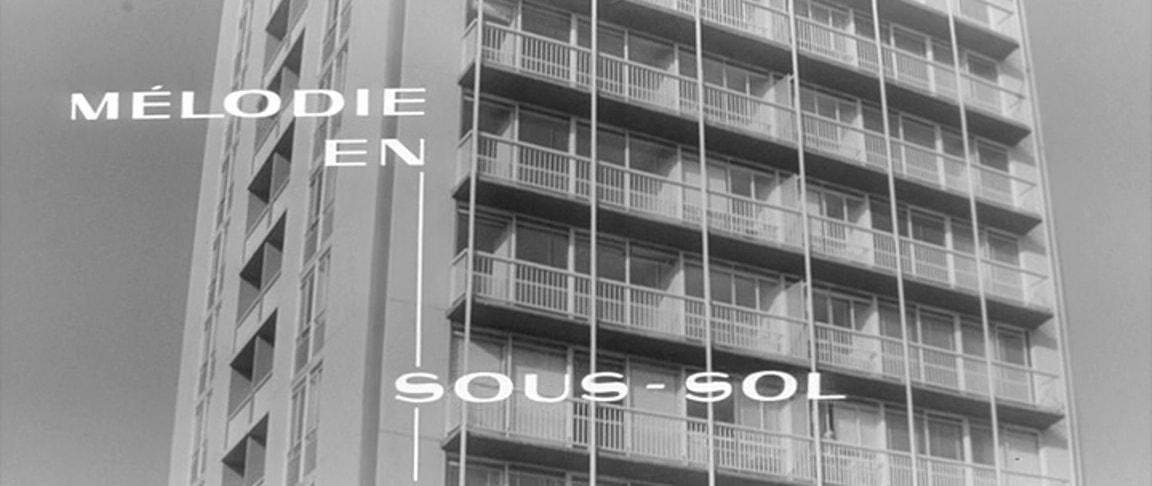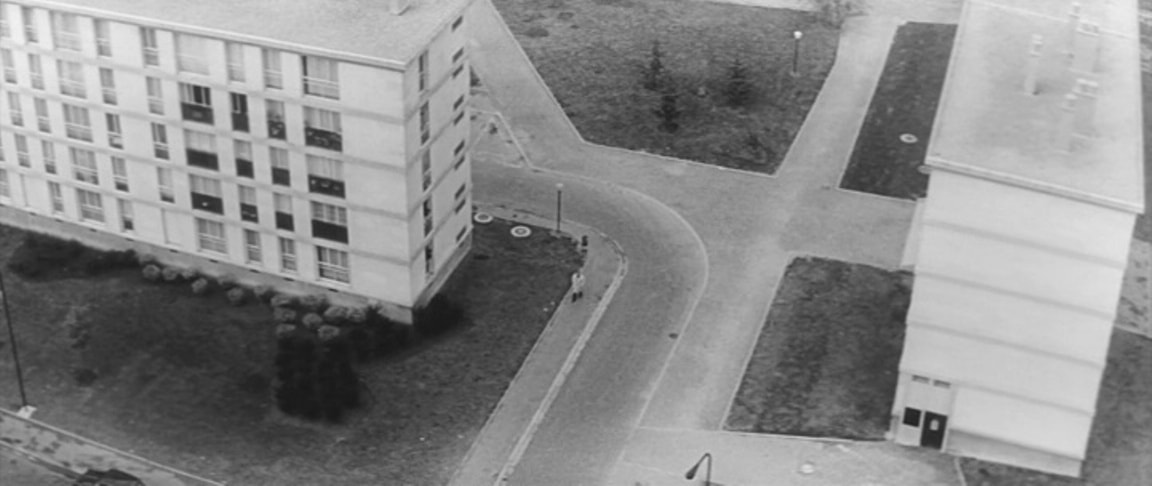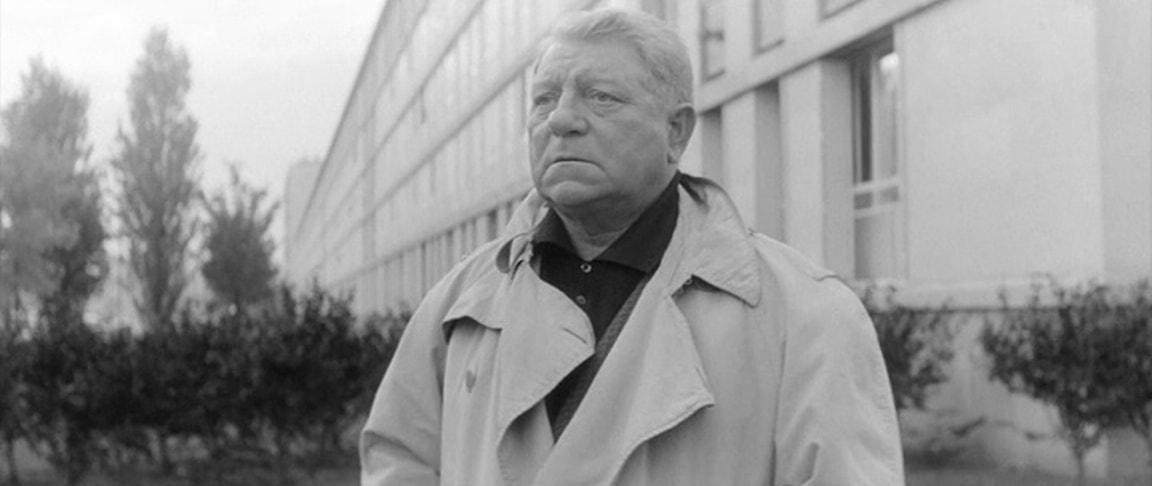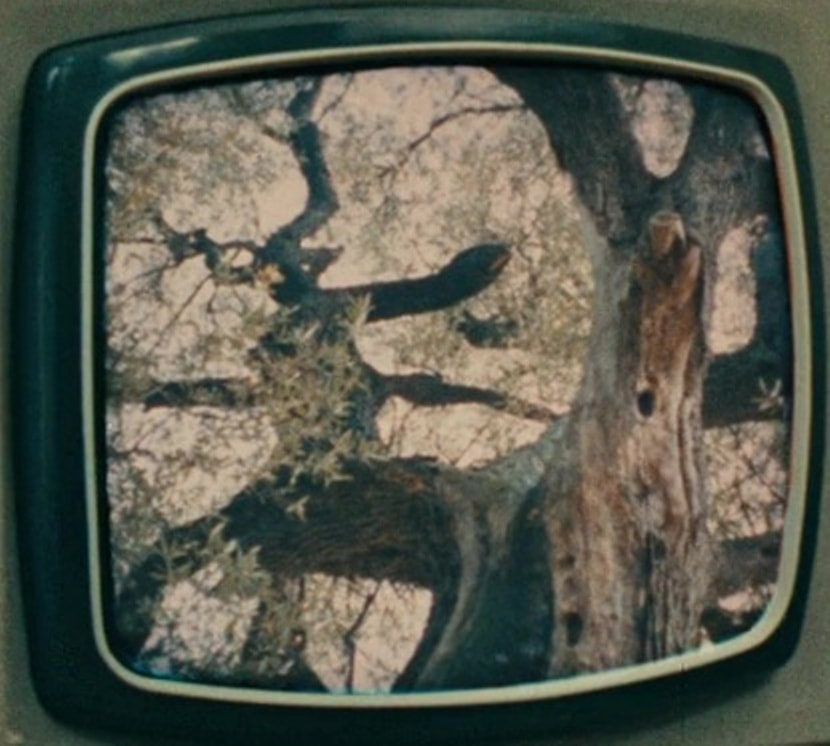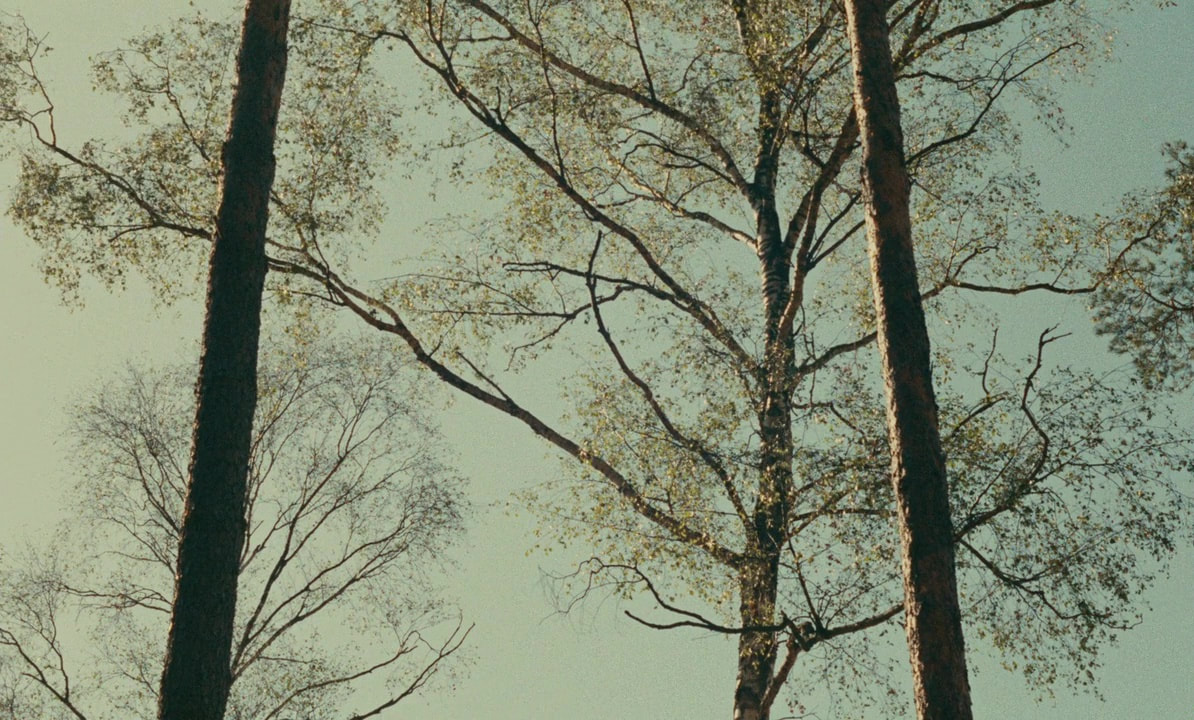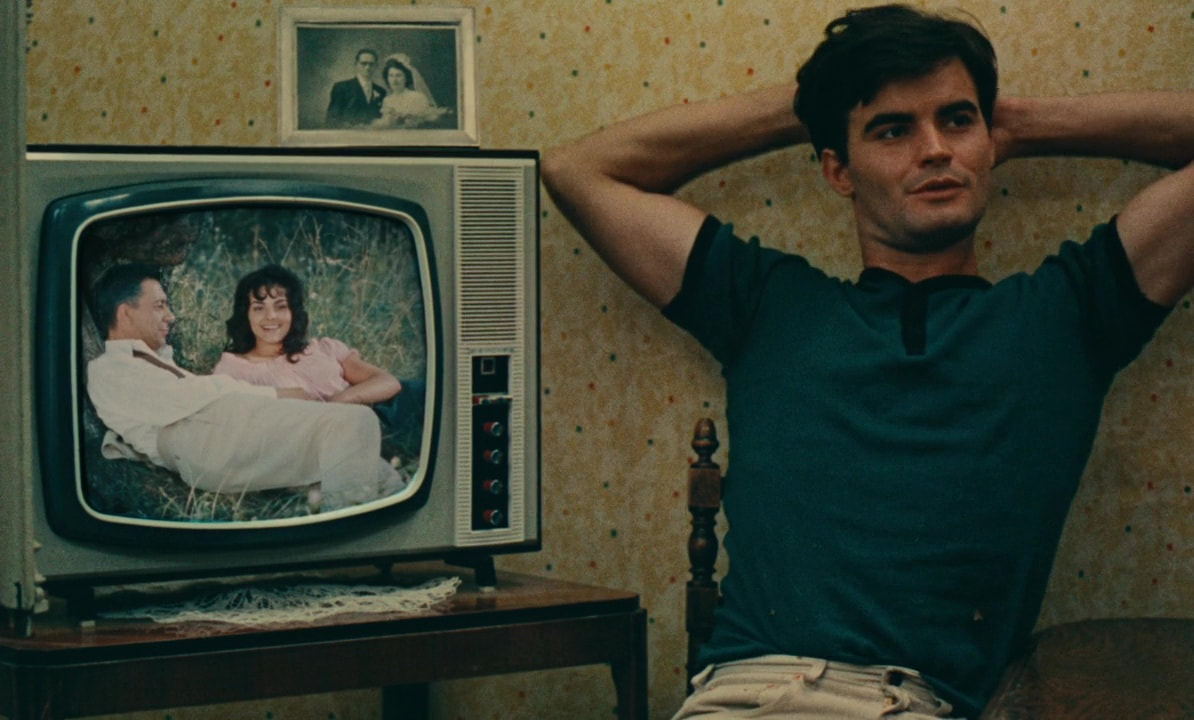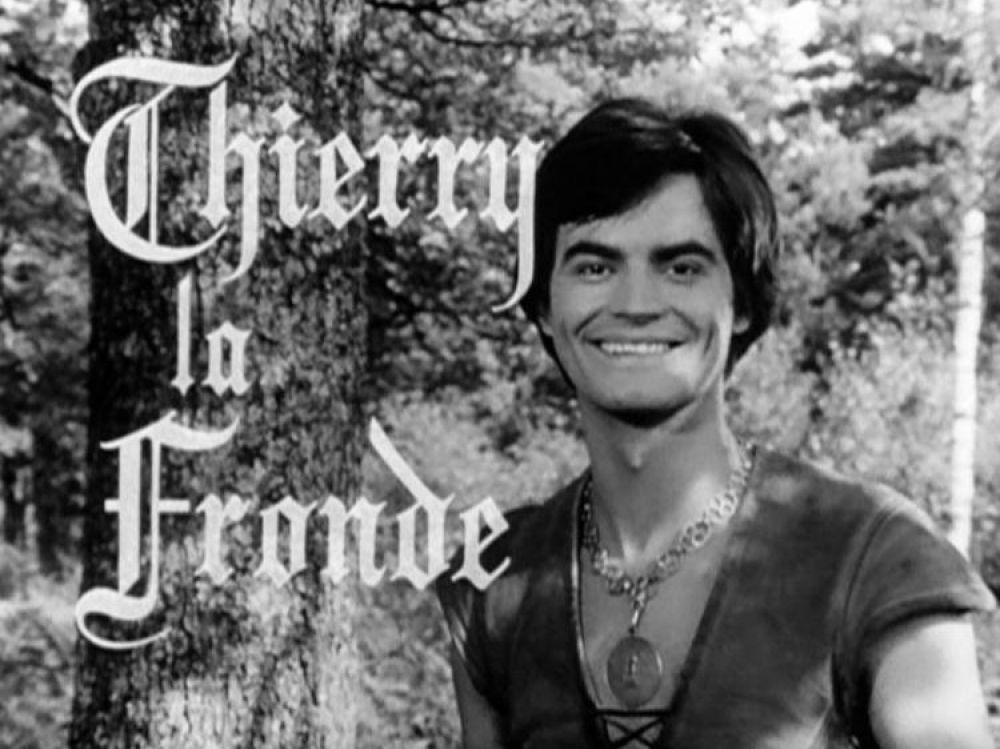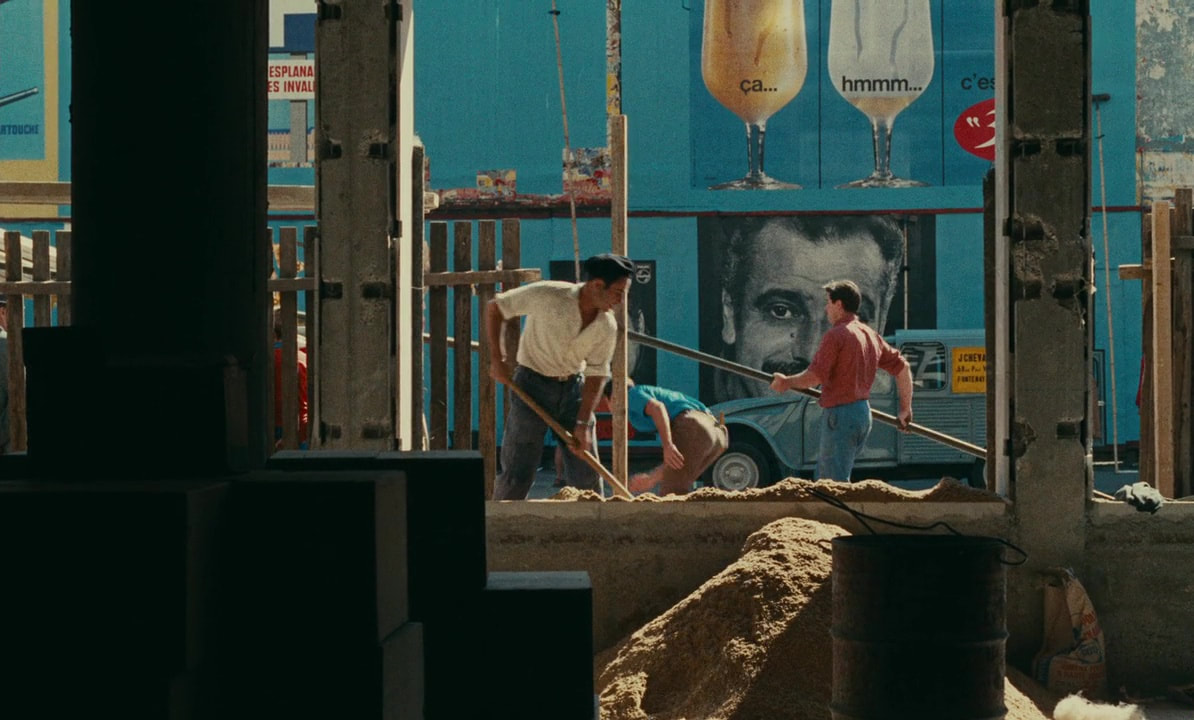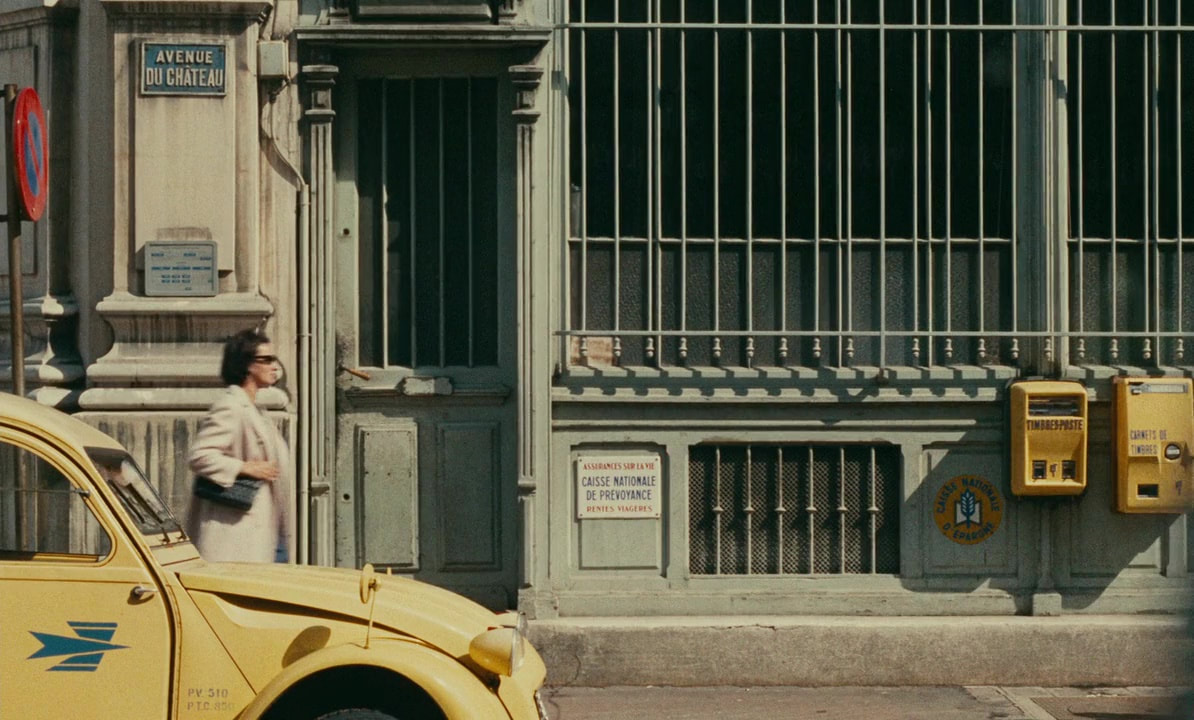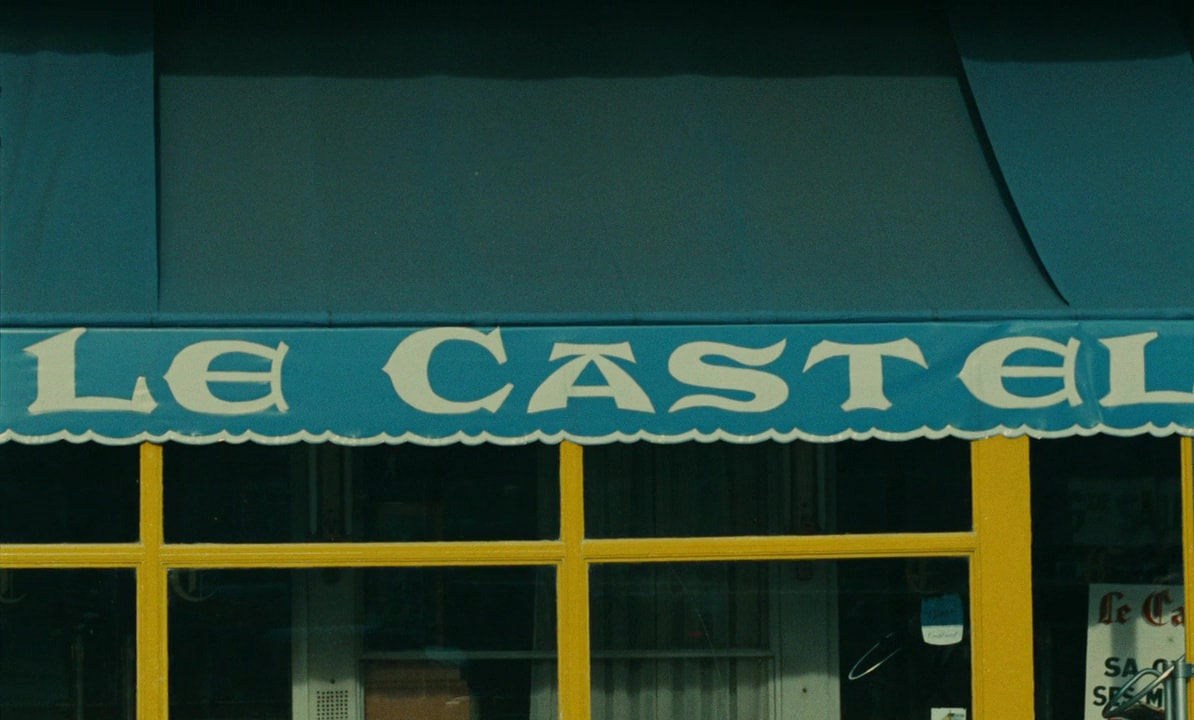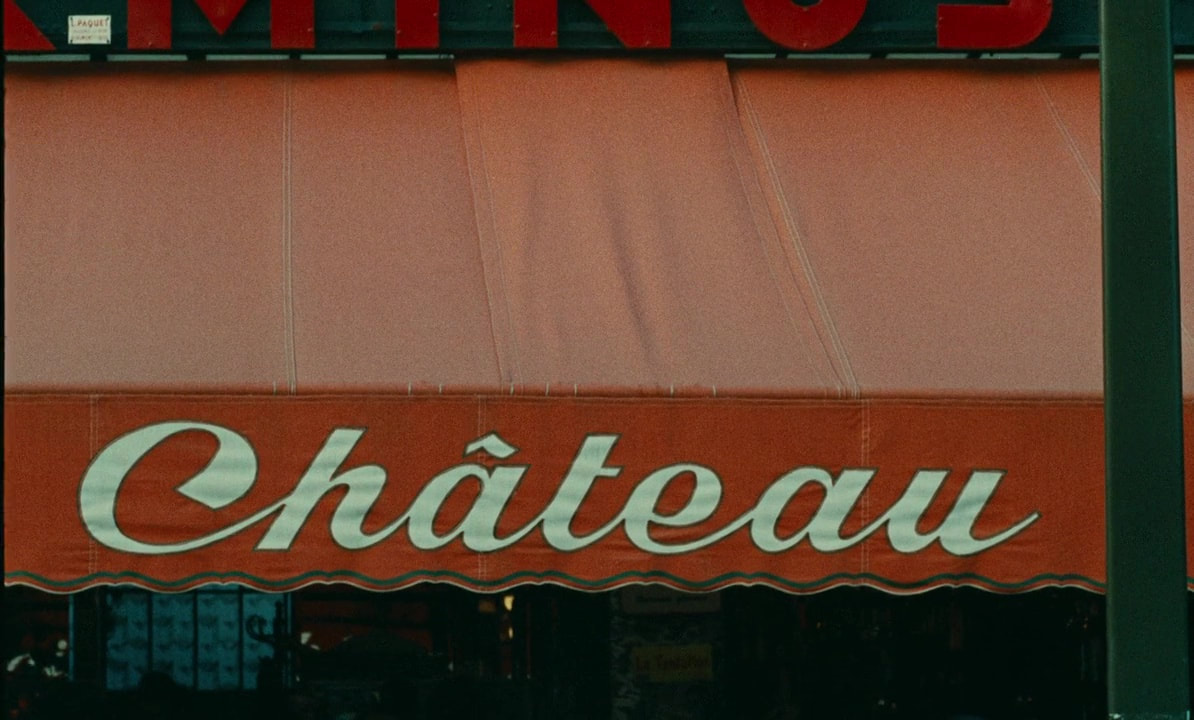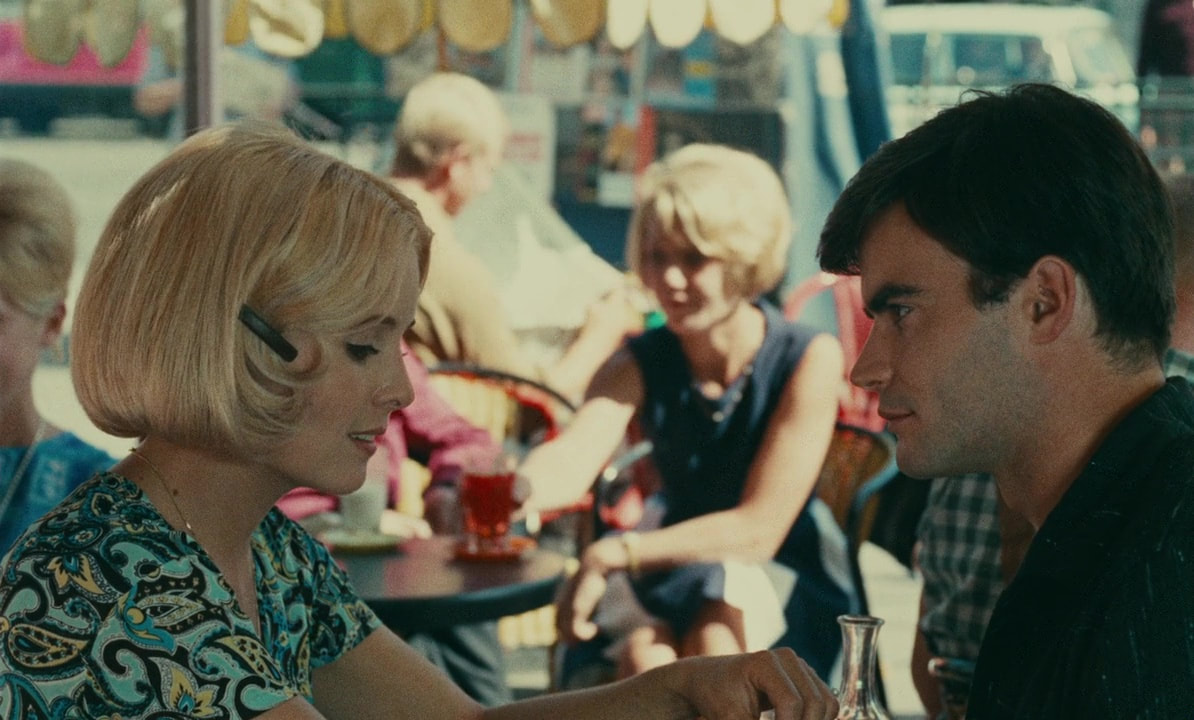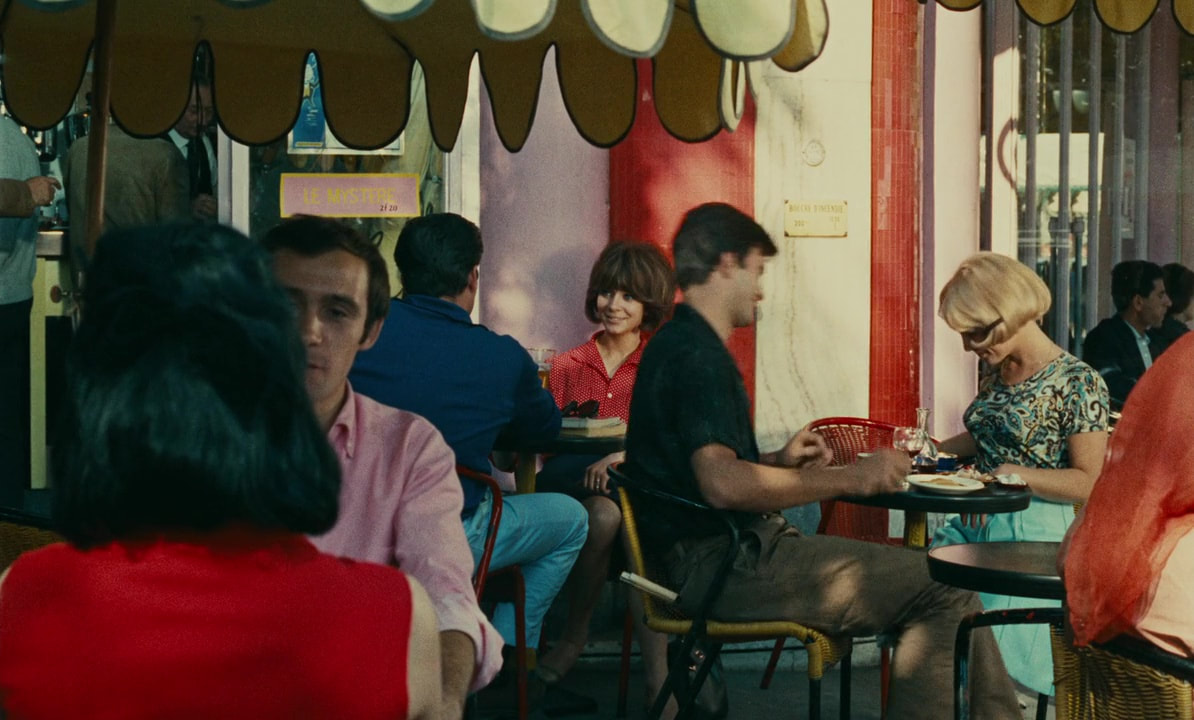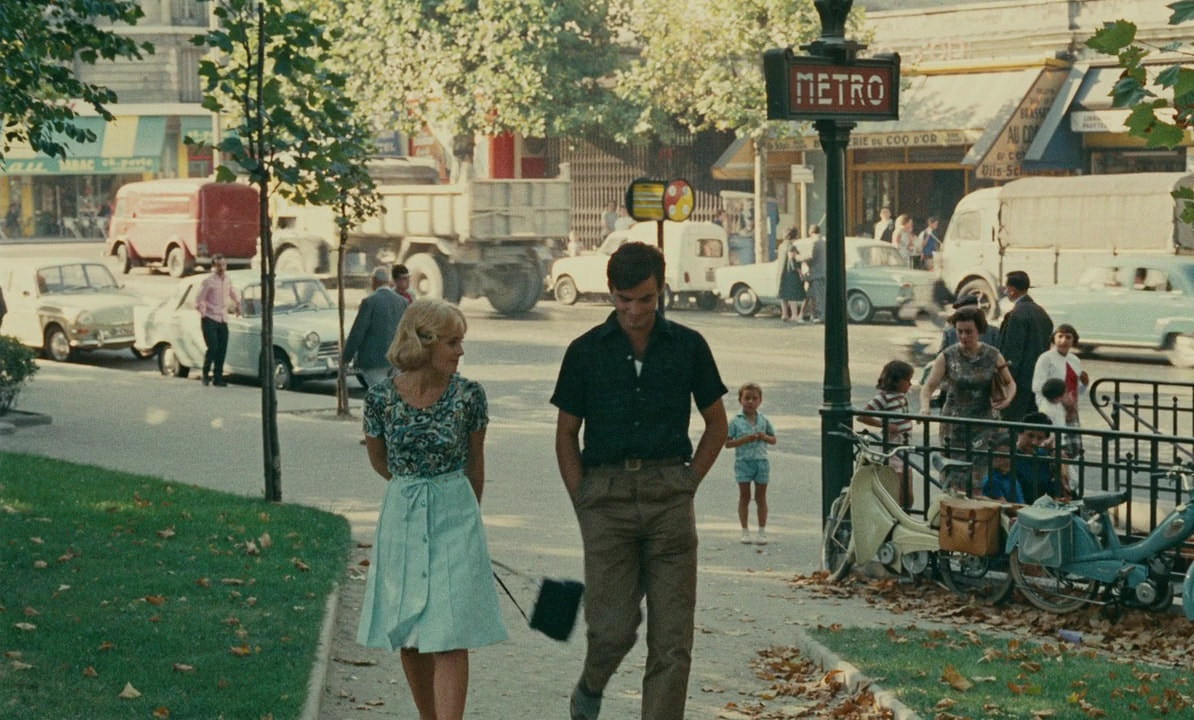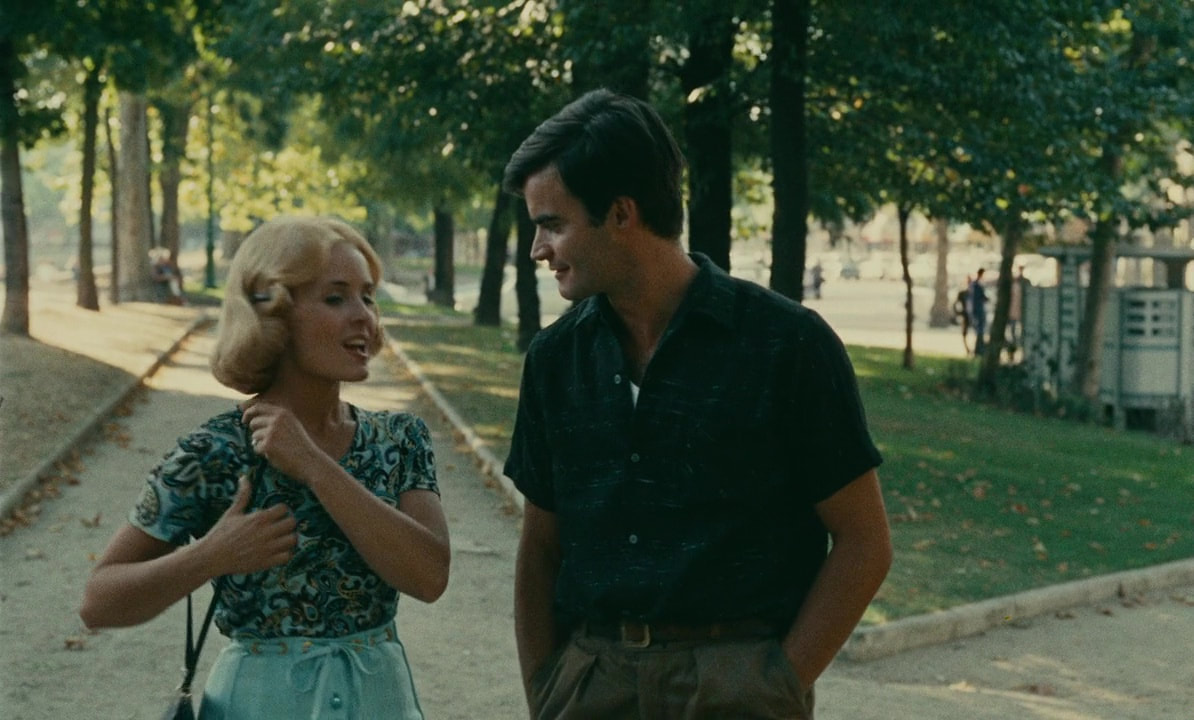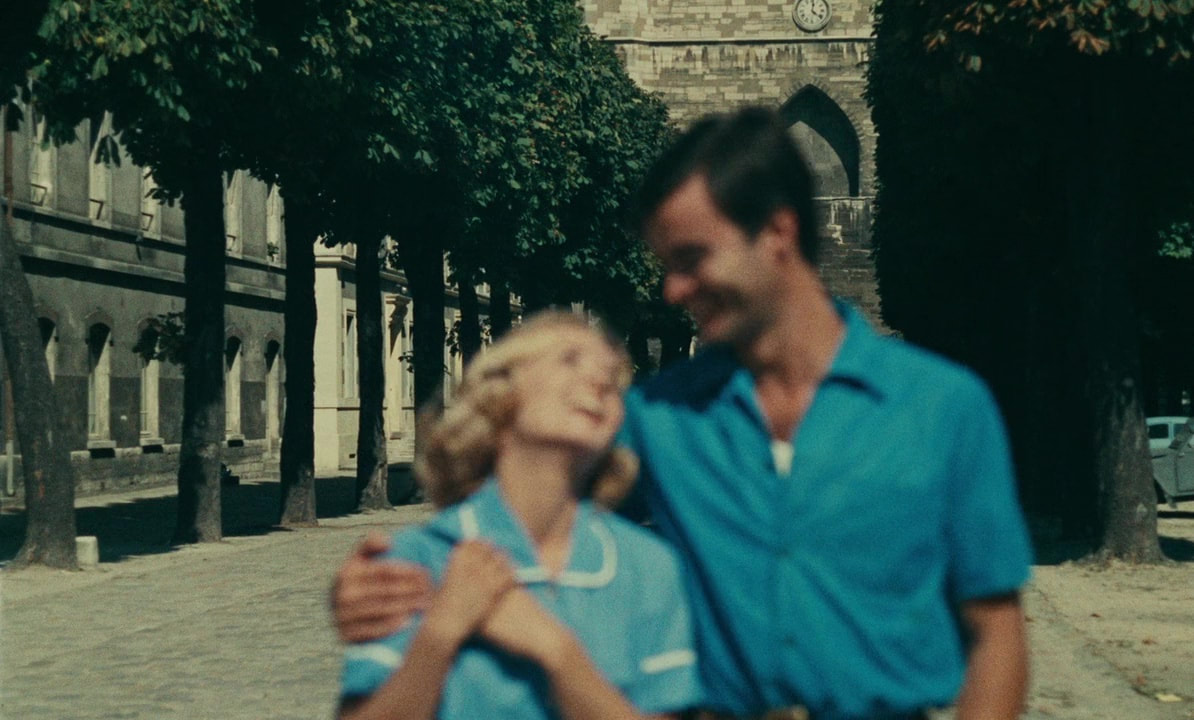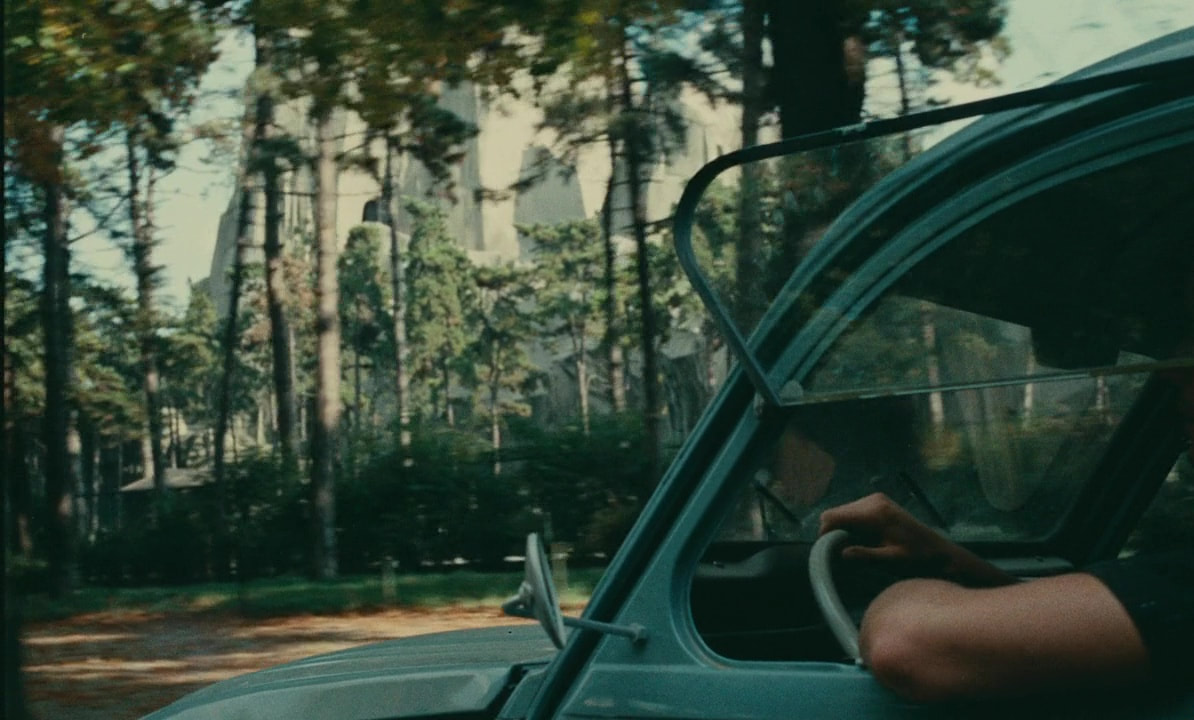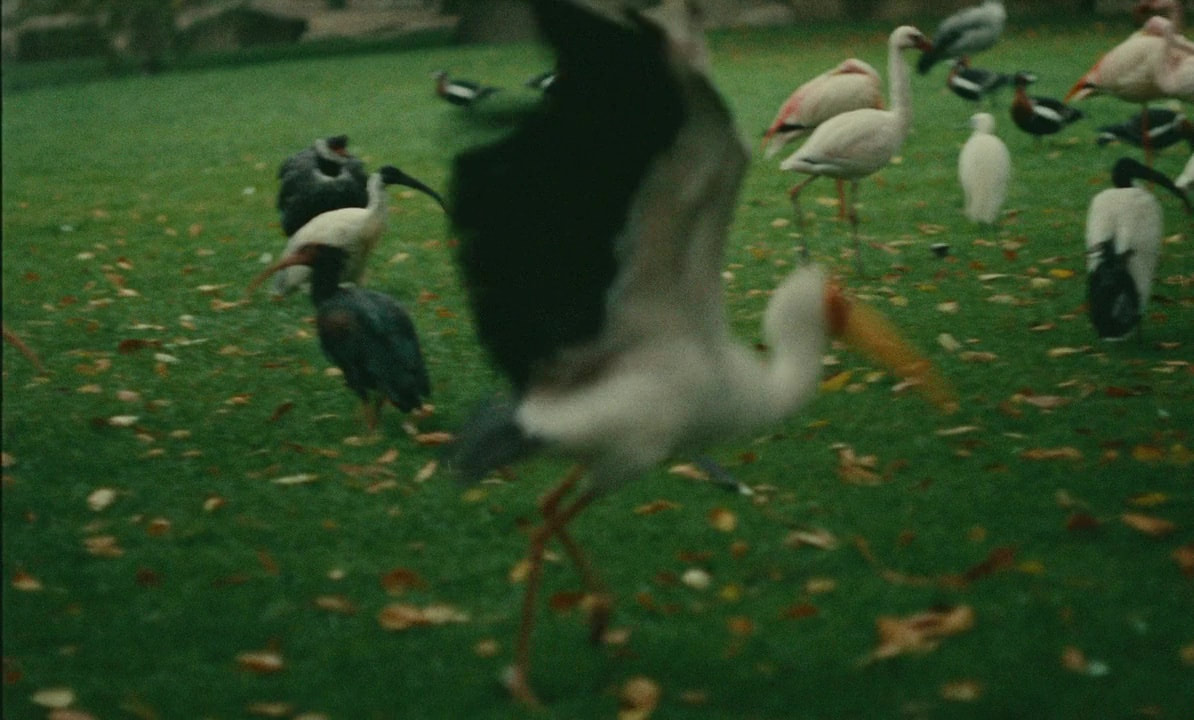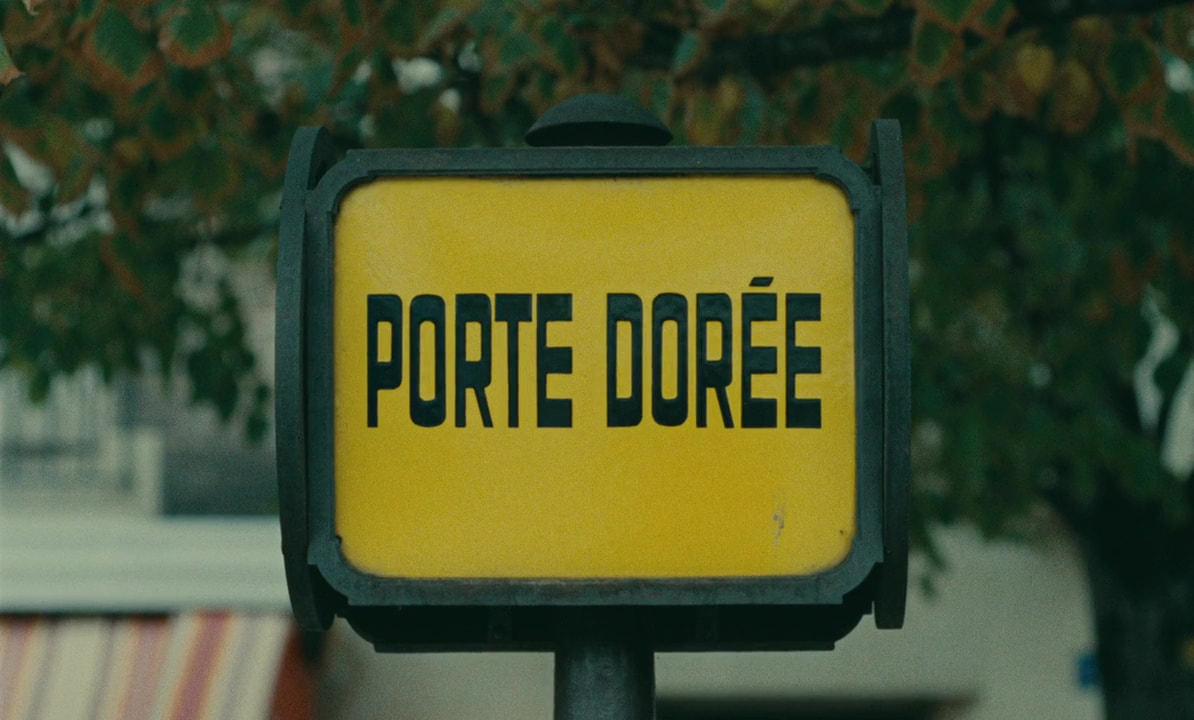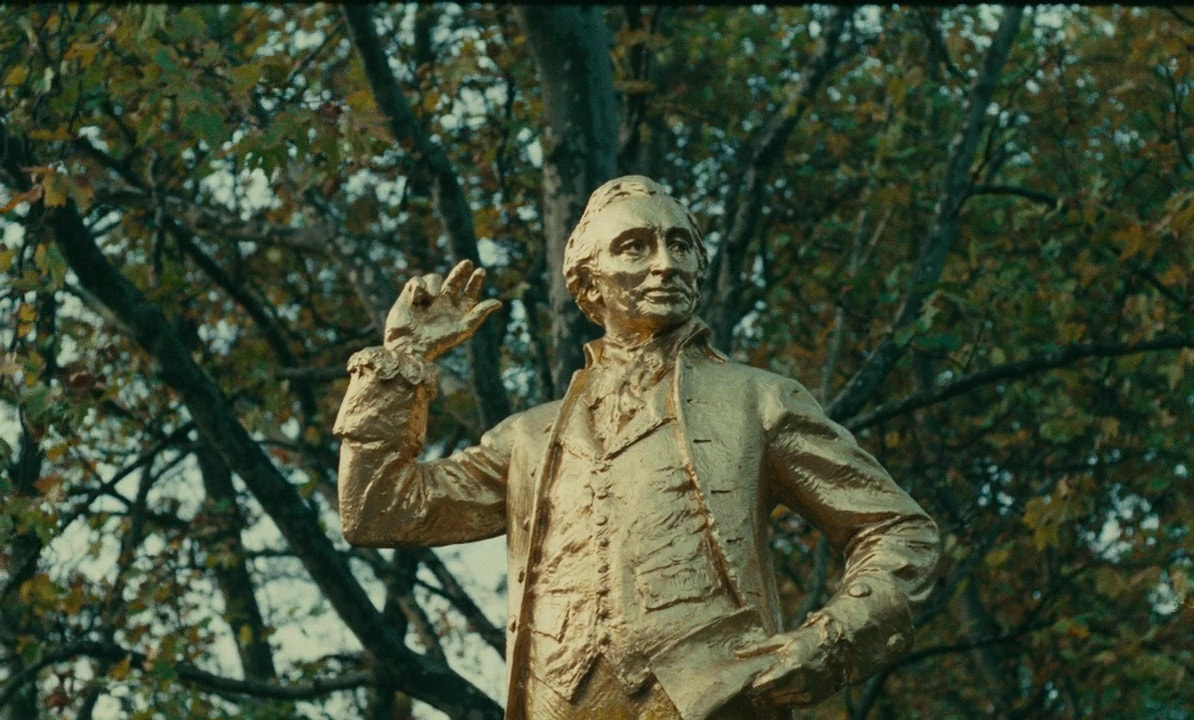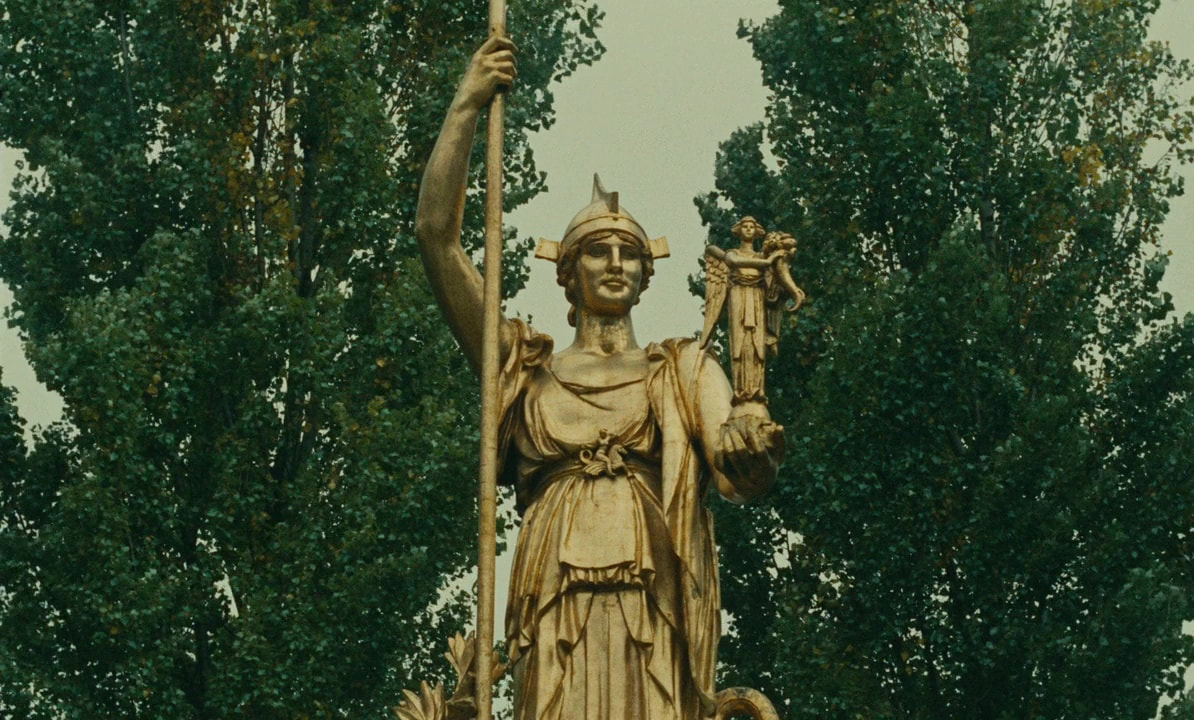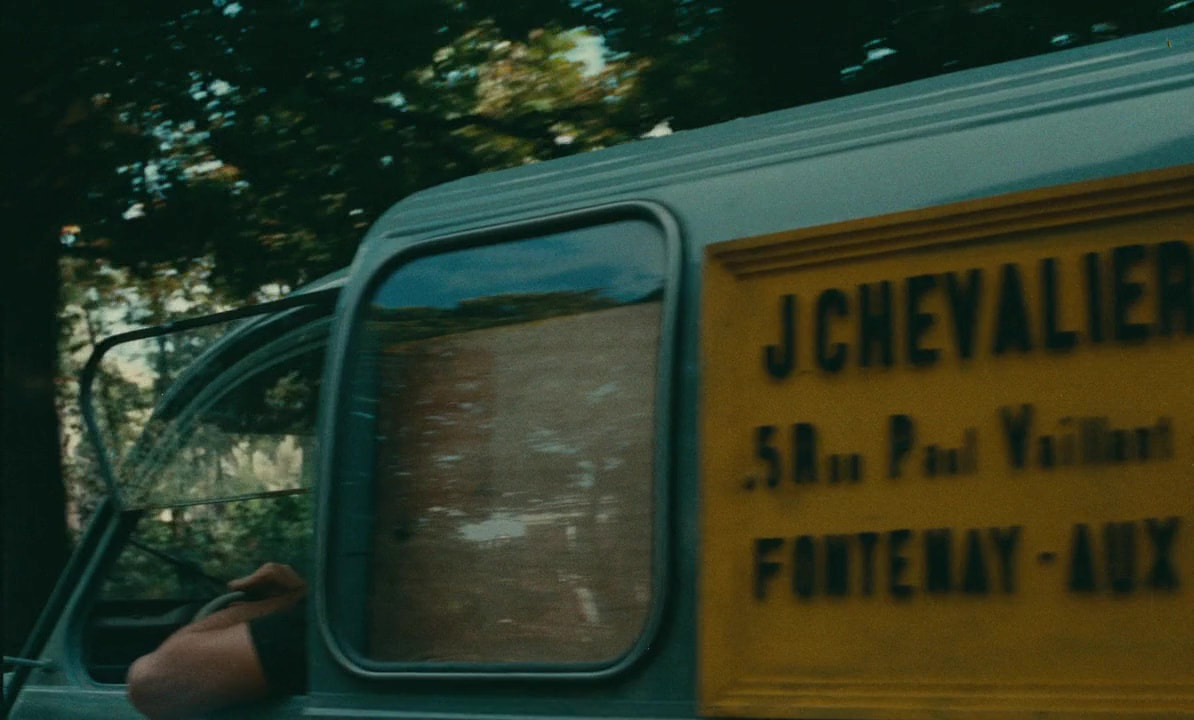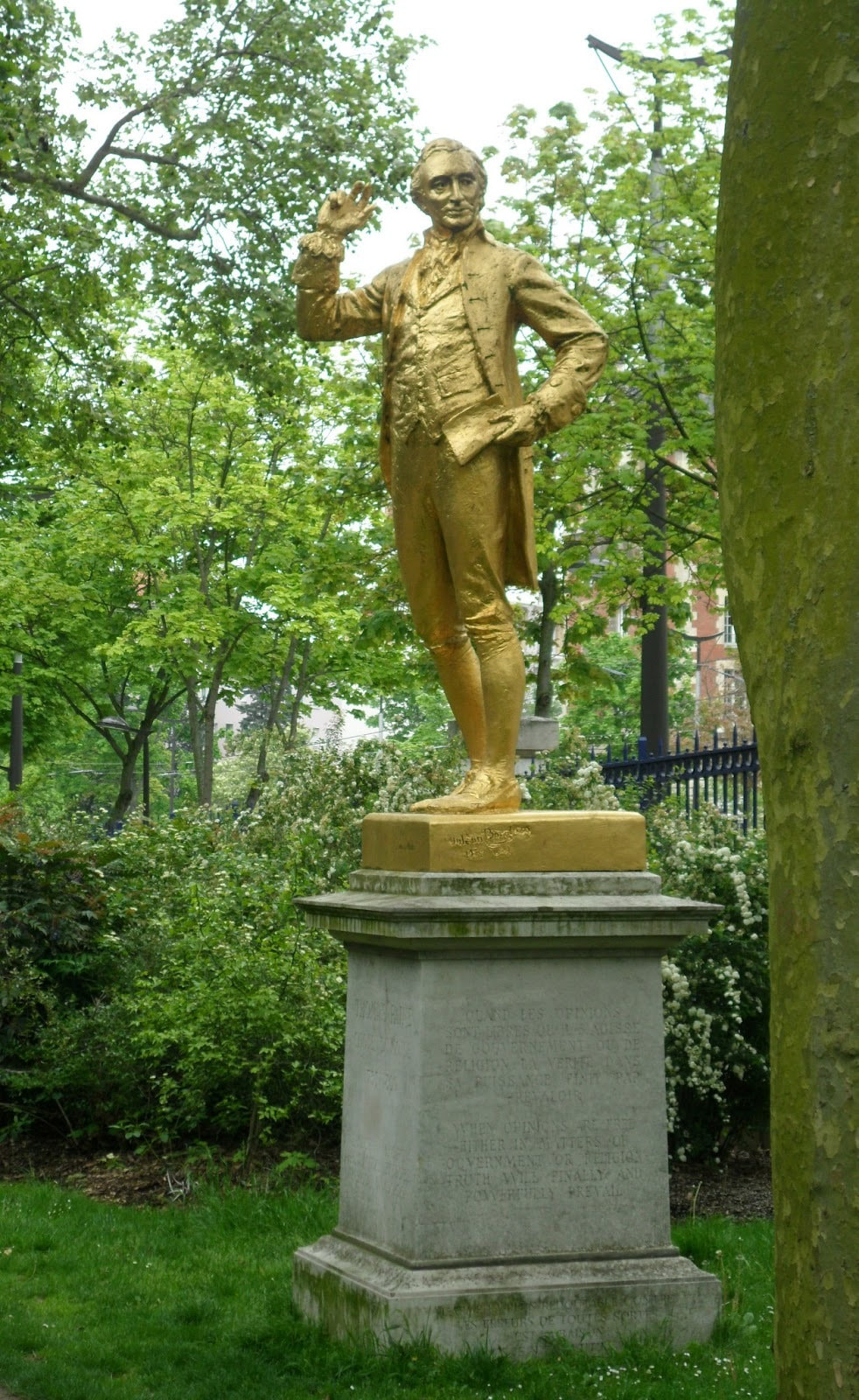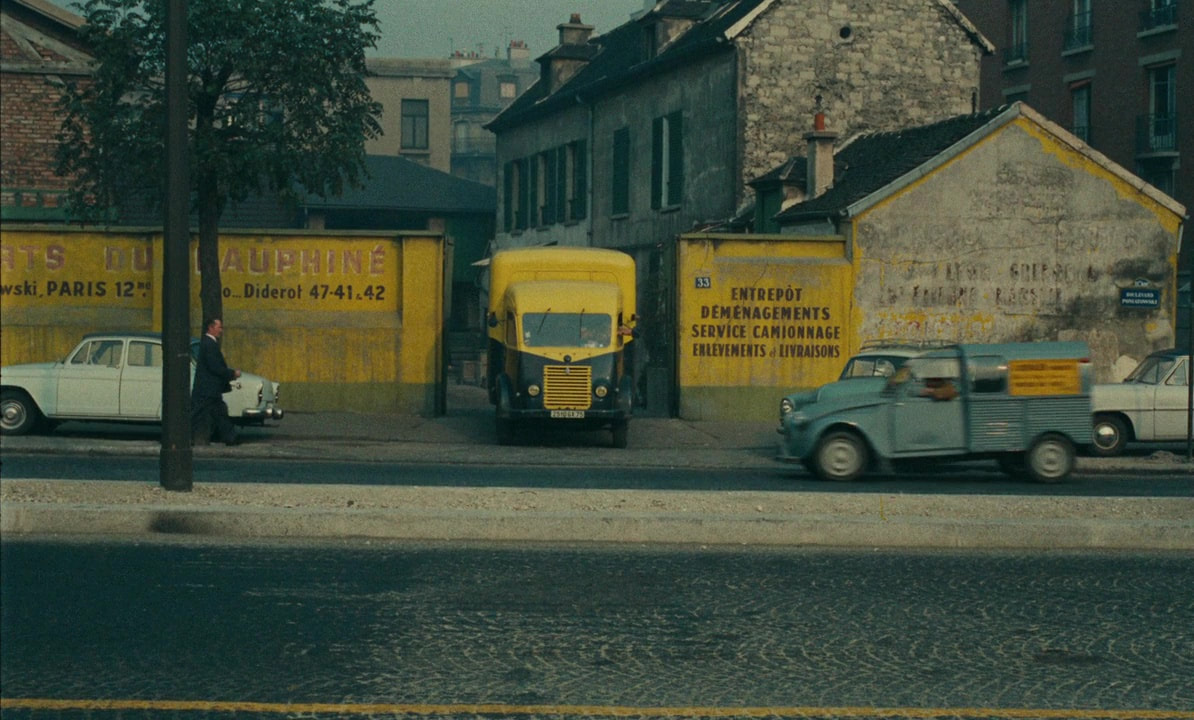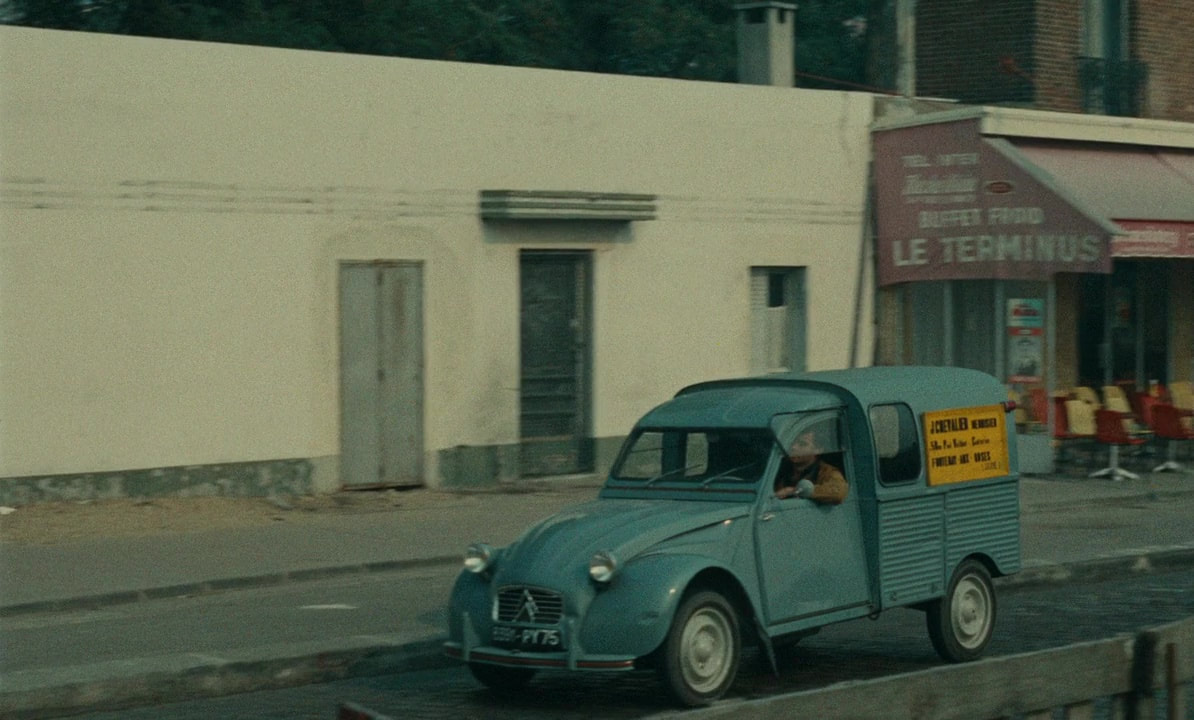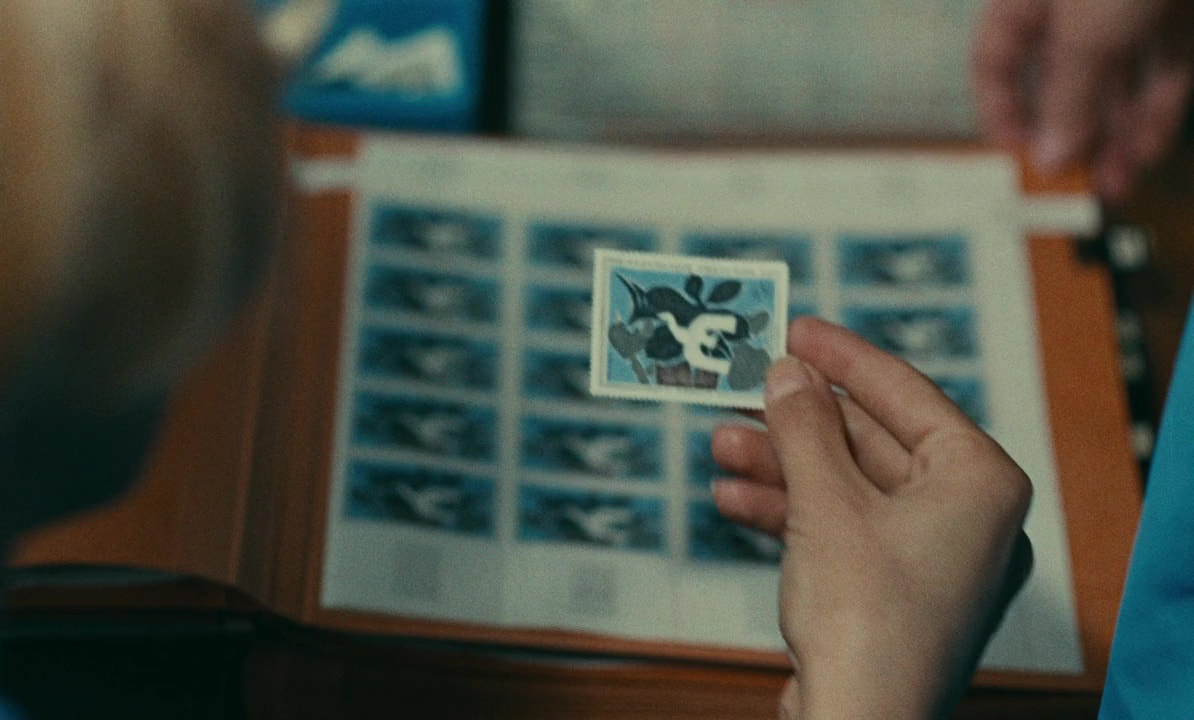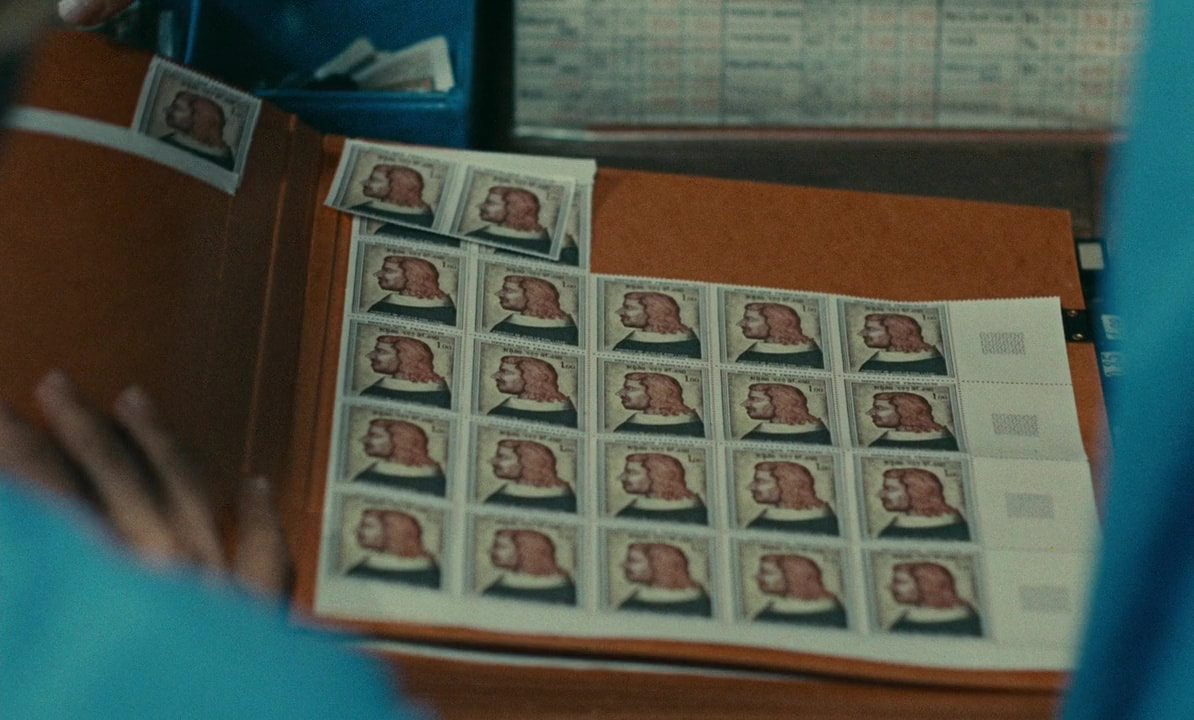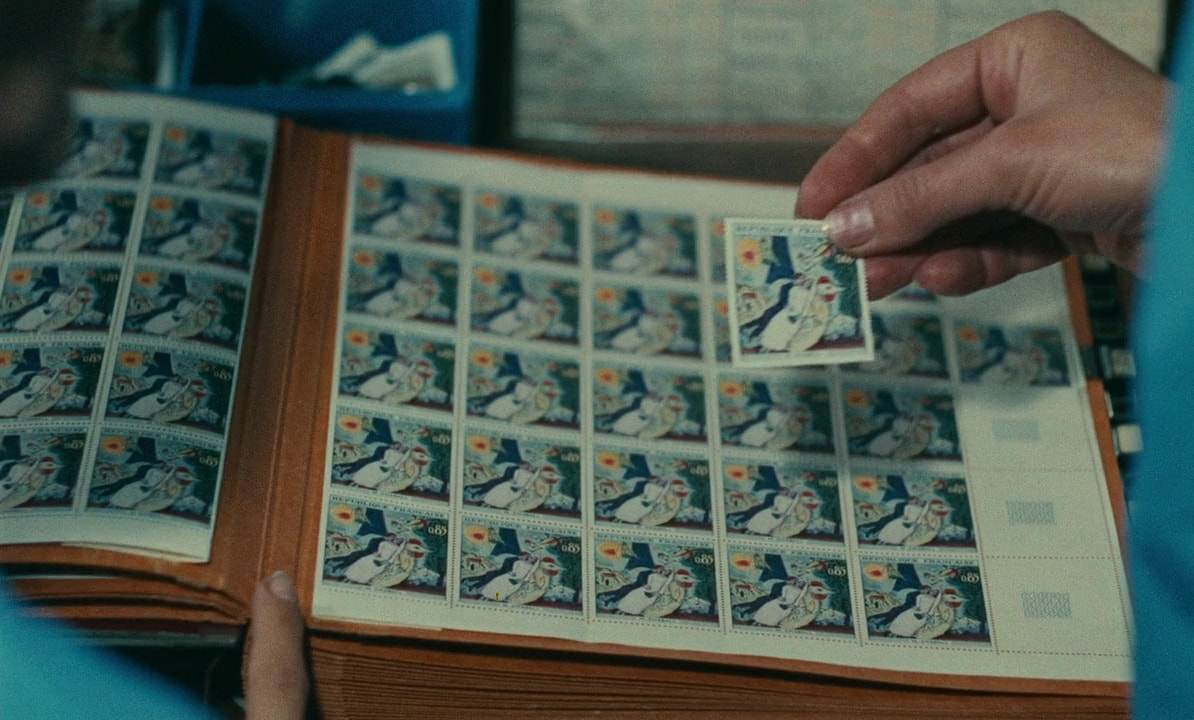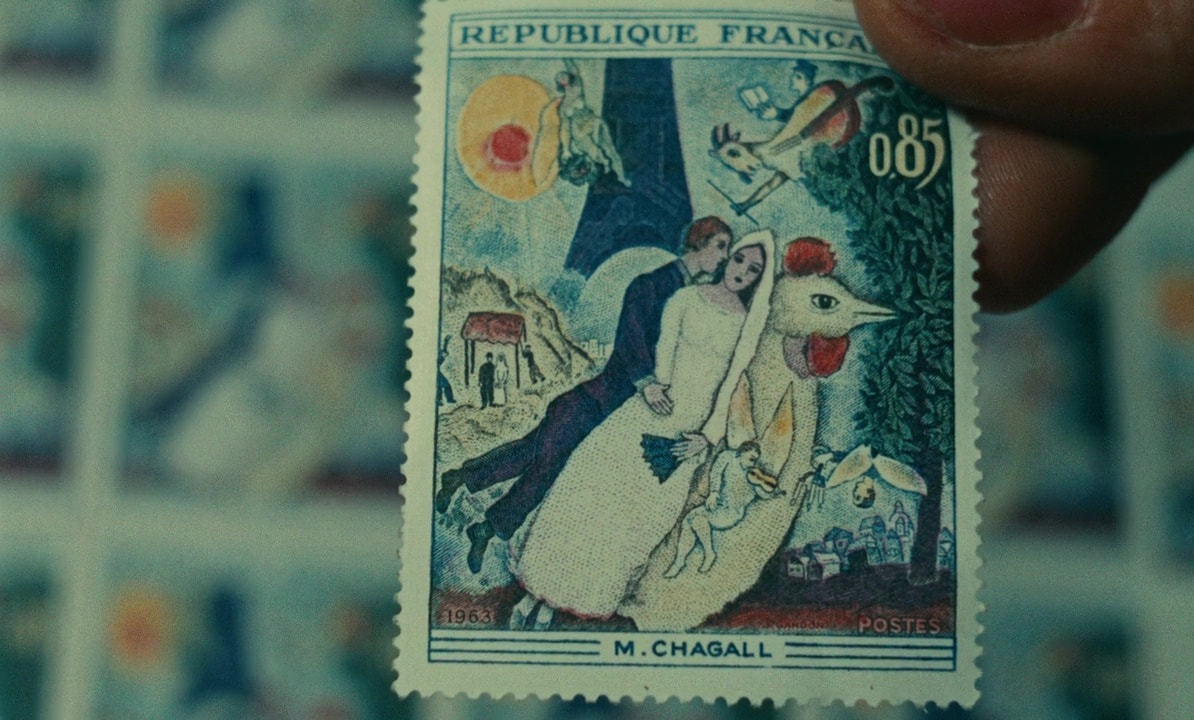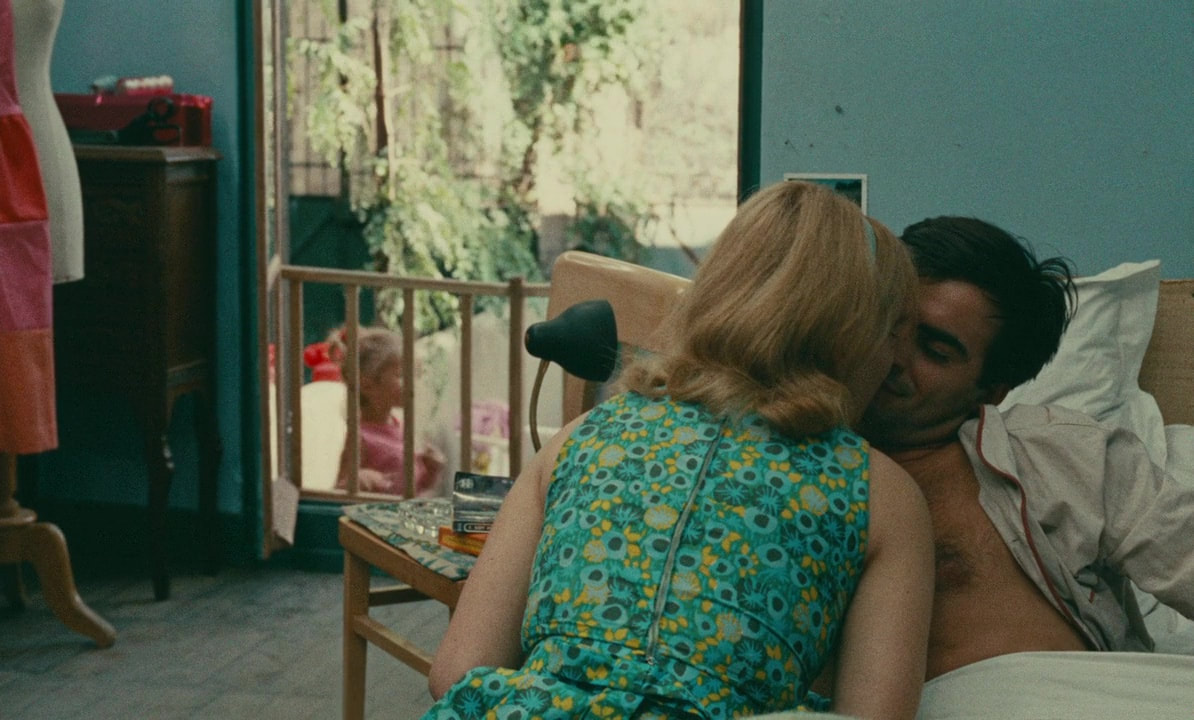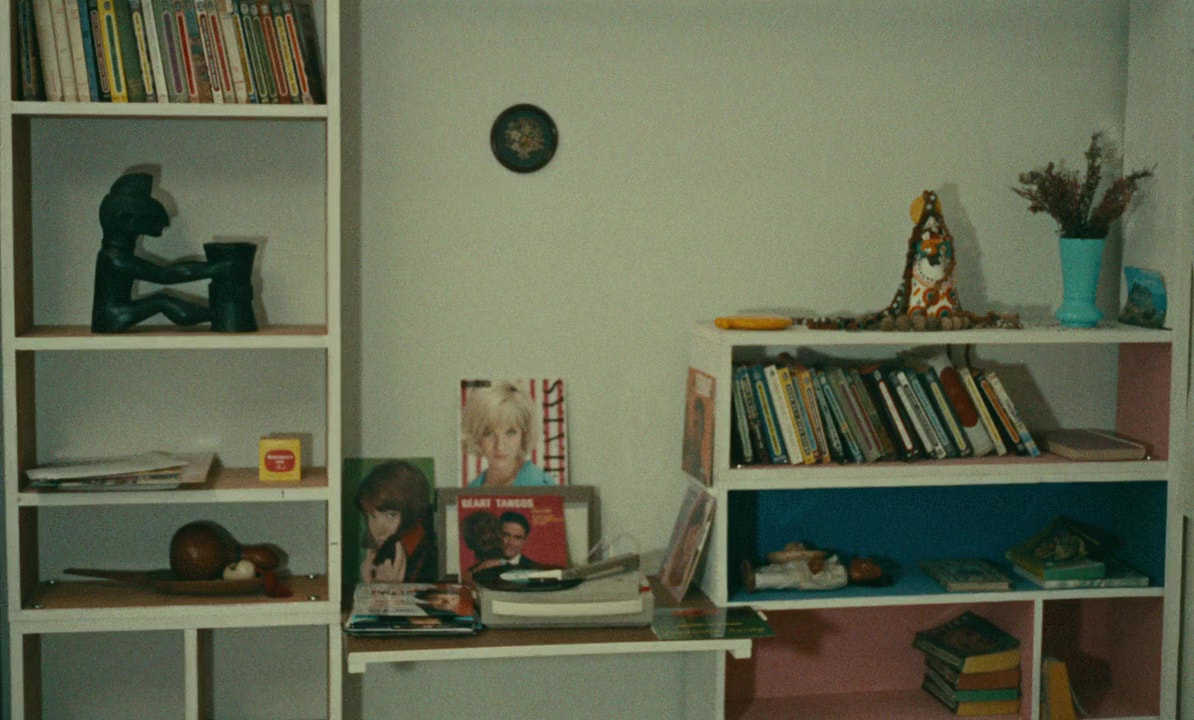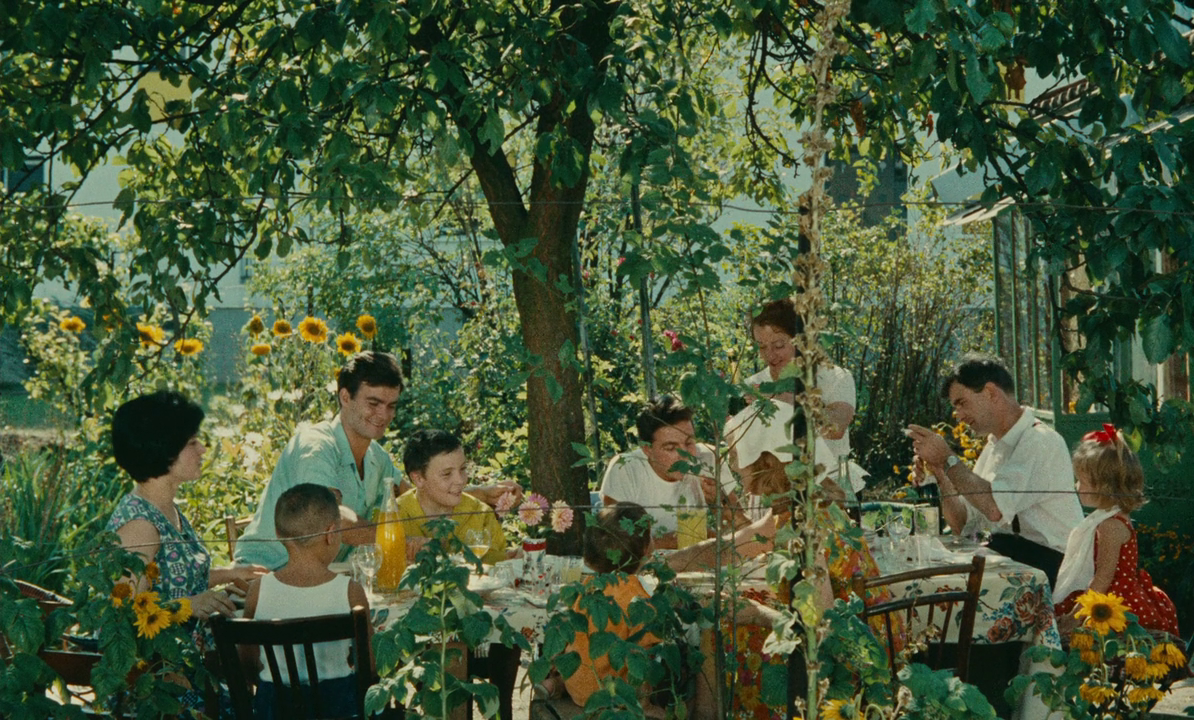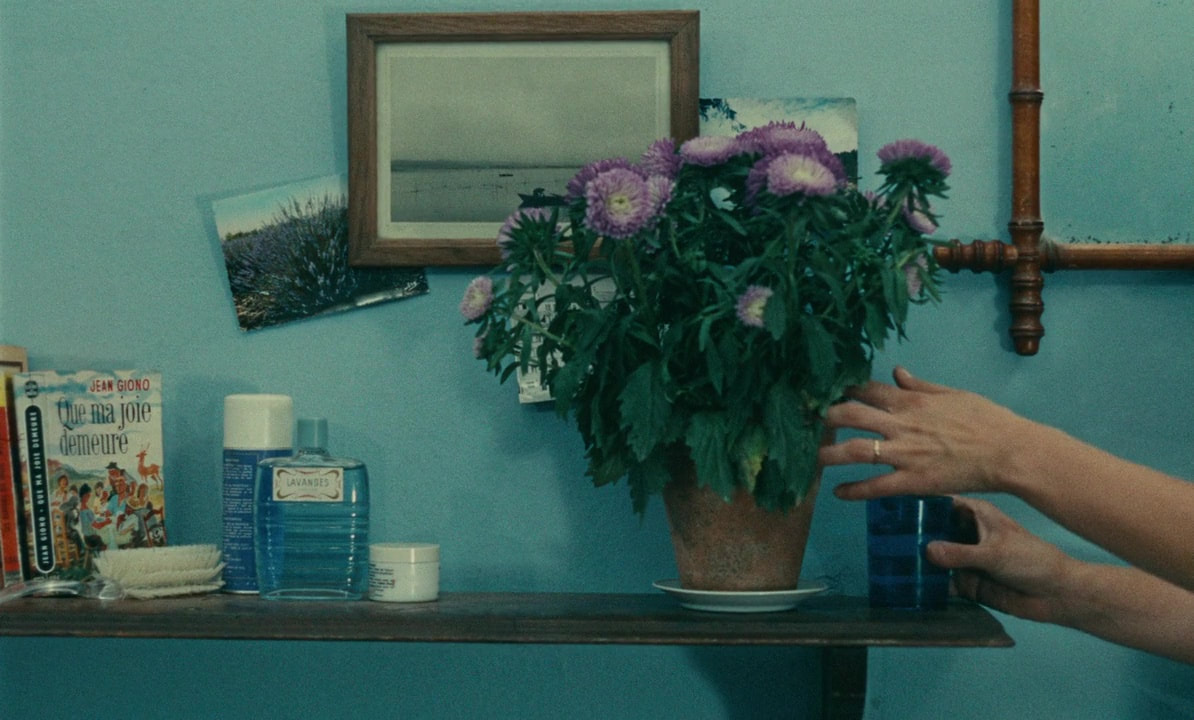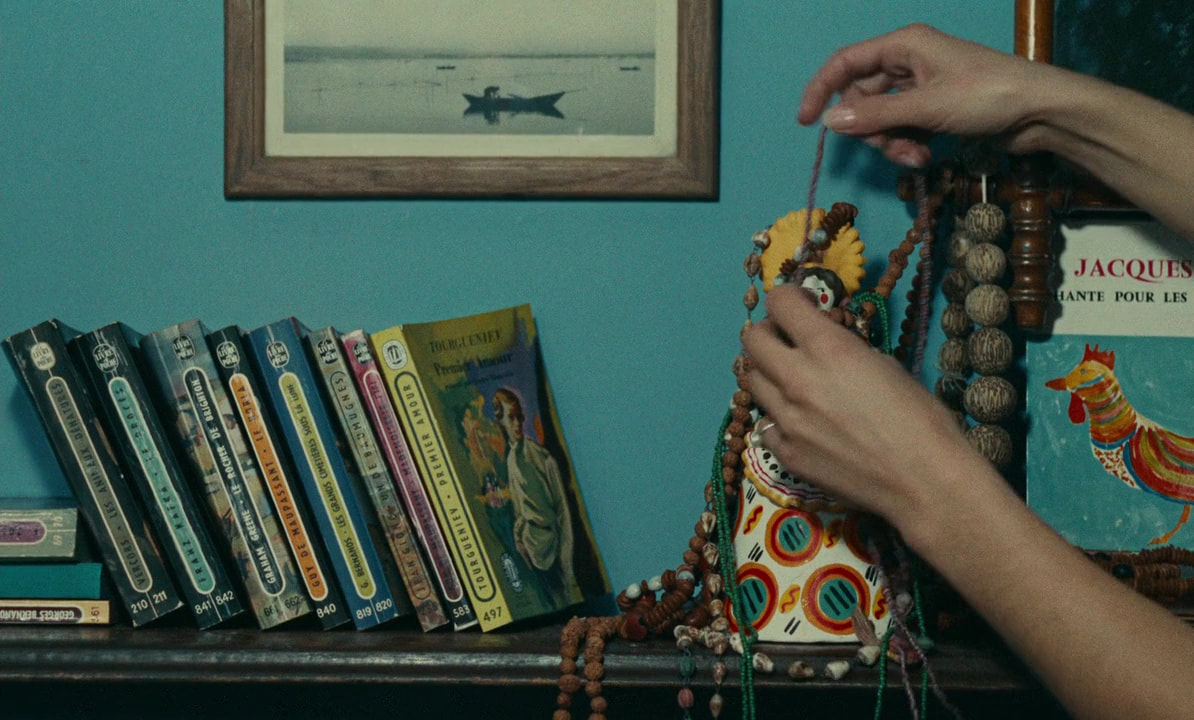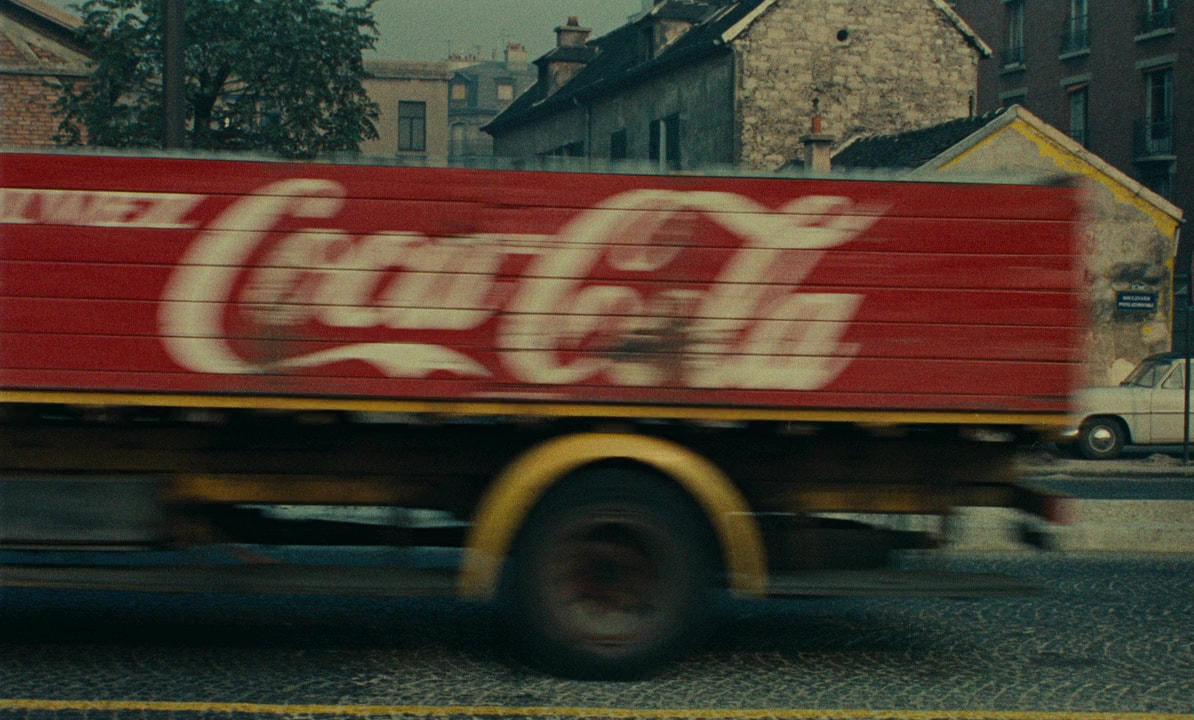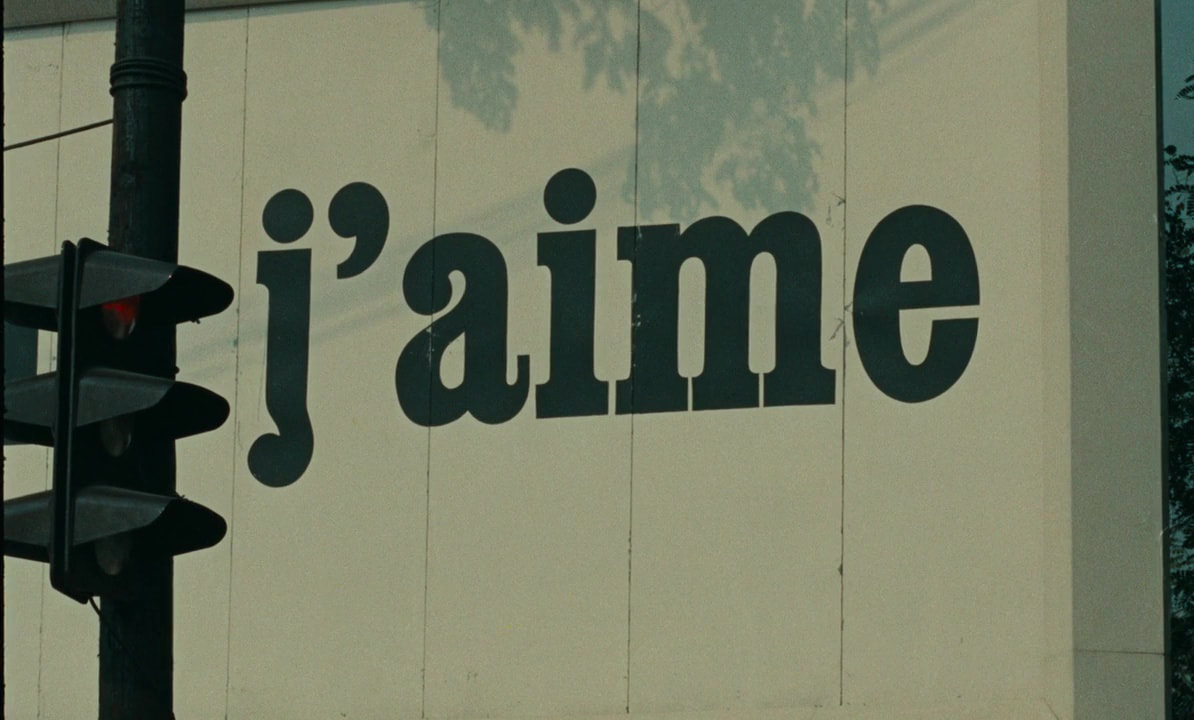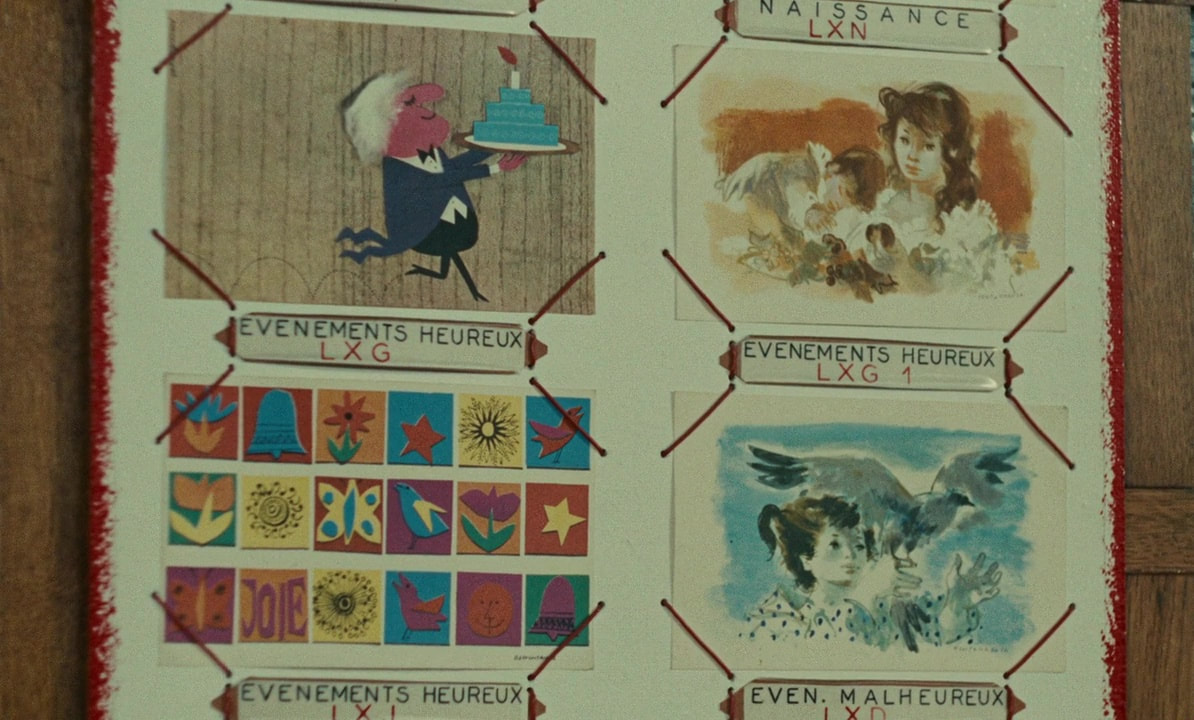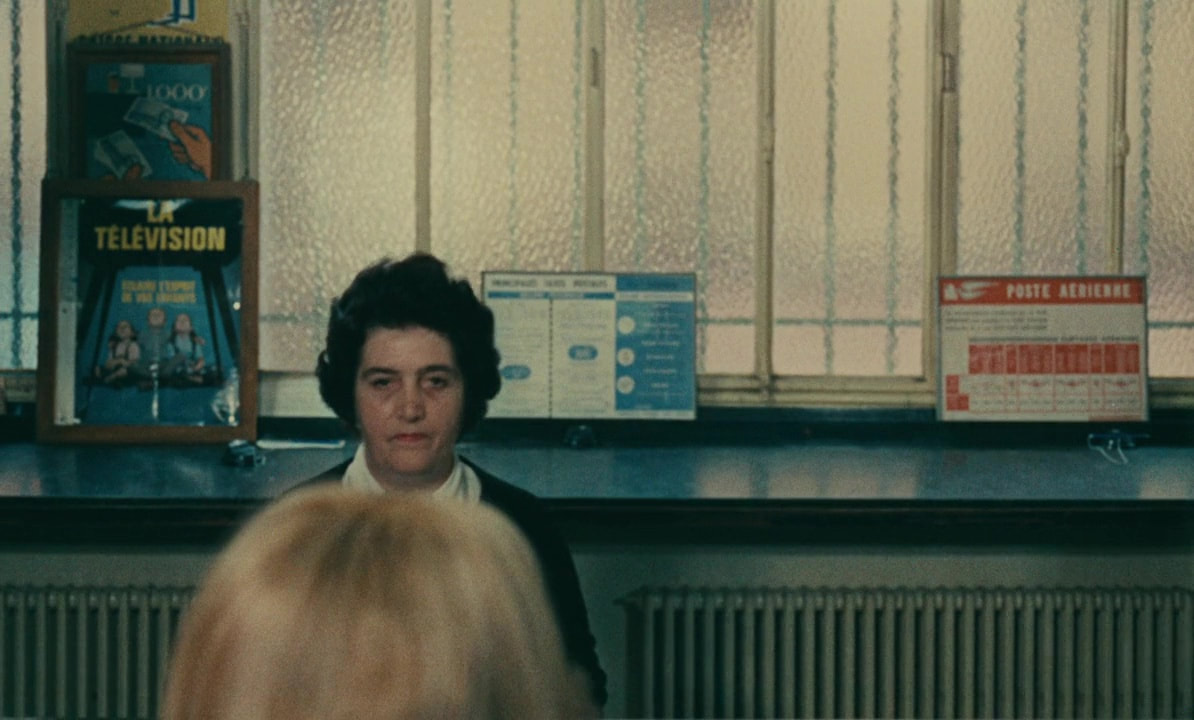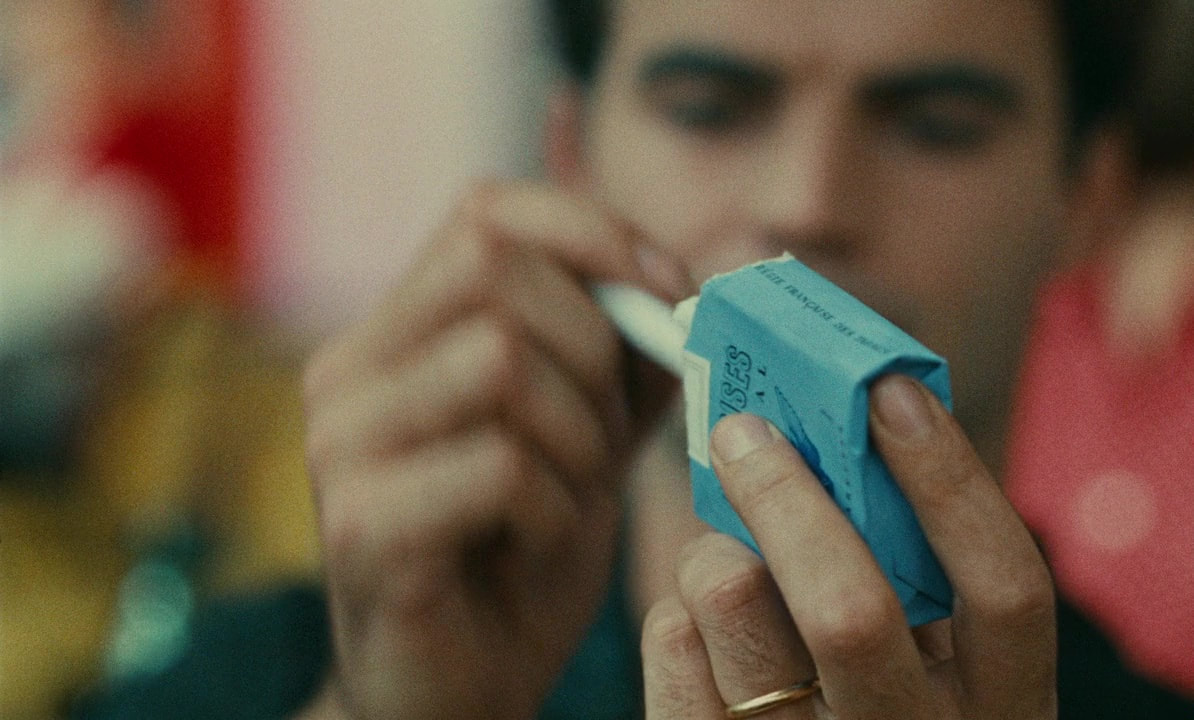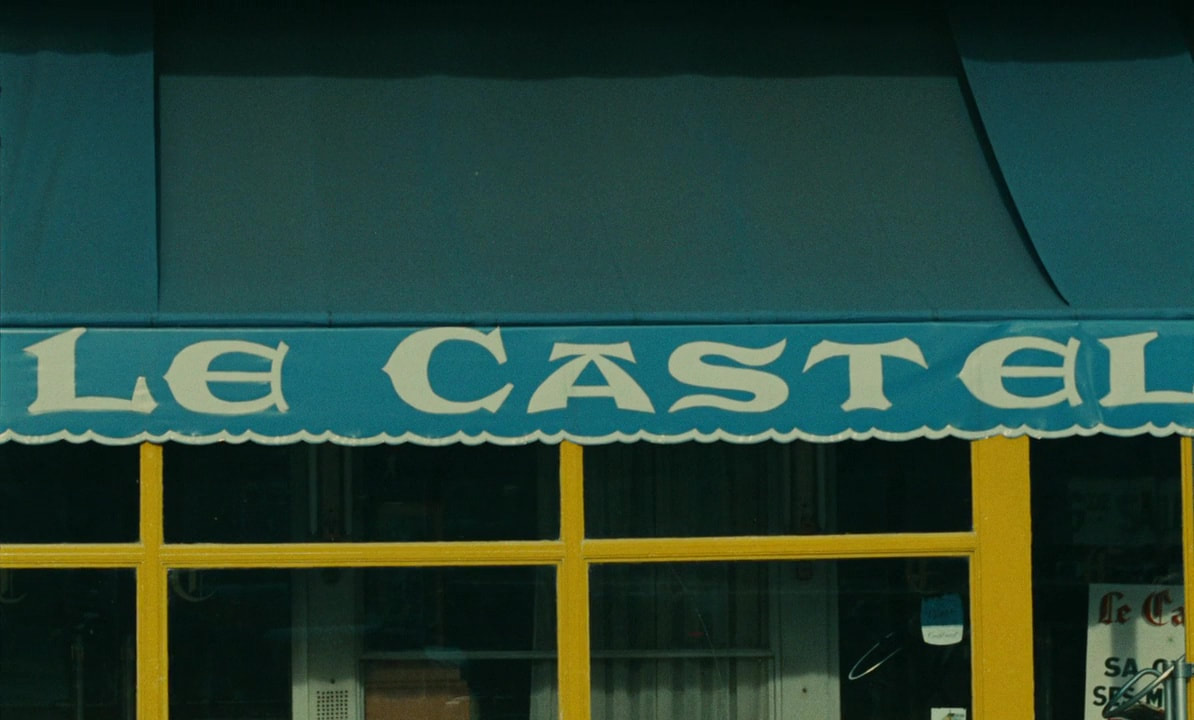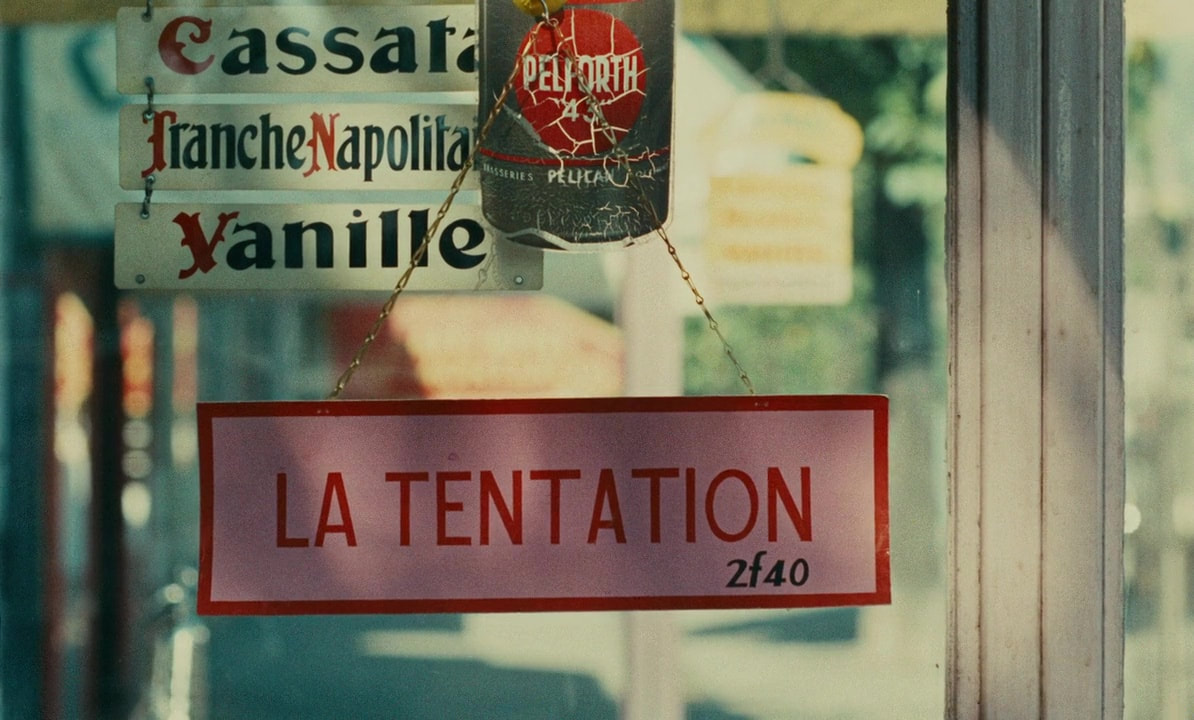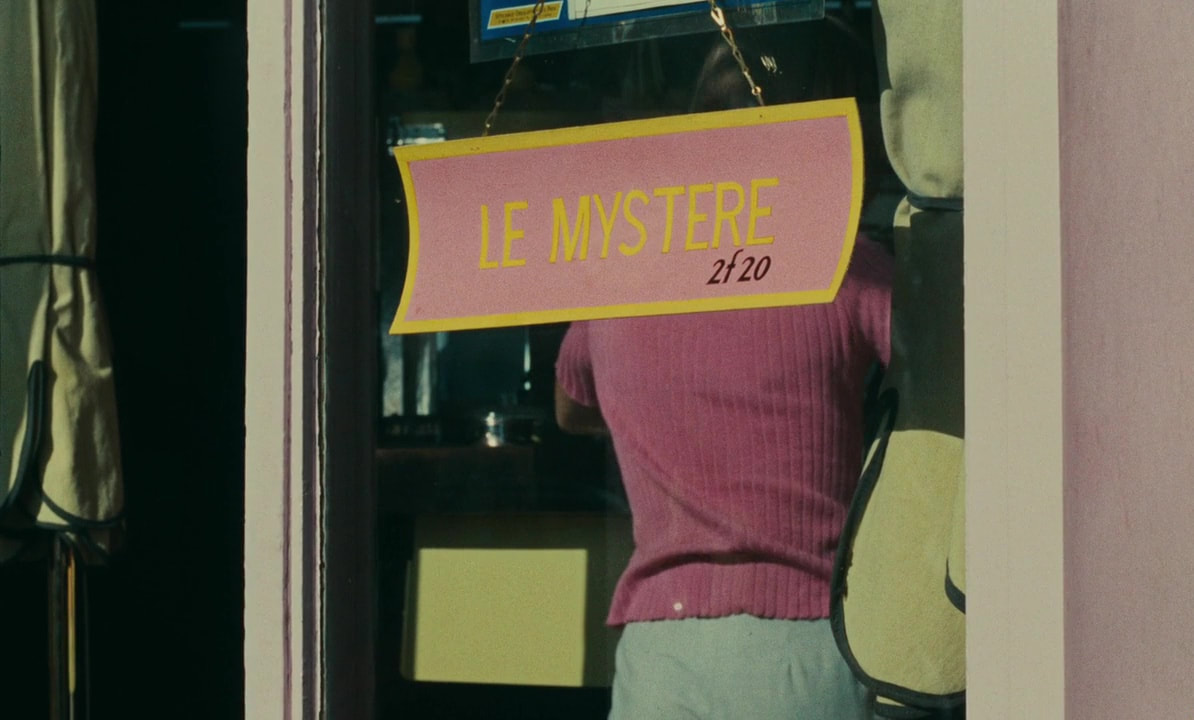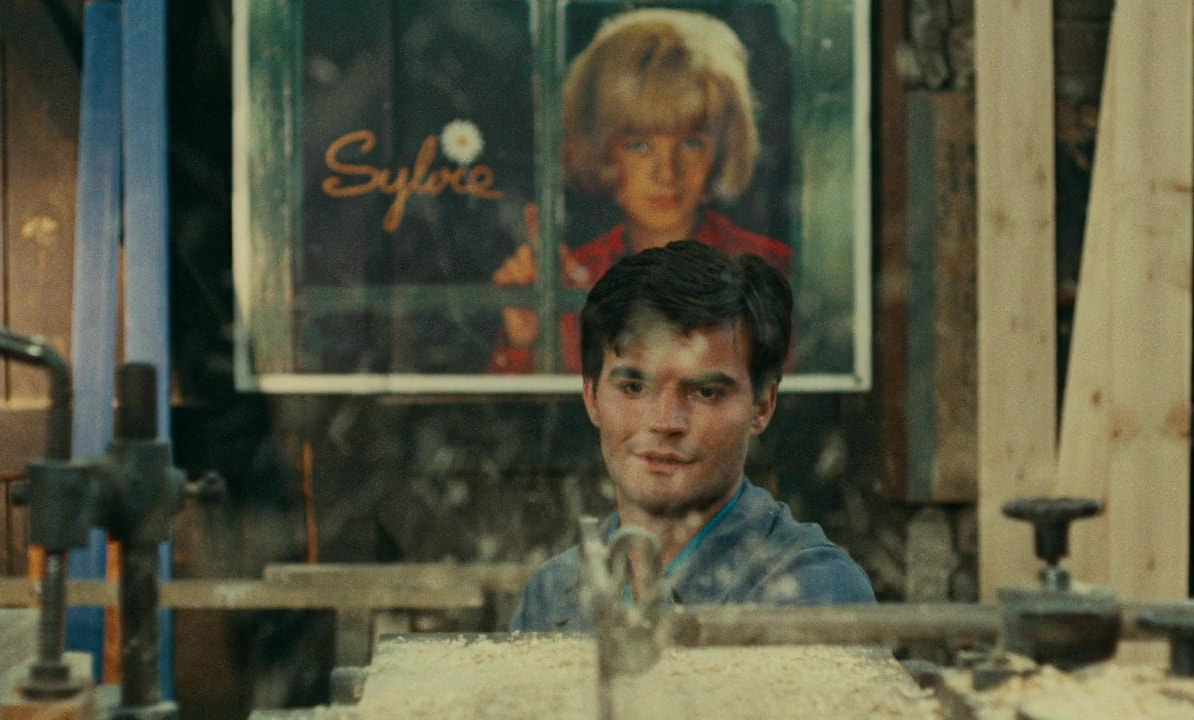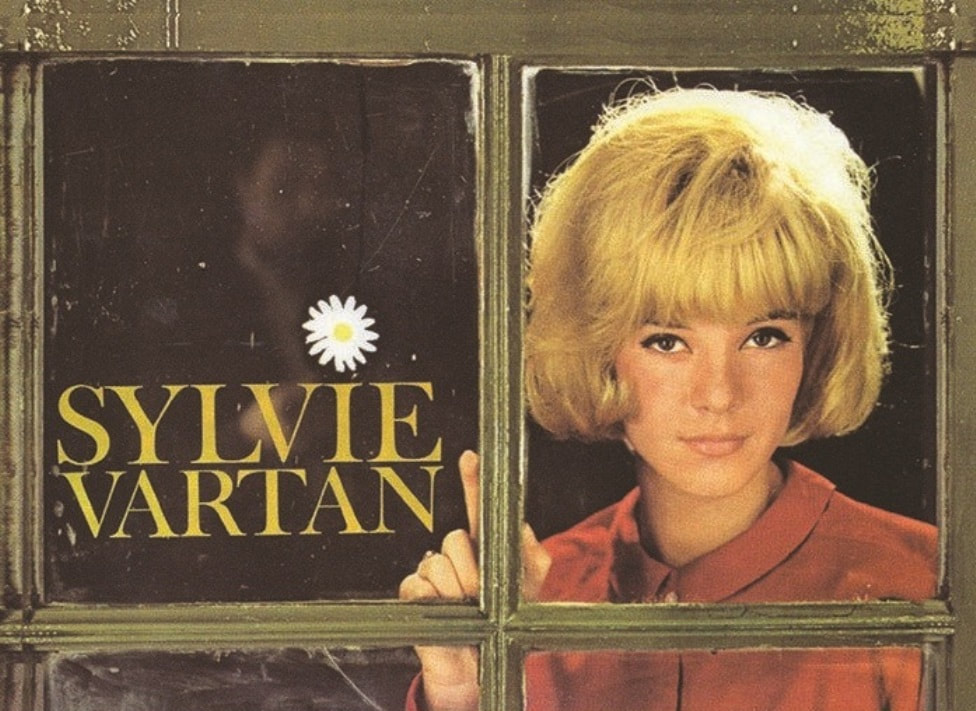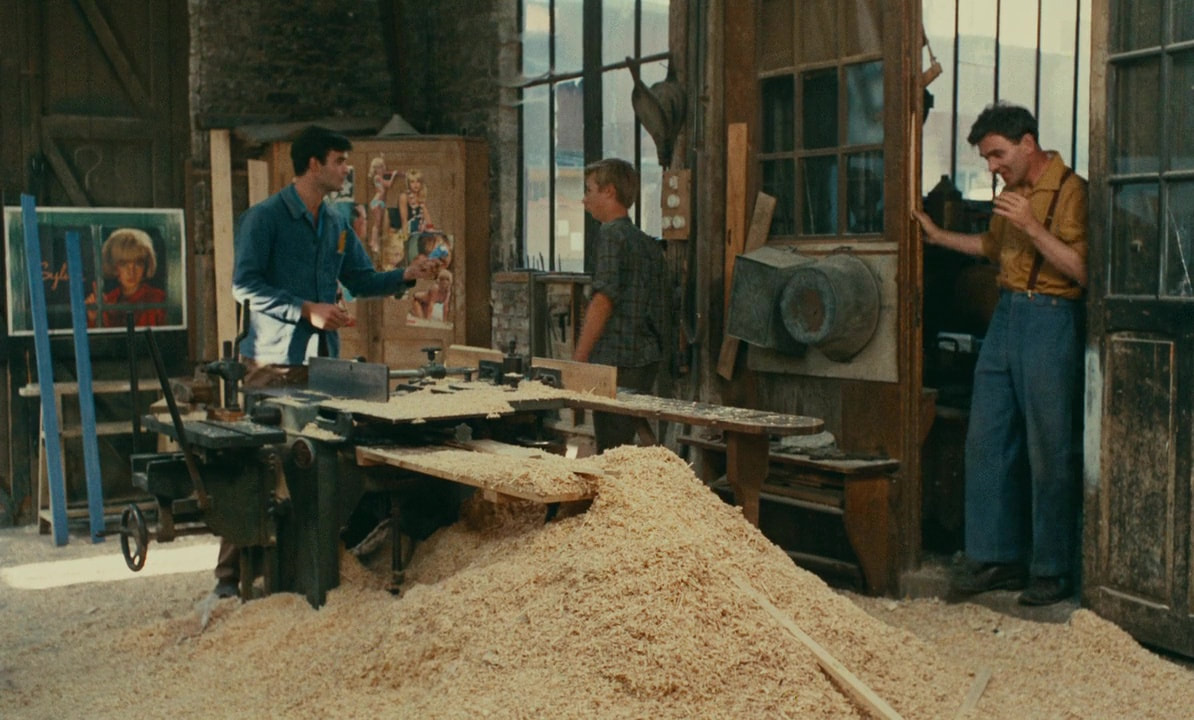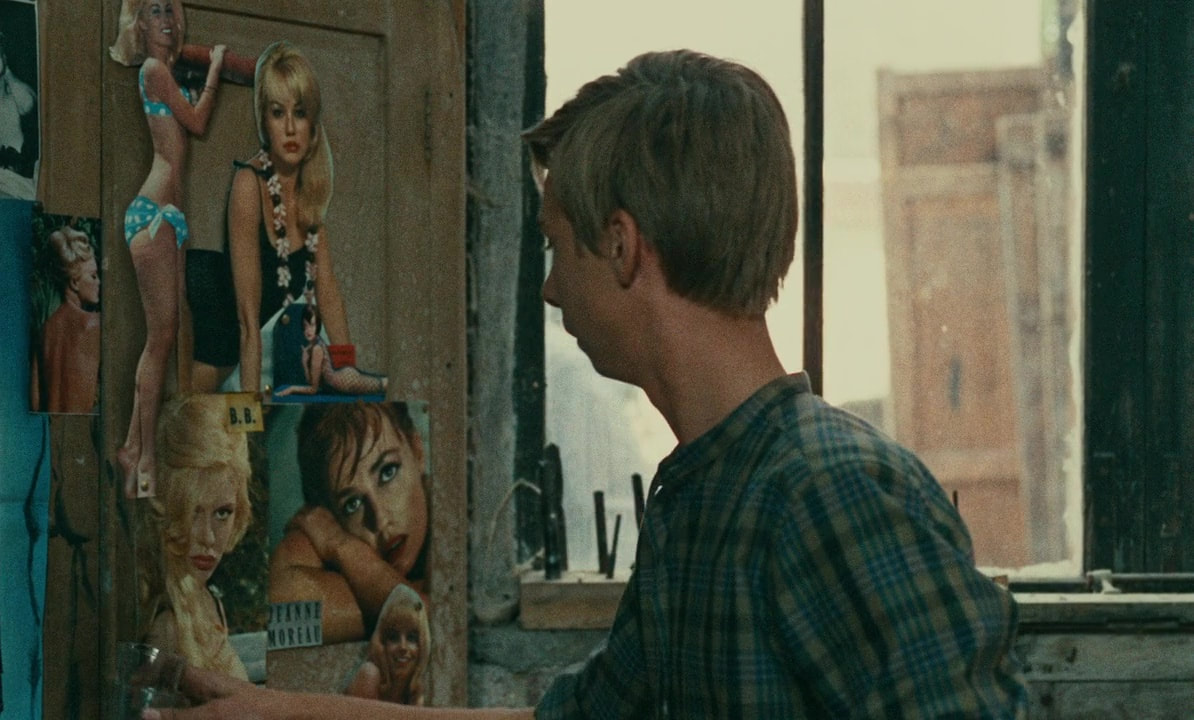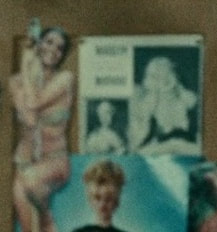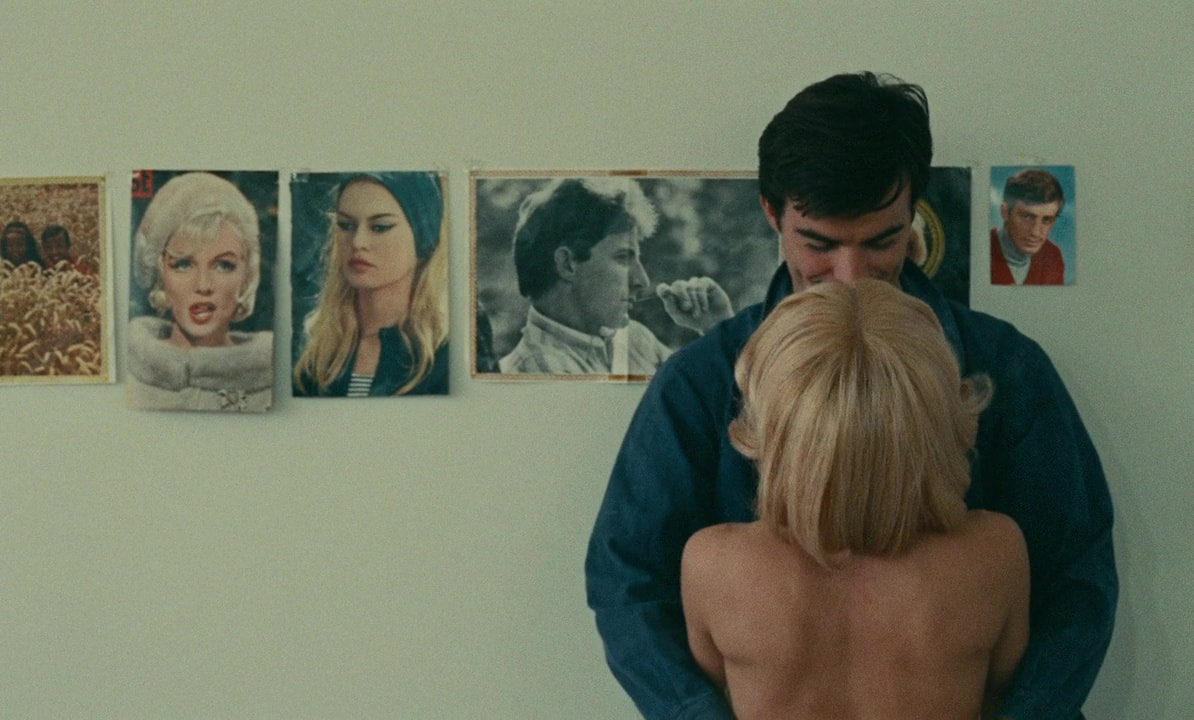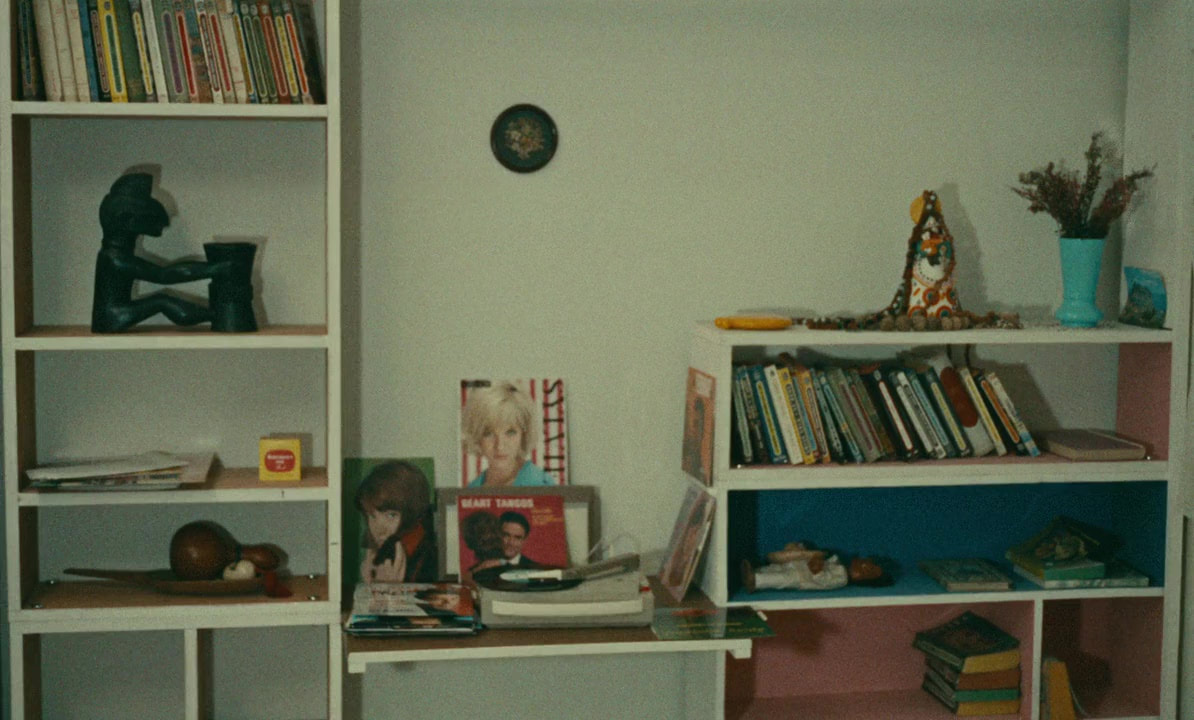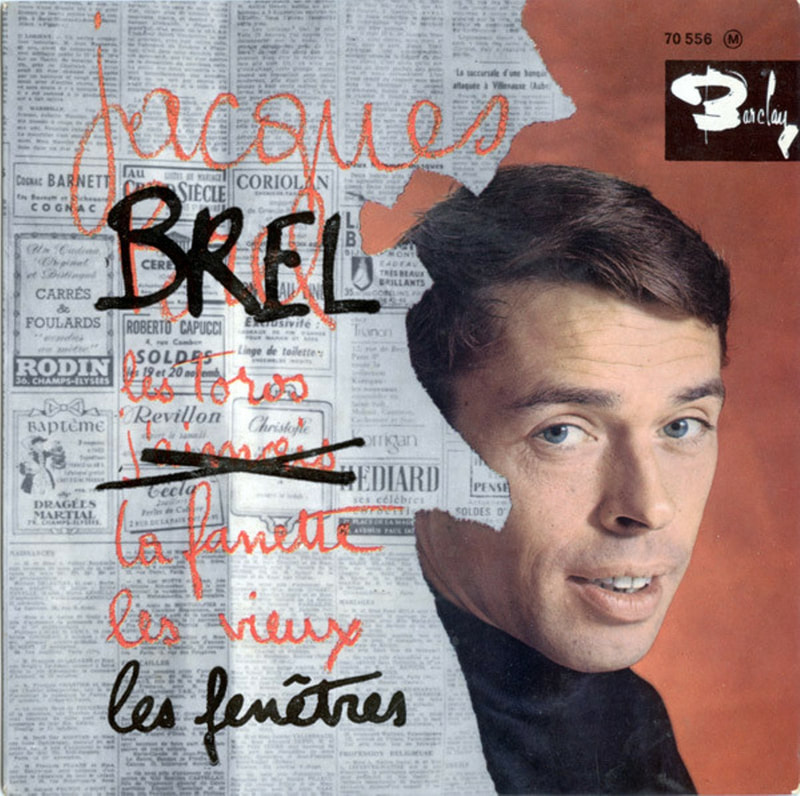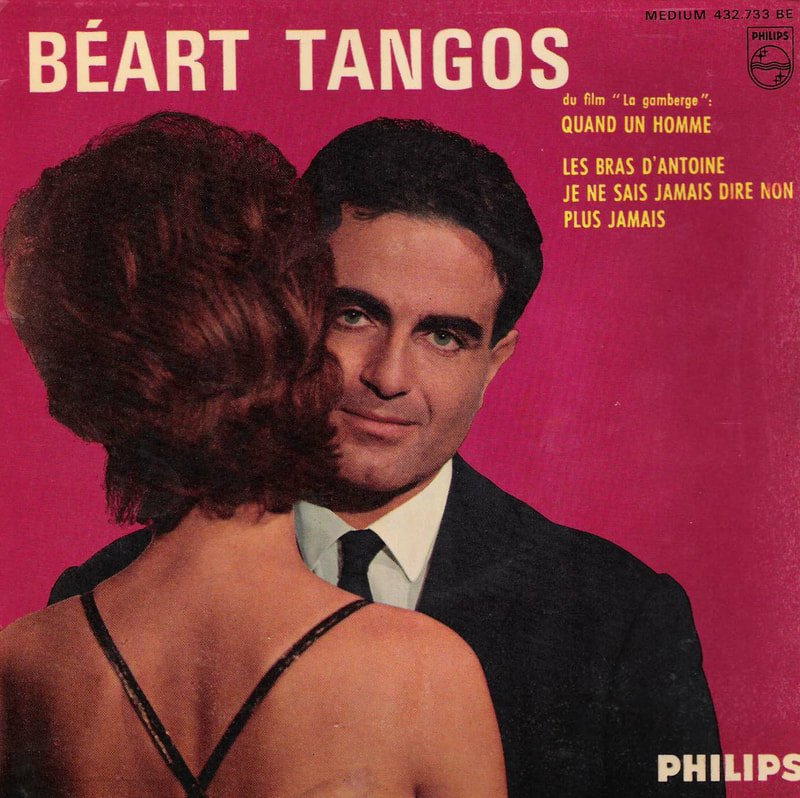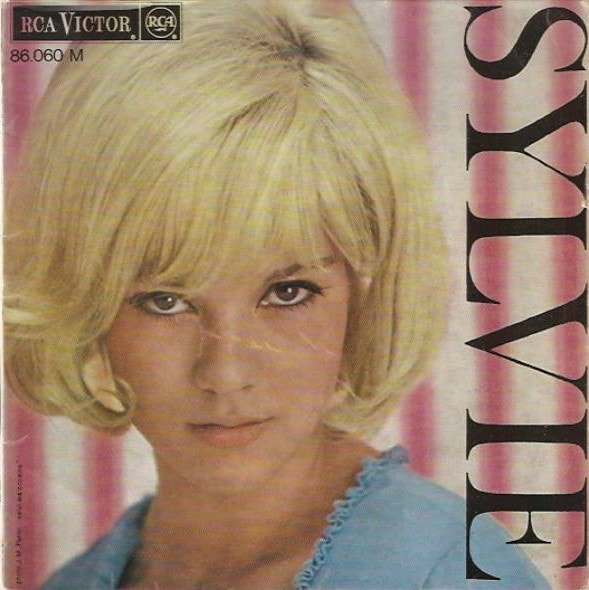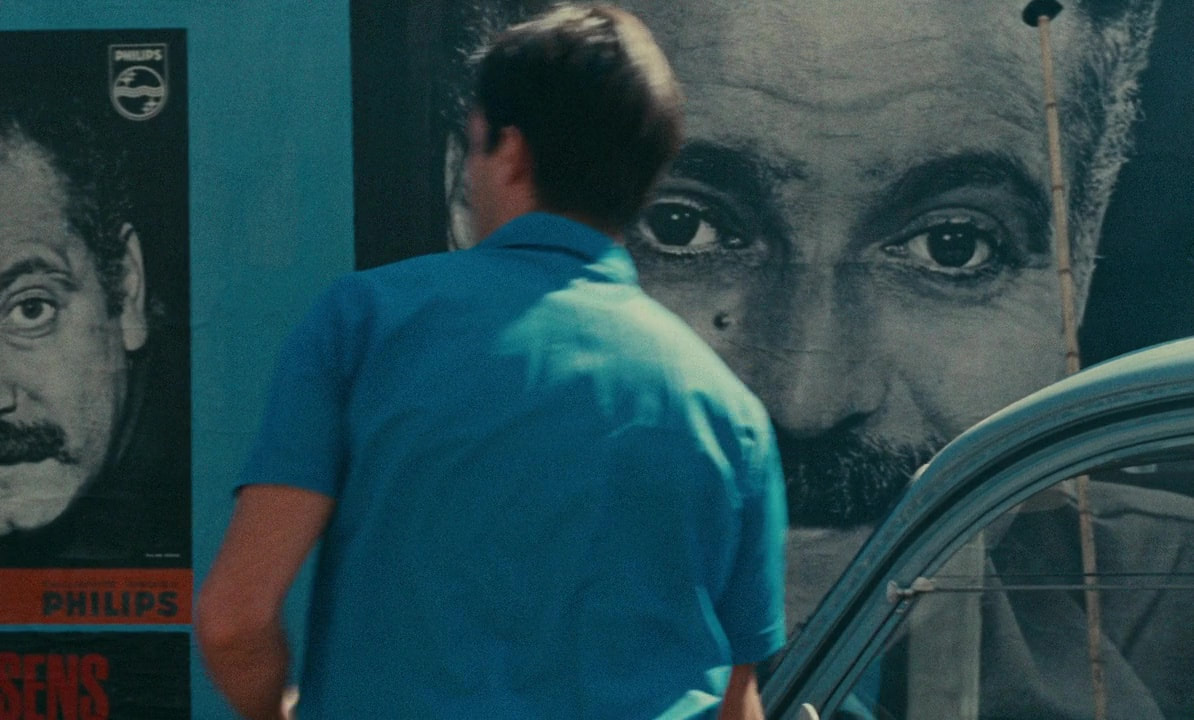places and pictures in Varda's Le Bonheur
1/ places
The big topographical opposition in the film is between the countryside and urban, or more exactly suburban, environments. Views of field and forest open and close the film:
Pattern is in play, of course, in these two images, with the reversed symmetry of the family group and the reversal of direction, towards then away from the camera.
Including these two bookends there are six rural sequences in the film. The second immediately follows the credit sequence but we know it is from a different time because François's shirt is green, rather than red:
Including these two bookends there are six rural sequences in the film. The second immediately follows the credit sequence but we know it is from a different time because François's shirt is green, rather than red:
The third sequence is a single shot panning back and forth. A water tower or a similar indistrial construction can just about be made out in the distance:
This sequence is followed by an enigmatic single shot of a rural view at sunset, with other industrial buildings in the distance. The people in the shot have no connection to the rest of the film, and this looks in fact like an insert from a quite different film entirely:
The fourth sequence is where Thérèse drowns, the lake being the same seen in the second sequence:
In the last two rural sequences Emilie has replaced Thérèse:
The approach by car through forest, here, resembles the departure through forest at the end of the second sequence, but I cannot say whether these sequences are shot in the same place. I would guess that all of these sequences are filmed in the same general area. The website for Varda'scompany Cine-Tamaris lists the following locations for the film: Fontenay-aux-Roses, L'Hay-les-Roses, Bagneux, Créteil, Mennecy, Varrières-le-Buisson. The lake looks like the marais de Mennecy, but it could also be the the lake in the forest of Verrières-le-Buisson.
The suburban settings are much easier to situate, though I haven't yet found which parts of the film are shot at Bagneux or L'Hay-les-Roses. The family lives at Fontenay-aux-Roses, 92 (Hauts-de-Seine), though I haven't yet located their house (see Appendix below).
The multiple views of Fontenay-aux-Roses amount to fragments of a documentary on life in suburbia, somewhat idealised but authentic in its ordinariness.
The multiple views of Fontenay-aux-Roses amount to fragments of a documentary on life in suburbia, somewhat idealised but authentic in its ordinariness.
The building into which Emilie moves is modern, but it is not presented as in conflict with the town's older urban fabric. That kind of distinction sets Fontenay as a whole against the Mont-Mesly estate in Créteil, the suburb where François's brother Joseph lives with his wife Madeleine. This location establishes the first dramatic contrast between the rural and the urban, as the family arrives there straight after the second sequence in the forest:
The Citroen 2CV comes down the Rue Jean Mermoz and turns into the Rue Juliette Savar. François points from the van towards where Joseph is watering the garden surrounding his house, and the camera pans to make the contrast between modern social housing and this vestige of banlieue pavillonnaire:
Contrasting the architecture of post-war suburban social housing with the individual homes of a pre-war suburban idyll is a recurrent trope in cinema of the period, New Wave and Old. The most dramatic instance is Henri Verneuil's Mélodie en Sous-sol (1963), where a single pre-war pavilion survives in the new town of Sarcelles:
The contrast is further thematised when François and family make a second visit to Joseph and Madeleine, to celebrate the birth of Paul's daughter Isabelle. In the garden the men and boys are building a playhouse, or more exactly a trappers' cabin, just for the boys:
The grand ensemble of Mont-Mesly surrounding the house and garden was itself still under construction in 1964 (building had begun in 1955). This site in the film is loaded with ironies: on their first visit the family have picked flowers in the forest to bring to Madeleine, but she says that there was no point indoing so since they have so many flowers in their garden, and so she gives Thérèse back her flowers. In effect she prefers natural products cultivated within a suburban environment to those gathered in the wild.
When the family arrived that first time Madeleine was watching Jean Renoir's Le Déjeuner sur l'herbe (1959) on television. Renoir's film is very much preoccupied with the imbrication of nature and culture, and though most of the extract shown features a discussion about the evolution of species, the origins of organic life, about happiness and the natural order, the last view of the television screen shows a view looking up into a tree. This shot is mimicked in the fourth of the rural excursions in Le Bonheur:
When the family arrived that first time Madeleine was watching Jean Renoir's Le Déjeuner sur l'herbe (1959) on television. Renoir's film is very much preoccupied with the imbrication of nature and culture, and though most of the extract shown features a discussion about the evolution of species, the origins of organic life, about happiness and the natural order, the last view of the television screen shows a view looking up into a tree. This shot is mimicked in the fourth of the rural excursions in Le Bonheur:
The reference to Renoir's nature-centred film can seem like theprivileging of nature over culture, but in this sequence, I would say, Varda's film favours culture, in the form of cine-specific manipulations. The television on which we see Renoir's film is in fact a unfeasible fake, showing a colour film when in 1964 that film could only have been seen on television in black-and-white:
|
The black-and-white still image of a couple on the tv set showing a couple in a colour moving picture that we should only be able to see in black-and-white turns Le Bonheur, briefly, into a history of visual media. That Varda's actor, Jean-Claude Drouot, was himself a star of television thanks to his rôle in the forest-set hit series Thierry la Fronde, adds to the complexity of these conjunctions.
|
Créteil, then, is very different from Fontenay-aux-Roses. The latter is also clearly different from Vincennes, the suburban town where François meets Emilie and from which she moves to Fontenay. Vincennes is also documented, also fragmentarily:
Vincennes is different because it has a substantial monument, the Château, in its centre. This is used as a backdrop for two still images where Emilie and François are imagined as a couple, with the want of focus signifying imagination:
Also associated with Vincennes is the Zoo which François passes on the way there, represented by views from the street and views of the animals (lions and some birds - pelican, ibis, flamingo):
Fontenay-aux-Roses, Créteil and Vincennes are the suburban focal points of the film's topography. Paris features only peripherally.
The statue of Athena at the Porte Dorée indicates a stage in François's journey to Vincennes:
The statue of Athena at the Porte Dorée indicates a stage in François's journey to Vincennes:
|
But the similarly golden statue of Thomas Paine that is inserted before that of Athena is topographically incorrect, since it is in the Parc Montsouris, nowhere near the Porte Dorée. Varda had already visited this park for a long sequence in Cléo de 5 à 7 (1962).
The park is, like the film's other Paris locations, peripheral; the statue is positioned by the fence overlooking the Boulevard Jourdan, opposite the Fondation des Etats-Unis in the Cité Universitaire. François's brother Paul lives on the Boulevard Poniatowski, no 33. This, the film's other Paris location, is also on this outer ring of Boulevards des Maréchaux, eastwards from the Parc Montsouris and across the river. Like the Porte Dorée it is close to the Paris side of the Bois de Vincennes.
|
Driving along the Boulevard Poniatowski François passes the Terminus café at no. 15.
There is one other urban location to be identified, the cemetery where Thérèse is buried:
2/ pictures
Varda herself has signalled the importance to her of Impressionist painting, and the influence is perhaps most obvious in the lakeside views:
The only specific allusion to Impressionism is the extract from Jean Renoir's Déjeuner sur l'herbe on the television. Though there are printed images throughout the film, it shows no reproductions of Impressionist paintings. There are paintings on three stamps examined at the post office - Georges Braque's 'Oiseau blanc' from 1962; an anonymous portrait of the French king Jean Le Bon, from before 1350; and Marc Chagall's 'Les Mariés de la Tour Eiffel' (1939):
|
Chagall's wedding picture is clearly linked to the film's narrative and themes. A voice-off, after it is said that the second stamp is of John the Good, asks if he was married to Anna the Good. This links passingly to the film's representations of marriage, but it also connects to the Chagall via Cocteau, in that 'Anna la Bonne' was a poem Cocteau composed in 1934, and the title of Chagall's painting alludes to Cocteau's 1921 ballet of the same name.
|
|
There is no explicit connection between Braque and Cocteau, as far as I know, other than that the two artists knew each other.
The Braque appears immediately after a view of pelicans in the Vincennes zoo, with a comment - 'what a beautiful bird' - sound-bridging the two shots. A postcard of the same Braque image can be seen in Guy Gilles's bedroom, in his film L'Amour à la mer (1963), right. |
There are no postcards of art on any walls in Le Bonheur; postcard-size images tend to be photographs. There are many paperbacks in various rooms but their visible covers tend not to feature recognisable art:
The Livre de Poche copy of Jean Giono's Que ma joie demeure above François and Thérèse's bed signifies for its title - 'may my joy last' - and the cover-illustration has its complement in this scene:
When Thérèse's books have been replaced by Emilie's books, the visible cover is of Turgenev's First Love, again pertinent because of the title, not the illustration:
The other books Emilie has placed above the bed are: Guy de Maupassant's Mademoiselle Fifi and Le Horla, Jean Giono's Un de Baumugnes, Georges Bernanos's Les Grands Cimetières sous la lune and Nouvelle histoire de Mouchette, Graham Greene's Brighton Rock, Kafka's The Trial, Vercors's Les Animaux dénaturés and Zola's La Faute de l'abbé Mouret.
The one clearly seen Livre de poche that features known art is Jacques Prévert's La Pluie et le Beau Temps, with a Brassai photograph of a graffiti-ed face on the cover:
Far more significant than the reproduction of art works is the contribution of commercial graphic art to the visual repertoire of Varda's film:
Kierran Argent Horner has discussed some aspects of this visuality in his 2018 essay 'The art of advertising happiness' (Studies in French Cinema 18.2), concluding that Le Bonheur is a Pop Art film. Horner also discusses the most evident visual intertext deployed throughout Varda's film, the photographic images of modern stars. These are concentrated in two spaces of the film, the workshop and Emilie's apartment. In the former, the first such image shown is a poster of Sylvie Vartan behind François as he works:
The poster is a variant of the poster used for Vartan's 1964 Olympia concerts, using a photograph by Jean-Marie Périer:
That Vartan is blonde connects her to the film's two blonde protagonists, and the daisy connects, obviously, to the film's dominant flower motif. The impact of this image is much diminished, however, as soon as the film looks more closely at the other photographs adorning the workshop.
At first sight they are appear as mere background décor, characteristic of this masculine milieu, but the film returns to examine them closely and, we may conclude, critically:
If, as I would contend, the aesthetic of Le Bonheur is collagist, this masculinist assemblage serves as ironic mise-en-abyme of Varda' collagist's practice.
|
The men have assembled thirteen images of minimally dressed women, nine of blondes and four of brunettes. They have also attached labels to two of them, identifying Jeanne Moreau and Brigitte Bardot. In the immediately preceding sequence François and Thérèse discuss the film Viva Maria, starring these two actresses, and Thérèse asks which of the two women François prefers.
Of the others there are two images of Mylène Demongeot and one, I think, of Anna Karina. The two black-and-white images are I think of Marilyn Monroe, but it is very hard to tell. |
The semi-undress of the women in these photographs is superseded by the more complete nudity Varda stages in sex scenes featuring François and Thérèse, and then above all between François and Emilie. In Emilie's apartment there is also an arrangement of photographs, but whereas those in the workshop appear to be all of film actresses, except for the Sylvie Vartan poster, Emilie's collection features both film and pop stars, both men and women:
Left to right: a woman I can't identify; Sacha Distel on the cover of his 1964 disk 'Je sais que je t'aime'; six men and women in a field - my guess is that this is Les Surfs, a Malgache pop group; Marilyn Monroe from Something's Got To Give (1962), her uncompleted last film; Brigitte Bardot from Le Mépris (1963); the singer Hugues Aufray, I think; Sylvie Vartan; Jean-Paul Belmondo.
Emilie has a record player, and around it are a picture of François HArdy (I think) and several E,P.s, including Sylvie Vartan's 'Sha La La', Guy Béart's 'Tangos' and Jacques Brel's 'Les Toros':
Some time before the appearance of contemporary pop stars, the image of singer Georges Brassens loomed on posters in Vincennes:
The range of contemporary singers who figure in some way in Le Bonheur runs from established chansonniers like Brassens, whose first L.P. was in 1952, to the rising yé-yé star Sylvie Vartan, with a first L.P. in 1962. The more recent end of the scale has its place on the soundtrack, via the yé-yé song heard on the radio in the workshop. The film can be said to identify the more strongly with the pop end of this scale, since that song, 'Les mariés yé-yé', was co-written by Varda for the film. Under her original name, Arlette Varda, she is credited as auteur of the song on her own web-page related to le Bonheur:
